Dividend Growth and Firm Valuation
VerifiedAdded on 2020/05/16
|42
|13724
|303
AI Summary
The assignment delves into the Dividend Growth Model, a method used to value companies based on their future dividends. It examines the theoretical underpinnings of the model, its practical application in assessing firm worth, and explores key factors that shape corporate dividend policies. The analysis draws upon academic research and real-world examples to illustrate the concepts and demonstrate the model's significance in investment decision-making.
Contribute Materials
Your contribution can guide someone’s learning journey. Share your
documents today.
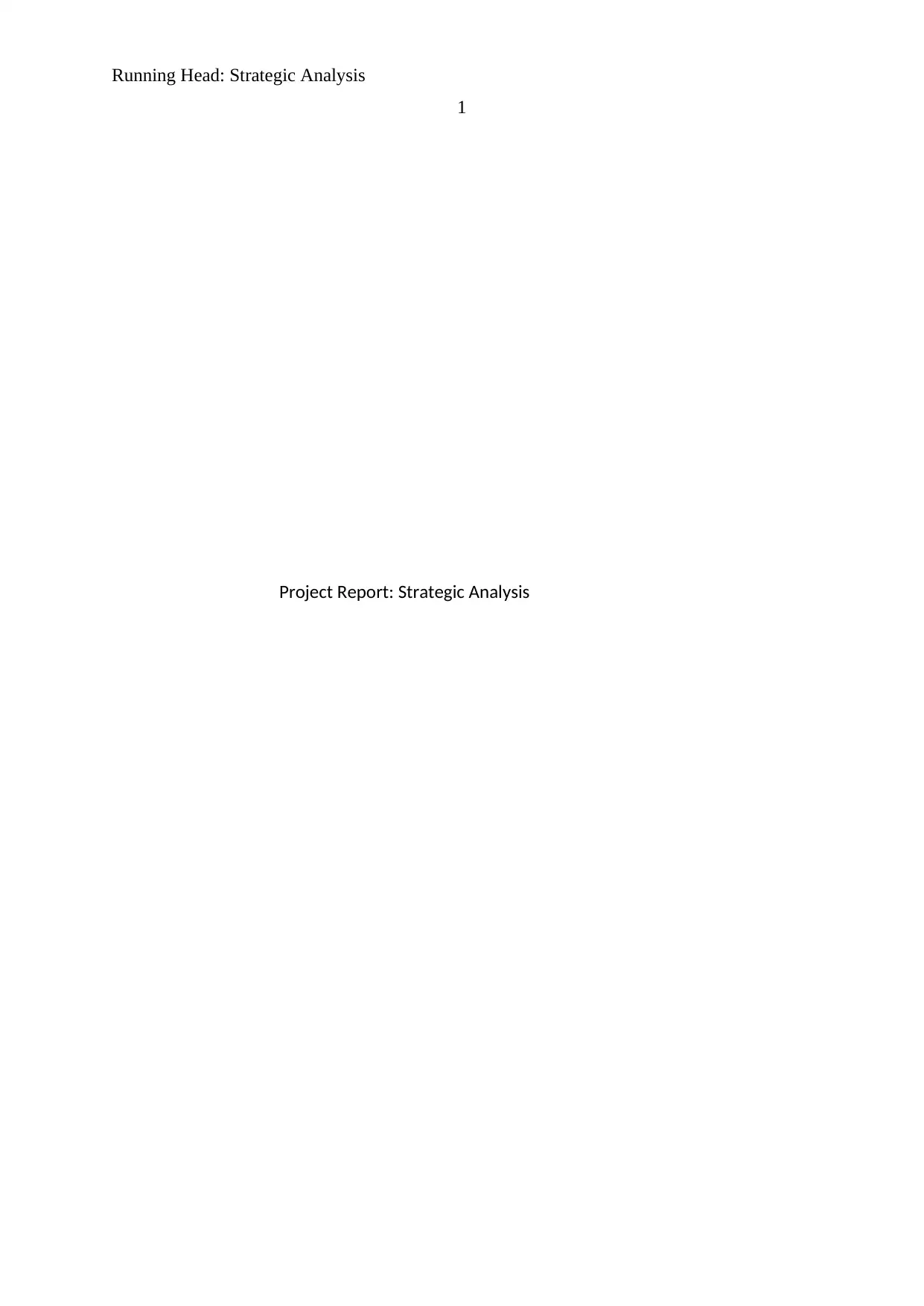
Running Head: Strategic Analysis
1
Project Report: Strategic Analysis
1
Project Report: Strategic Analysis
Secure Best Marks with AI Grader
Need help grading? Try our AI Grader for instant feedback on your assignments.
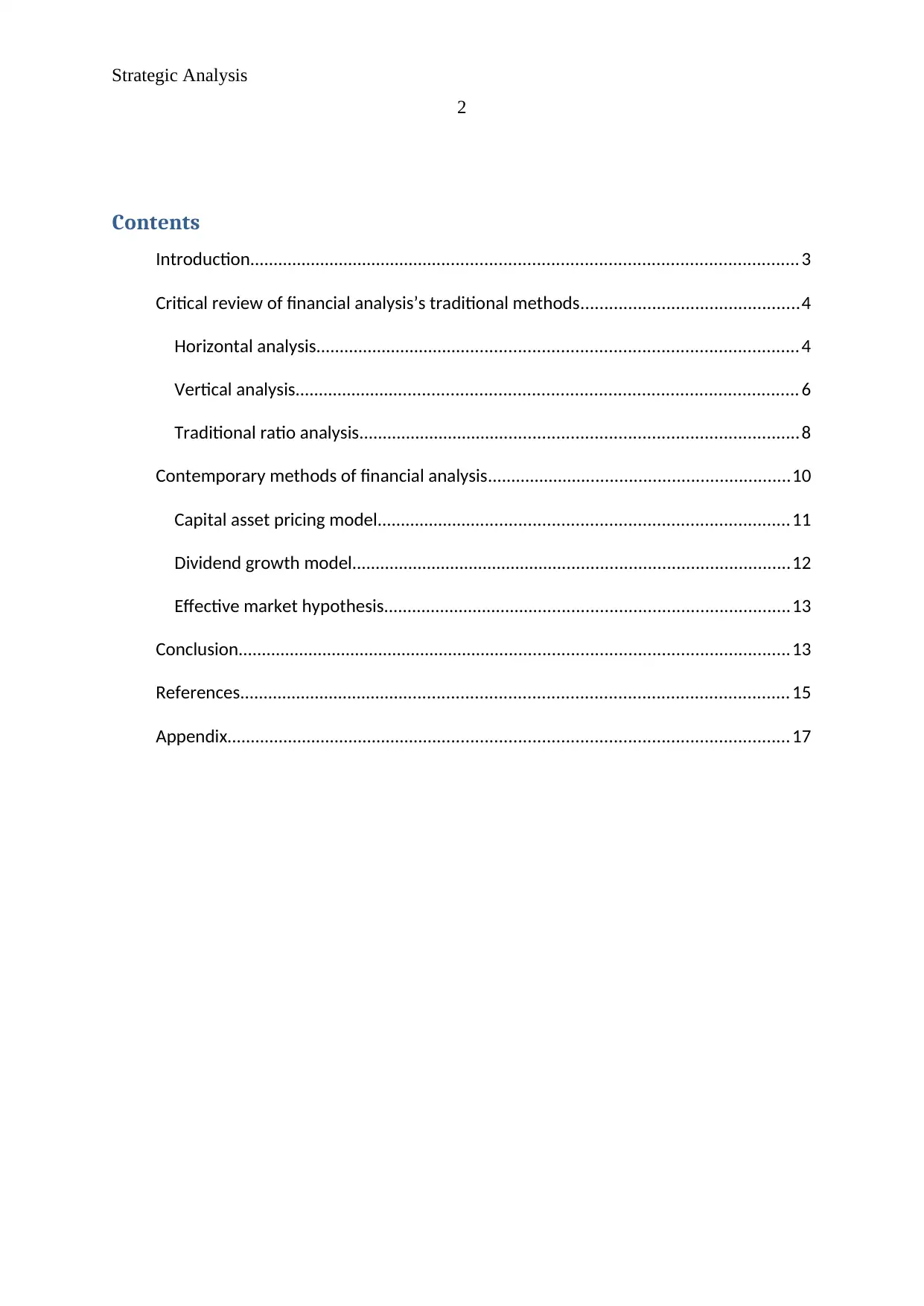
Strategic Analysis
2
Contents
Introduction.................................................................................................................... 3
Critical review of financial analysis’s traditional methods..............................................4
Horizontal analysis......................................................................................................4
Vertical analysis.......................................................................................................... 6
Traditional ratio analysis.............................................................................................8
Contemporary methods of financial analysis................................................................10
Capital asset pricing model.......................................................................................11
Dividend growth model.............................................................................................12
Effective market hypothesis......................................................................................13
Conclusion.....................................................................................................................13
References.................................................................................................................... 15
Appendix....................................................................................................................... 17
2
Contents
Introduction.................................................................................................................... 3
Critical review of financial analysis’s traditional methods..............................................4
Horizontal analysis......................................................................................................4
Vertical analysis.......................................................................................................... 6
Traditional ratio analysis.............................................................................................8
Contemporary methods of financial analysis................................................................10
Capital asset pricing model.......................................................................................11
Dividend growth model.............................................................................................12
Effective market hypothesis......................................................................................13
Conclusion.....................................................................................................................13
References.................................................................................................................... 15
Appendix....................................................................................................................... 17
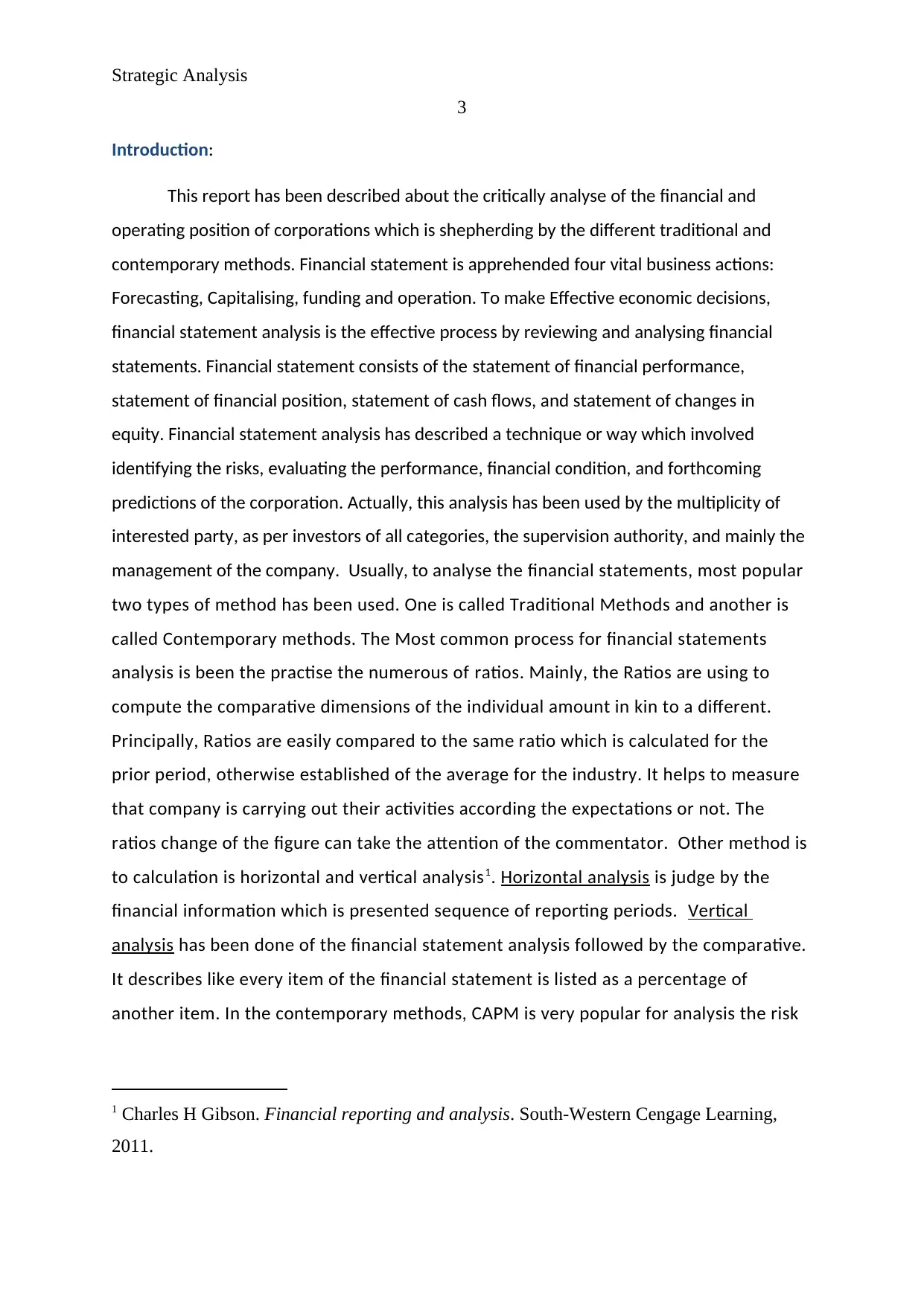
Strategic Analysis
3
Introduction:
This report has been described about the critically analyse of the financial and
operating position of corporations which is shepherding by the different traditional and
contemporary methods. Financial statement is apprehended four vital business actions:
Forecasting, Capitalising, funding and operation. To make Effective economic decisions,
financial statement analysis is the effective process by reviewing and analysing financial
statements. Financial statement consists of the statement of financial performance,
statement of financial position, statement of cash flows, and statement of changes in
equity. Financial statement analysis has described a technique or way which involved
identifying the risks, evaluating the performance, financial condition, and forthcoming
predictions of the corporation. Actually, this analysis has been used by the multiplicity of
interested party, as per investors of all categories, the supervision authority, and mainly the
management of the company. Usually, to analyse the financial statements, most popular
two types of method has been used. One is called Traditional Methods and another is
called Contemporary methods. The Most common process for financial statements
analysis is been the practise the numerous of ratios. Mainly, the Ratios are using to
compute the comparative dimensions of the individual amount in kin to a different.
Principally, Ratios are easily compared to the same ratio which is calculated for the
prior period, otherwise established of the average for the industry. It helps to measure
that company is carrying out their activities according the expectations or not. The
ratios change of the figure can take the attention of the commentator. Other method is
to calculation is horizontal and vertical analysis1. Horizontal analysis is judge by the
financial information which is presented sequence of reporting periods. Vertical
analysis has been done of the financial statement analysis followed by the comparative.
It describes like every item of the financial statement is listed as a percentage of
another item. In the contemporary methods, CAPM is very popular for analysis the risk
1 Charles H Gibson. Financial reporting and analysis. South-Western Cengage Learning,
2011.
3
Introduction:
This report has been described about the critically analyse of the financial and
operating position of corporations which is shepherding by the different traditional and
contemporary methods. Financial statement is apprehended four vital business actions:
Forecasting, Capitalising, funding and operation. To make Effective economic decisions,
financial statement analysis is the effective process by reviewing and analysing financial
statements. Financial statement consists of the statement of financial performance,
statement of financial position, statement of cash flows, and statement of changes in
equity. Financial statement analysis has described a technique or way which involved
identifying the risks, evaluating the performance, financial condition, and forthcoming
predictions of the corporation. Actually, this analysis has been used by the multiplicity of
interested party, as per investors of all categories, the supervision authority, and mainly the
management of the company. Usually, to analyse the financial statements, most popular
two types of method has been used. One is called Traditional Methods and another is
called Contemporary methods. The Most common process for financial statements
analysis is been the practise the numerous of ratios. Mainly, the Ratios are using to
compute the comparative dimensions of the individual amount in kin to a different.
Principally, Ratios are easily compared to the same ratio which is calculated for the
prior period, otherwise established of the average for the industry. It helps to measure
that company is carrying out their activities according the expectations or not. The
ratios change of the figure can take the attention of the commentator. Other method is
to calculation is horizontal and vertical analysis1. Horizontal analysis is judge by the
financial information which is presented sequence of reporting periods. Vertical
analysis has been done of the financial statement analysis followed by the comparative.
It describes like every item of the financial statement is listed as a percentage of
another item. In the contemporary methods, CAPM is very popular for analysis the risk
1 Charles H Gibson. Financial reporting and analysis. South-Western Cengage Learning,
2011.
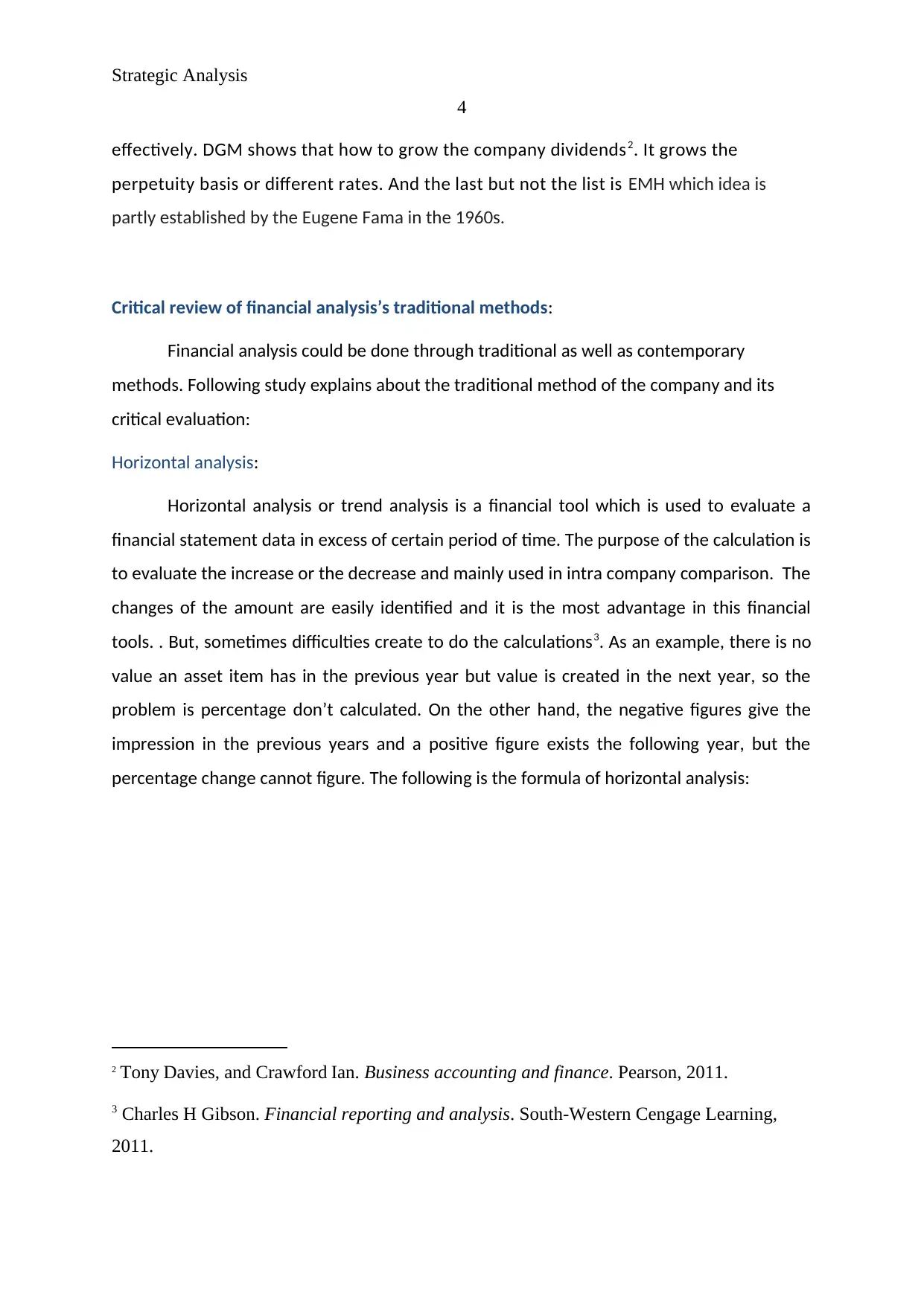
Strategic Analysis
4
effectively. DGM shows that how to grow the company dividends2. It grows the
perpetuity basis or different rates. And the last but not the list is EMH which idea is
partly established by the Eugene Fama in the 1960s.
Critical review of financial analysis’s traditional methods:
Financial analysis could be done through traditional as well as contemporary
methods. Following study explains about the traditional method of the company and its
critical evaluation:
Horizontal analysis:
Horizontal analysis or trend analysis is a financial tool which is used to evaluate a
financial statement data in excess of certain period of time. The purpose of the calculation is
to evaluate the increase or the decrease and mainly used in intra company comparison. The
changes of the amount are easily identified and it is the most advantage in this financial
tools. . But, sometimes difficulties create to do the calculations3. As an example, there is no
value an asset item has in the previous year but value is created in the next year, so the
problem is percentage don’t calculated. On the other hand, the negative figures give the
impression in the previous years and a positive figure exists the following year, but the
percentage change cannot figure. The following is the formula of horizontal analysis:
2 Tony Davies, and Crawford Ian. Business accounting and finance. Pearson, 2011.
3 Charles H Gibson. Financial reporting and analysis. South-Western Cengage Learning,
2011.
4
effectively. DGM shows that how to grow the company dividends2. It grows the
perpetuity basis or different rates. And the last but not the list is EMH which idea is
partly established by the Eugene Fama in the 1960s.
Critical review of financial analysis’s traditional methods:
Financial analysis could be done through traditional as well as contemporary
methods. Following study explains about the traditional method of the company and its
critical evaluation:
Horizontal analysis:
Horizontal analysis or trend analysis is a financial tool which is used to evaluate a
financial statement data in excess of certain period of time. The purpose of the calculation is
to evaluate the increase or the decrease and mainly used in intra company comparison. The
changes of the amount are easily identified and it is the most advantage in this financial
tools. . But, sometimes difficulties create to do the calculations3. As an example, there is no
value an asset item has in the previous year but value is created in the next year, so the
problem is percentage don’t calculated. On the other hand, the negative figures give the
impression in the previous years and a positive figure exists the following year, but the
percentage change cannot figure. The following is the formula of horizontal analysis:
2 Tony Davies, and Crawford Ian. Business accounting and finance. Pearson, 2011.
3 Charles H Gibson. Financial reporting and analysis. South-Western Cengage Learning,
2011.
Secure Best Marks with AI Grader
Need help grading? Try our AI Grader for instant feedback on your assignments.
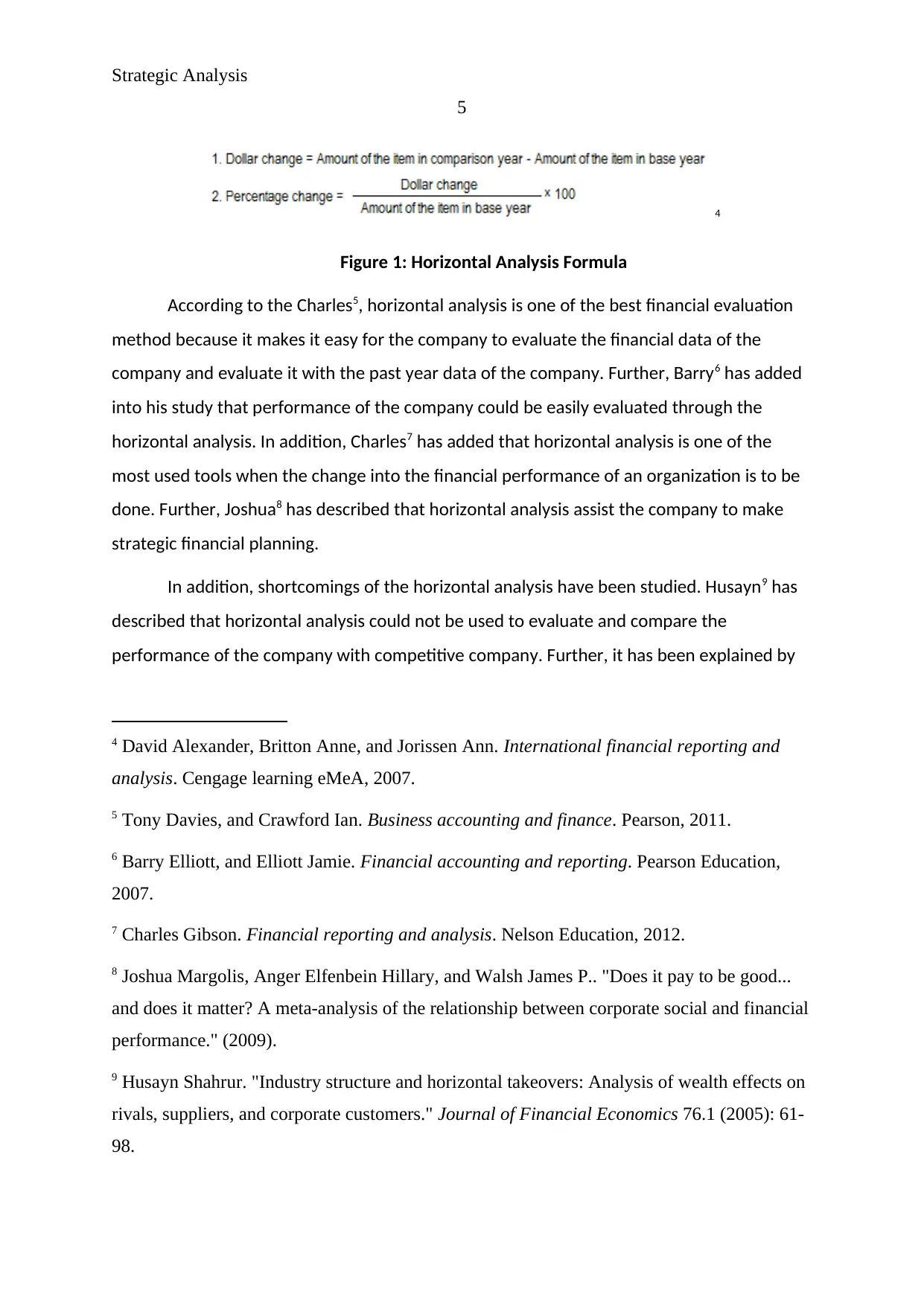
Strategic Analysis
5
4
Figure 1: Horizontal Analysis Formula
According to the Charles5, horizontal analysis is one of the best financial evaluation
method because it makes it easy for the company to evaluate the financial data of the
company and evaluate it with the past year data of the company. Further, Barry6 has added
into his study that performance of the company could be easily evaluated through the
horizontal analysis. In addition, Charles7 has added that horizontal analysis is one of the
most used tools when the change into the financial performance of an organization is to be
done. Further, Joshua8 has described that horizontal analysis assist the company to make
strategic financial planning.
In addition, shortcomings of the horizontal analysis have been studied. Husayn9 has
described that horizontal analysis could not be used to evaluate and compare the
performance of the company with competitive company. Further, it has been explained by
4 David Alexander, Britton Anne, and Jorissen Ann. International financial reporting and
analysis. Cengage learning eMeA, 2007.
5 Tony Davies, and Crawford Ian. Business accounting and finance. Pearson, 2011.
6 Barry Elliott, and Elliott Jamie. Financial accounting and reporting. Pearson Education,
2007.
7 Charles Gibson. Financial reporting and analysis. Nelson Education, 2012.
8 Joshua Margolis, Anger Elfenbein Hillary, and Walsh James P.. "Does it pay to be good...
and does it matter? A meta-analysis of the relationship between corporate social and financial
performance." (2009).
9 Husayn Shahrur. "Industry structure and horizontal takeovers: Analysis of wealth effects on
rivals, suppliers, and corporate customers." Journal of Financial Economics 76.1 (2005): 61-
98.
5
4
Figure 1: Horizontal Analysis Formula
According to the Charles5, horizontal analysis is one of the best financial evaluation
method because it makes it easy for the company to evaluate the financial data of the
company and evaluate it with the past year data of the company. Further, Barry6 has added
into his study that performance of the company could be easily evaluated through the
horizontal analysis. In addition, Charles7 has added that horizontal analysis is one of the
most used tools when the change into the financial performance of an organization is to be
done. Further, Joshua8 has described that horizontal analysis assist the company to make
strategic financial planning.
In addition, shortcomings of the horizontal analysis have been studied. Husayn9 has
described that horizontal analysis could not be used to evaluate and compare the
performance of the company with competitive company. Further, it has been explained by
4 David Alexander, Britton Anne, and Jorissen Ann. International financial reporting and
analysis. Cengage learning eMeA, 2007.
5 Tony Davies, and Crawford Ian. Business accounting and finance. Pearson, 2011.
6 Barry Elliott, and Elliott Jamie. Financial accounting and reporting. Pearson Education,
2007.
7 Charles Gibson. Financial reporting and analysis. Nelson Education, 2012.
8 Joshua Margolis, Anger Elfenbein Hillary, and Walsh James P.. "Does it pay to be good...
and does it matter? A meta-analysis of the relationship between corporate social and financial
performance." (2009).
9 Husayn Shahrur. "Industry structure and horizontal takeovers: Analysis of wealth effects on
rivals, suppliers, and corporate customers." Journal of Financial Economics 76.1 (2005): 61-
98.
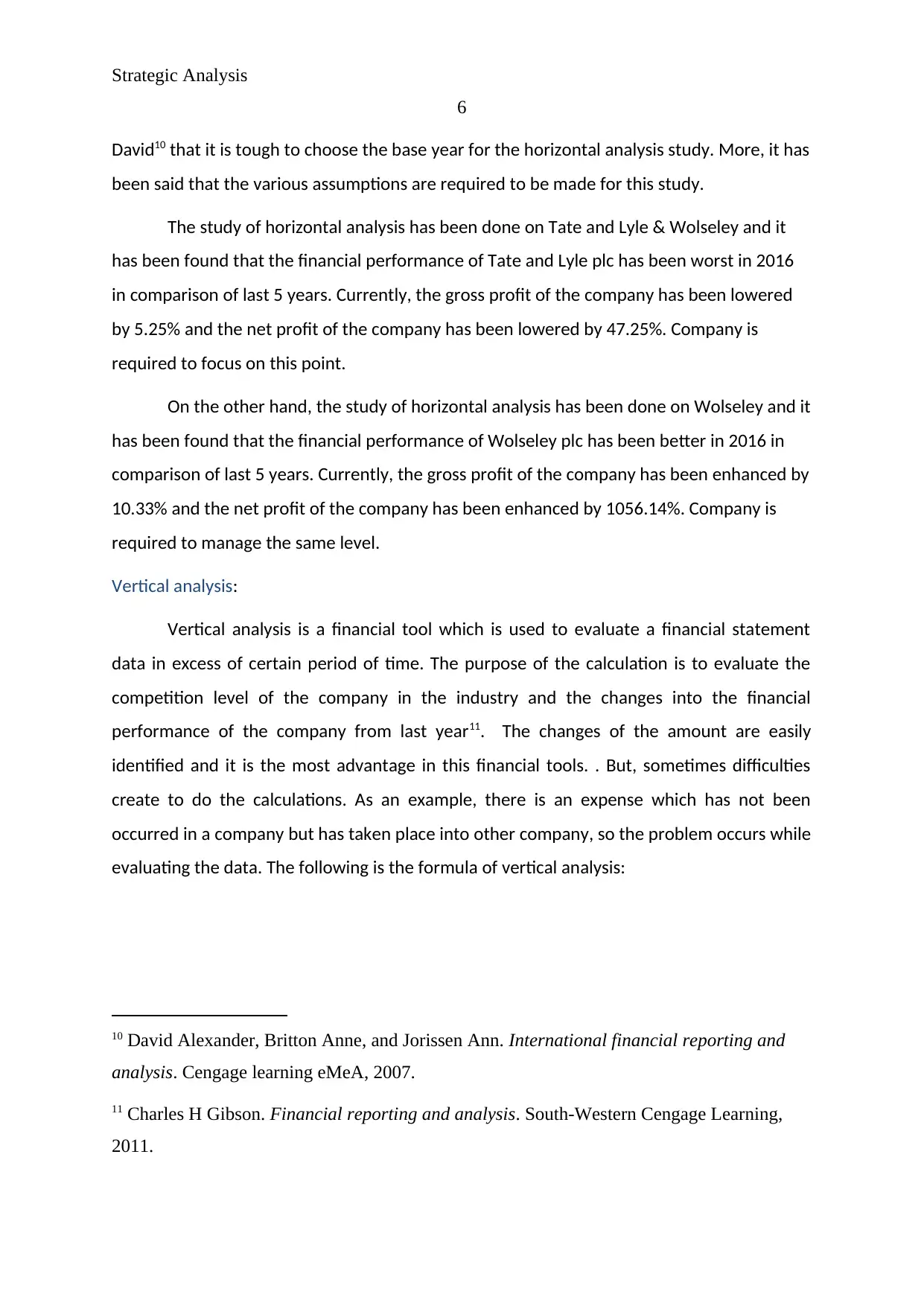
Strategic Analysis
6
David10 that it is tough to choose the base year for the horizontal analysis study. More, it has
been said that the various assumptions are required to be made for this study.
The study of horizontal analysis has been done on Tate and Lyle & Wolseley and it
has been found that the financial performance of Tate and Lyle plc has been worst in 2016
in comparison of last 5 years. Currently, the gross profit of the company has been lowered
by 5.25% and the net profit of the company has been lowered by 47.25%. Company is
required to focus on this point.
On the other hand, the study of horizontal analysis has been done on Wolseley and it
has been found that the financial performance of Wolseley plc has been better in 2016 in
comparison of last 5 years. Currently, the gross profit of the company has been enhanced by
10.33% and the net profit of the company has been enhanced by 1056.14%. Company is
required to manage the same level.
Vertical analysis:
Vertical analysis is a financial tool which is used to evaluate a financial statement
data in excess of certain period of time. The purpose of the calculation is to evaluate the
competition level of the company in the industry and the changes into the financial
performance of the company from last year11. The changes of the amount are easily
identified and it is the most advantage in this financial tools. . But, sometimes difficulties
create to do the calculations. As an example, there is an expense which has not been
occurred in a company but has taken place into other company, so the problem occurs while
evaluating the data. The following is the formula of vertical analysis:
10 David Alexander, Britton Anne, and Jorissen Ann. International financial reporting and
analysis. Cengage learning eMeA, 2007.
11 Charles H Gibson. Financial reporting and analysis. South-Western Cengage Learning,
2011.
6
David10 that it is tough to choose the base year for the horizontal analysis study. More, it has
been said that the various assumptions are required to be made for this study.
The study of horizontal analysis has been done on Tate and Lyle & Wolseley and it
has been found that the financial performance of Tate and Lyle plc has been worst in 2016
in comparison of last 5 years. Currently, the gross profit of the company has been lowered
by 5.25% and the net profit of the company has been lowered by 47.25%. Company is
required to focus on this point.
On the other hand, the study of horizontal analysis has been done on Wolseley and it
has been found that the financial performance of Wolseley plc has been better in 2016 in
comparison of last 5 years. Currently, the gross profit of the company has been enhanced by
10.33% and the net profit of the company has been enhanced by 1056.14%. Company is
required to manage the same level.
Vertical analysis:
Vertical analysis is a financial tool which is used to evaluate a financial statement
data in excess of certain period of time. The purpose of the calculation is to evaluate the
competition level of the company in the industry and the changes into the financial
performance of the company from last year11. The changes of the amount are easily
identified and it is the most advantage in this financial tools. . But, sometimes difficulties
create to do the calculations. As an example, there is an expense which has not been
occurred in a company but has taken place into other company, so the problem occurs while
evaluating the data. The following is the formula of vertical analysis:
10 David Alexander, Britton Anne, and Jorissen Ann. International financial reporting and
analysis. Cengage learning eMeA, 2007.
11 Charles H Gibson. Financial reporting and analysis. South-Western Cengage Learning,
2011.
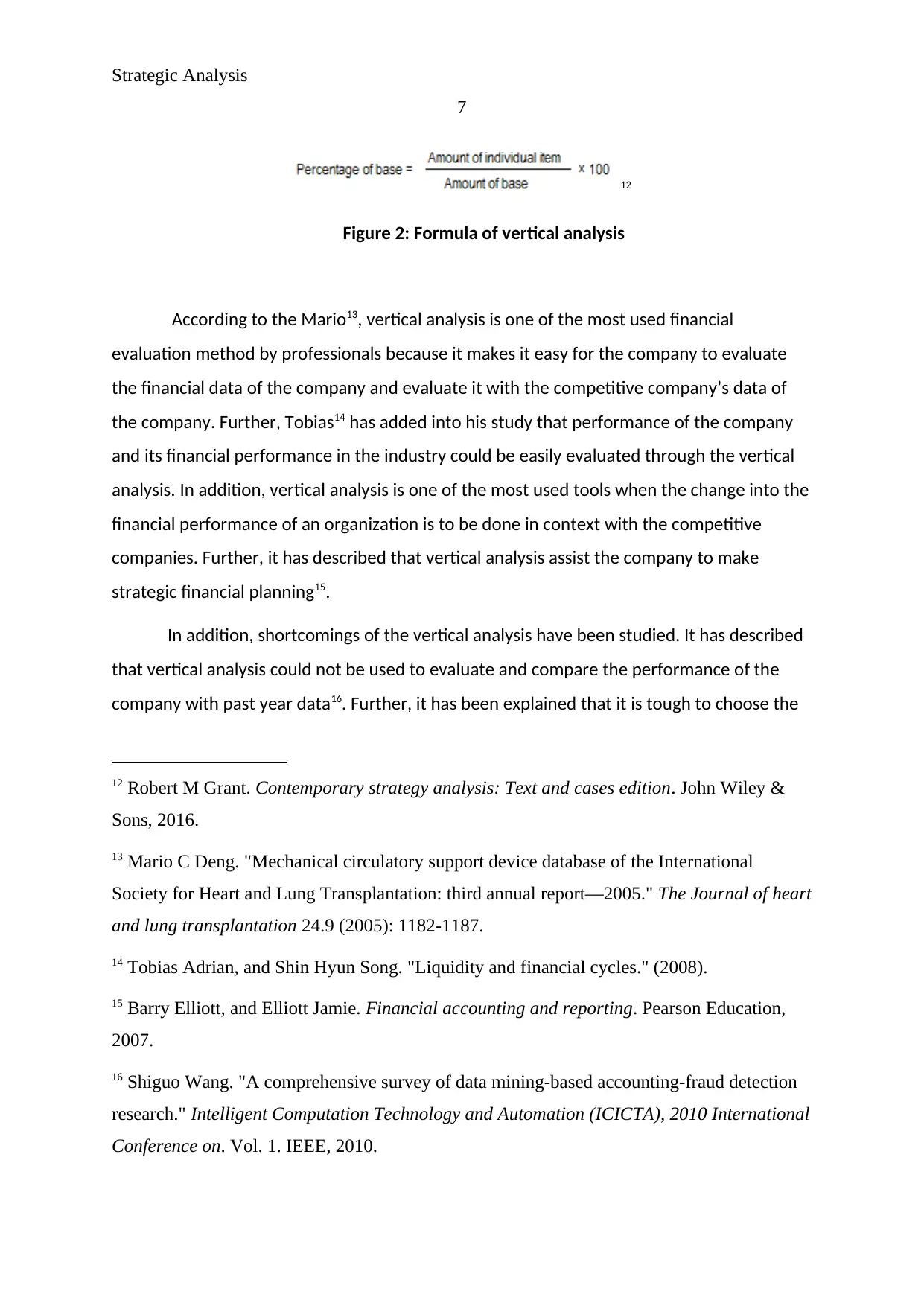
Strategic Analysis
7
12
Figure 2: Formula of vertical analysis
According to the Mario13, vertical analysis is one of the most used financial
evaluation method by professionals because it makes it easy for the company to evaluate
the financial data of the company and evaluate it with the competitive company’s data of
the company. Further, Tobias14 has added into his study that performance of the company
and its financial performance in the industry could be easily evaluated through the vertical
analysis. In addition, vertical analysis is one of the most used tools when the change into the
financial performance of an organization is to be done in context with the competitive
companies. Further, it has described that vertical analysis assist the company to make
strategic financial planning15.
In addition, shortcomings of the vertical analysis have been studied. It has described
that vertical analysis could not be used to evaluate and compare the performance of the
company with past year data16. Further, it has been explained that it is tough to choose the
12 Robert M Grant. Contemporary strategy analysis: Text and cases edition. John Wiley &
Sons, 2016.
13 Mario C Deng. "Mechanical circulatory support device database of the International
Society for Heart and Lung Transplantation: third annual report—2005." The Journal of heart
and lung transplantation 24.9 (2005): 1182-1187.
14 Tobias Adrian, and Shin Hyun Song. "Liquidity and financial cycles." (2008).
15 Barry Elliott, and Elliott Jamie. Financial accounting and reporting. Pearson Education,
2007.
16 Shiguo Wang. "A comprehensive survey of data mining-based accounting-fraud detection
research." Intelligent Computation Technology and Automation (ICICTA), 2010 International
Conference on. Vol. 1. IEEE, 2010.
7
12
Figure 2: Formula of vertical analysis
According to the Mario13, vertical analysis is one of the most used financial
evaluation method by professionals because it makes it easy for the company to evaluate
the financial data of the company and evaluate it with the competitive company’s data of
the company. Further, Tobias14 has added into his study that performance of the company
and its financial performance in the industry could be easily evaluated through the vertical
analysis. In addition, vertical analysis is one of the most used tools when the change into the
financial performance of an organization is to be done in context with the competitive
companies. Further, it has described that vertical analysis assist the company to make
strategic financial planning15.
In addition, shortcomings of the vertical analysis have been studied. It has described
that vertical analysis could not be used to evaluate and compare the performance of the
company with past year data16. Further, it has been explained that it is tough to choose the
12 Robert M Grant. Contemporary strategy analysis: Text and cases edition. John Wiley &
Sons, 2016.
13 Mario C Deng. "Mechanical circulatory support device database of the International
Society for Heart and Lung Transplantation: third annual report—2005." The Journal of heart
and lung transplantation 24.9 (2005): 1182-1187.
14 Tobias Adrian, and Shin Hyun Song. "Liquidity and financial cycles." (2008).
15 Barry Elliott, and Elliott Jamie. Financial accounting and reporting. Pearson Education,
2007.
16 Shiguo Wang. "A comprehensive survey of data mining-based accounting-fraud detection
research." Intelligent Computation Technology and Automation (ICICTA), 2010 International
Conference on. Vol. 1. IEEE, 2010.
Paraphrase This Document
Need a fresh take? Get an instant paraphrase of this document with our AI Paraphraser
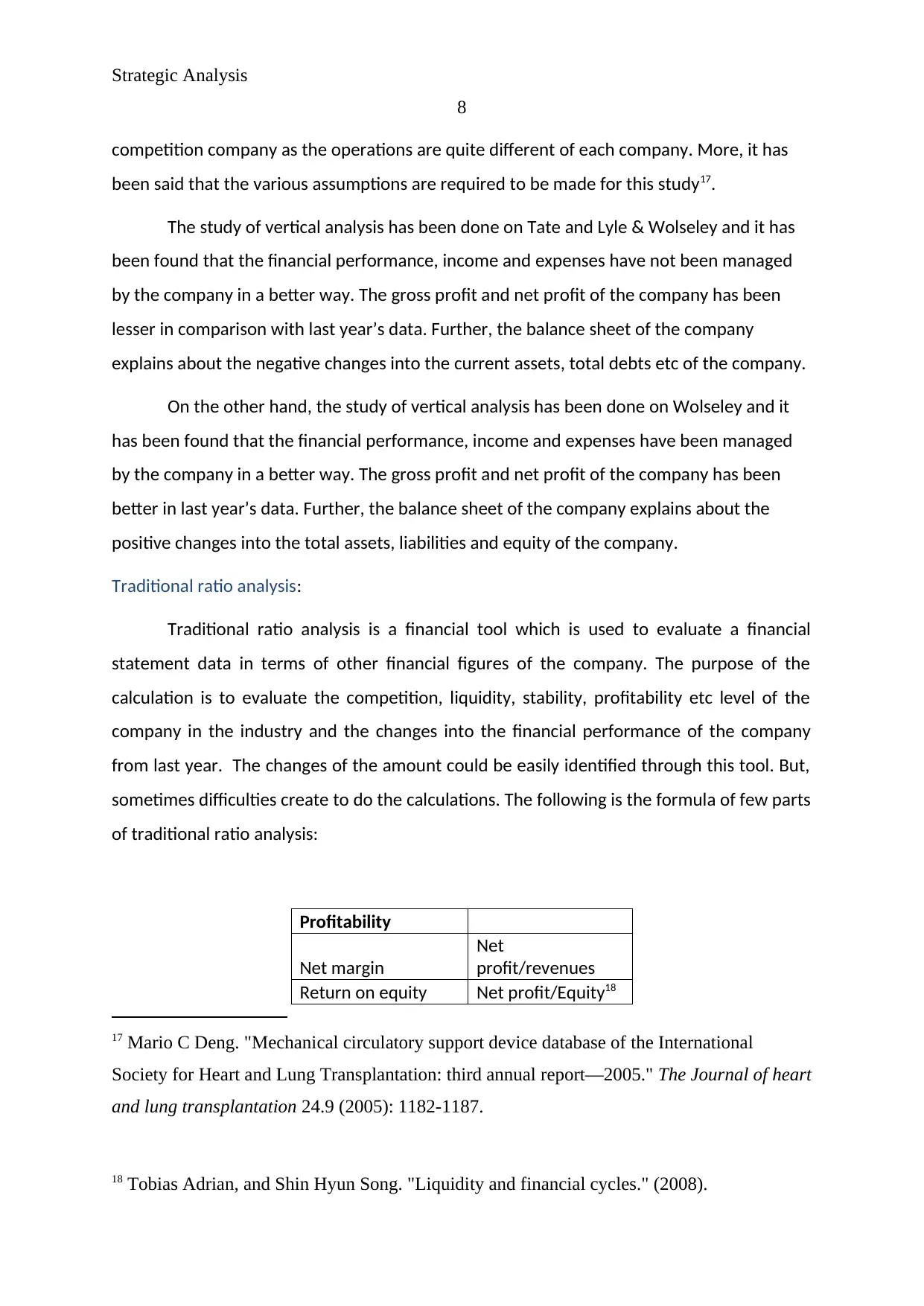
Strategic Analysis
8
competition company as the operations are quite different of each company. More, it has
been said that the various assumptions are required to be made for this study17.
The study of vertical analysis has been done on Tate and Lyle & Wolseley and it has
been found that the financial performance, income and expenses have not been managed
by the company in a better way. The gross profit and net profit of the company has been
lesser in comparison with last year’s data. Further, the balance sheet of the company
explains about the negative changes into the current assets, total debts etc of the company.
On the other hand, the study of vertical analysis has been done on Wolseley and it
has been found that the financial performance, income and expenses have been managed
by the company in a better way. The gross profit and net profit of the company has been
better in last year’s data. Further, the balance sheet of the company explains about the
positive changes into the total assets, liabilities and equity of the company.
Traditional ratio analysis:
Traditional ratio analysis is a financial tool which is used to evaluate a financial
statement data in terms of other financial figures of the company. The purpose of the
calculation is to evaluate the competition, liquidity, stability, profitability etc level of the
company in the industry and the changes into the financial performance of the company
from last year. The changes of the amount could be easily identified through this tool. But,
sometimes difficulties create to do the calculations. The following is the formula of few parts
of traditional ratio analysis:
Profitability
Net margin
Net
profit/revenues
Return on equity Net profit/Equity18
17 Mario C Deng. "Mechanical circulatory support device database of the International
Society for Heart and Lung Transplantation: third annual report—2005." The Journal of heart
and lung transplantation 24.9 (2005): 1182-1187.
18 Tobias Adrian, and Shin Hyun Song. "Liquidity and financial cycles." (2008).
8
competition company as the operations are quite different of each company. More, it has
been said that the various assumptions are required to be made for this study17.
The study of vertical analysis has been done on Tate and Lyle & Wolseley and it has
been found that the financial performance, income and expenses have not been managed
by the company in a better way. The gross profit and net profit of the company has been
lesser in comparison with last year’s data. Further, the balance sheet of the company
explains about the negative changes into the current assets, total debts etc of the company.
On the other hand, the study of vertical analysis has been done on Wolseley and it
has been found that the financial performance, income and expenses have been managed
by the company in a better way. The gross profit and net profit of the company has been
better in last year’s data. Further, the balance sheet of the company explains about the
positive changes into the total assets, liabilities and equity of the company.
Traditional ratio analysis:
Traditional ratio analysis is a financial tool which is used to evaluate a financial
statement data in terms of other financial figures of the company. The purpose of the
calculation is to evaluate the competition, liquidity, stability, profitability etc level of the
company in the industry and the changes into the financial performance of the company
from last year. The changes of the amount could be easily identified through this tool. But,
sometimes difficulties create to do the calculations. The following is the formula of few parts
of traditional ratio analysis:
Profitability
Net margin
Net
profit/revenues
Return on equity Net profit/Equity18
17 Mario C Deng. "Mechanical circulatory support device database of the International
Society for Heart and Lung Transplantation: third annual report—2005." The Journal of heart
and lung transplantation 24.9 (2005): 1182-1187.
18 Tobias Adrian, and Shin Hyun Song. "Liquidity and financial cycles." (2008).
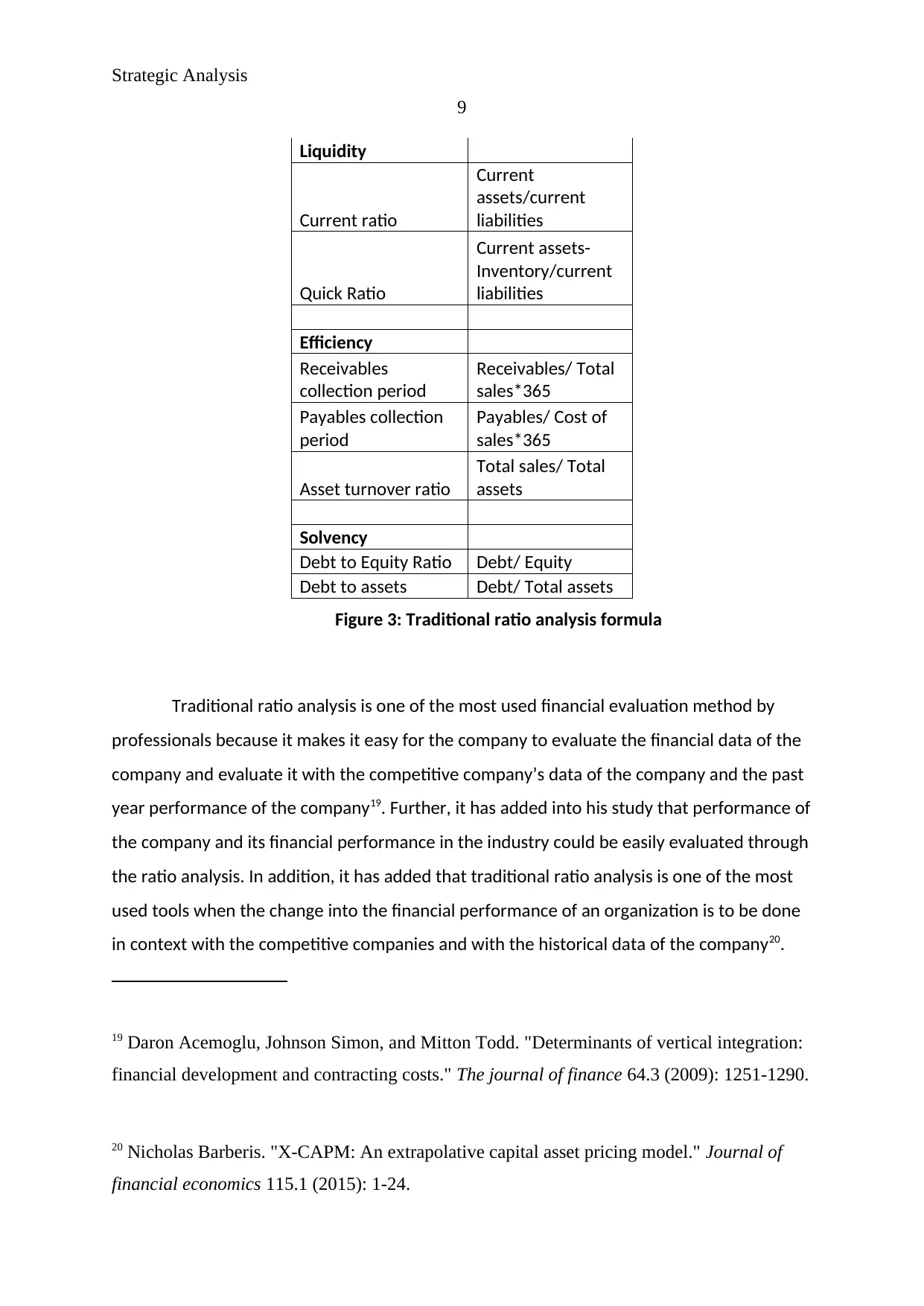
Strategic Analysis
9
Liquidity
Current ratio
Current
assets/current
liabilities
Quick Ratio
Current assets-
Inventory/current
liabilities
Efficiency
Receivables
collection period
Receivables/ Total
sales*365
Payables collection
period
Payables/ Cost of
sales*365
Asset turnover ratio
Total sales/ Total
assets
Solvency
Debt to Equity Ratio Debt/ Equity
Debt to assets Debt/ Total assets
Figure 3: Traditional ratio analysis formula
Traditional ratio analysis is one of the most used financial evaluation method by
professionals because it makes it easy for the company to evaluate the financial data of the
company and evaluate it with the competitive company’s data of the company and the past
year performance of the company19. Further, it has added into his study that performance of
the company and its financial performance in the industry could be easily evaluated through
the ratio analysis. In addition, it has added that traditional ratio analysis is one of the most
used tools when the change into the financial performance of an organization is to be done
in context with the competitive companies and with the historical data of the company20.
19 Daron Acemoglu, Johnson Simon, and Mitton Todd. "Determinants of vertical integration:
financial development and contracting costs." The journal of finance 64.3 (2009): 1251-1290.
20 Nicholas Barberis. "X-CAPM: An extrapolative capital asset pricing model." Journal of
financial economics 115.1 (2015): 1-24.
9
Liquidity
Current ratio
Current
assets/current
liabilities
Quick Ratio
Current assets-
Inventory/current
liabilities
Efficiency
Receivables
collection period
Receivables/ Total
sales*365
Payables collection
period
Payables/ Cost of
sales*365
Asset turnover ratio
Total sales/ Total
assets
Solvency
Debt to Equity Ratio Debt/ Equity
Debt to assets Debt/ Total assets
Figure 3: Traditional ratio analysis formula
Traditional ratio analysis is one of the most used financial evaluation method by
professionals because it makes it easy for the company to evaluate the financial data of the
company and evaluate it with the competitive company’s data of the company and the past
year performance of the company19. Further, it has added into his study that performance of
the company and its financial performance in the industry could be easily evaluated through
the ratio analysis. In addition, it has added that traditional ratio analysis is one of the most
used tools when the change into the financial performance of an organization is to be done
in context with the competitive companies and with the historical data of the company20.
19 Daron Acemoglu, Johnson Simon, and Mitton Todd. "Determinants of vertical integration:
financial development and contracting costs." The journal of finance 64.3 (2009): 1251-1290.
20 Nicholas Barberis. "X-CAPM: An extrapolative capital asset pricing model." Journal of
financial economics 115.1 (2015): 1-24.
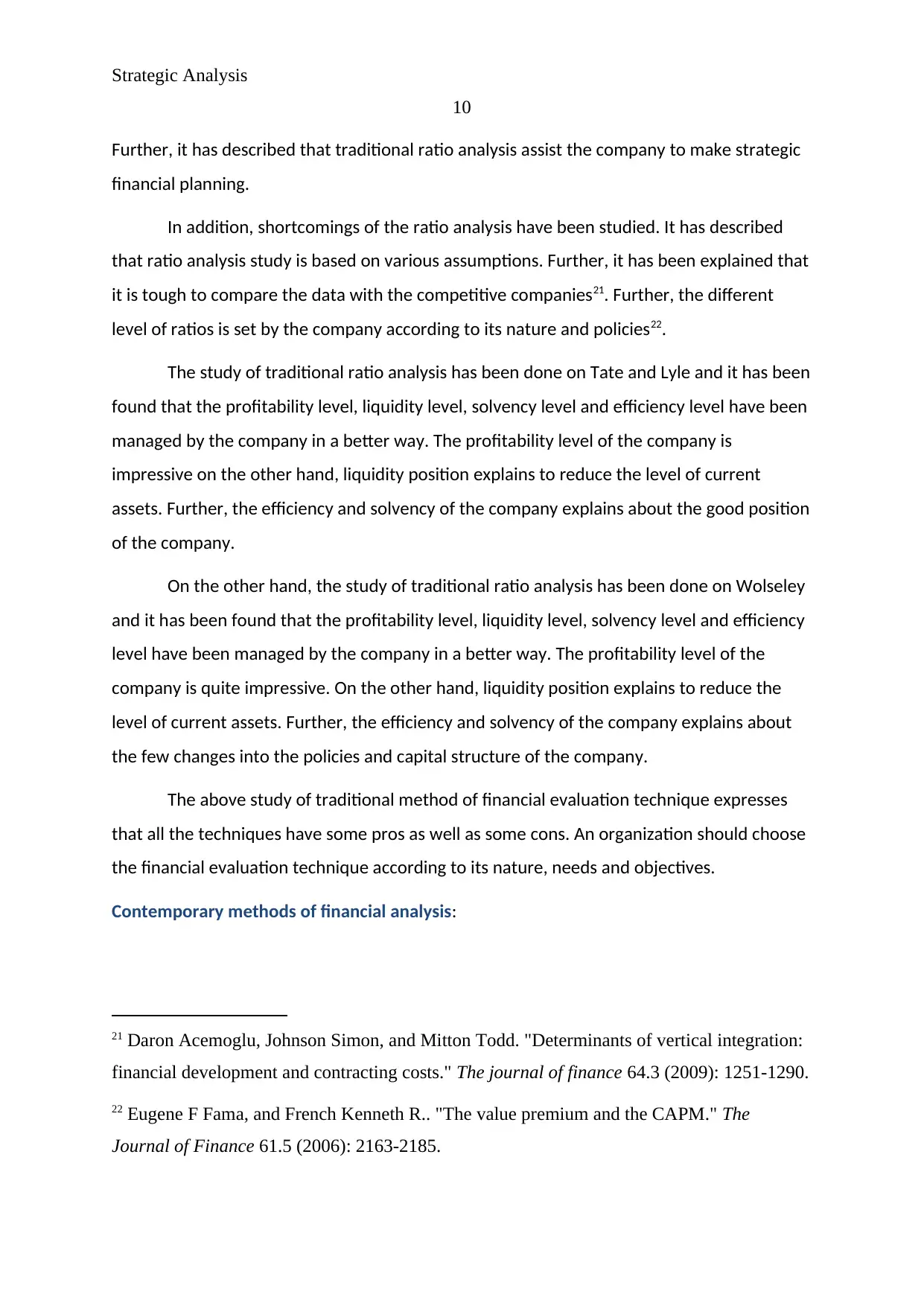
Strategic Analysis
10
Further, it has described that traditional ratio analysis assist the company to make strategic
financial planning.
In addition, shortcomings of the ratio analysis have been studied. It has described
that ratio analysis study is based on various assumptions. Further, it has been explained that
it is tough to compare the data with the competitive companies21. Further, the different
level of ratios is set by the company according to its nature and policies22.
The study of traditional ratio analysis has been done on Tate and Lyle and it has been
found that the profitability level, liquidity level, solvency level and efficiency level have been
managed by the company in a better way. The profitability level of the company is
impressive on the other hand, liquidity position explains to reduce the level of current
assets. Further, the efficiency and solvency of the company explains about the good position
of the company.
On the other hand, the study of traditional ratio analysis has been done on Wolseley
and it has been found that the profitability level, liquidity level, solvency level and efficiency
level have been managed by the company in a better way. The profitability level of the
company is quite impressive. On the other hand, liquidity position explains to reduce the
level of current assets. Further, the efficiency and solvency of the company explains about
the few changes into the policies and capital structure of the company.
The above study of traditional method of financial evaluation technique expresses
that all the techniques have some pros as well as some cons. An organization should choose
the financial evaluation technique according to its nature, needs and objectives.
Contemporary methods of financial analysis:
21 Daron Acemoglu, Johnson Simon, and Mitton Todd. "Determinants of vertical integration:
financial development and contracting costs." The journal of finance 64.3 (2009): 1251-1290.
22 Eugene F Fama, and French Kenneth R.. "The value premium and the CAPM." The
Journal of Finance 61.5 (2006): 2163-2185.
10
Further, it has described that traditional ratio analysis assist the company to make strategic
financial planning.
In addition, shortcomings of the ratio analysis have been studied. It has described
that ratio analysis study is based on various assumptions. Further, it has been explained that
it is tough to compare the data with the competitive companies21. Further, the different
level of ratios is set by the company according to its nature and policies22.
The study of traditional ratio analysis has been done on Tate and Lyle and it has been
found that the profitability level, liquidity level, solvency level and efficiency level have been
managed by the company in a better way. The profitability level of the company is
impressive on the other hand, liquidity position explains to reduce the level of current
assets. Further, the efficiency and solvency of the company explains about the good position
of the company.
On the other hand, the study of traditional ratio analysis has been done on Wolseley
and it has been found that the profitability level, liquidity level, solvency level and efficiency
level have been managed by the company in a better way. The profitability level of the
company is quite impressive. On the other hand, liquidity position explains to reduce the
level of current assets. Further, the efficiency and solvency of the company explains about
the few changes into the policies and capital structure of the company.
The above study of traditional method of financial evaluation technique expresses
that all the techniques have some pros as well as some cons. An organization should choose
the financial evaluation technique according to its nature, needs and objectives.
Contemporary methods of financial analysis:
21 Daron Acemoglu, Johnson Simon, and Mitton Todd. "Determinants of vertical integration:
financial development and contracting costs." The journal of finance 64.3 (2009): 1251-1290.
22 Eugene F Fama, and French Kenneth R.. "The value premium and the CAPM." The
Journal of Finance 61.5 (2006): 2163-2185.
Secure Best Marks with AI Grader
Need help grading? Try our AI Grader for instant feedback on your assignments.
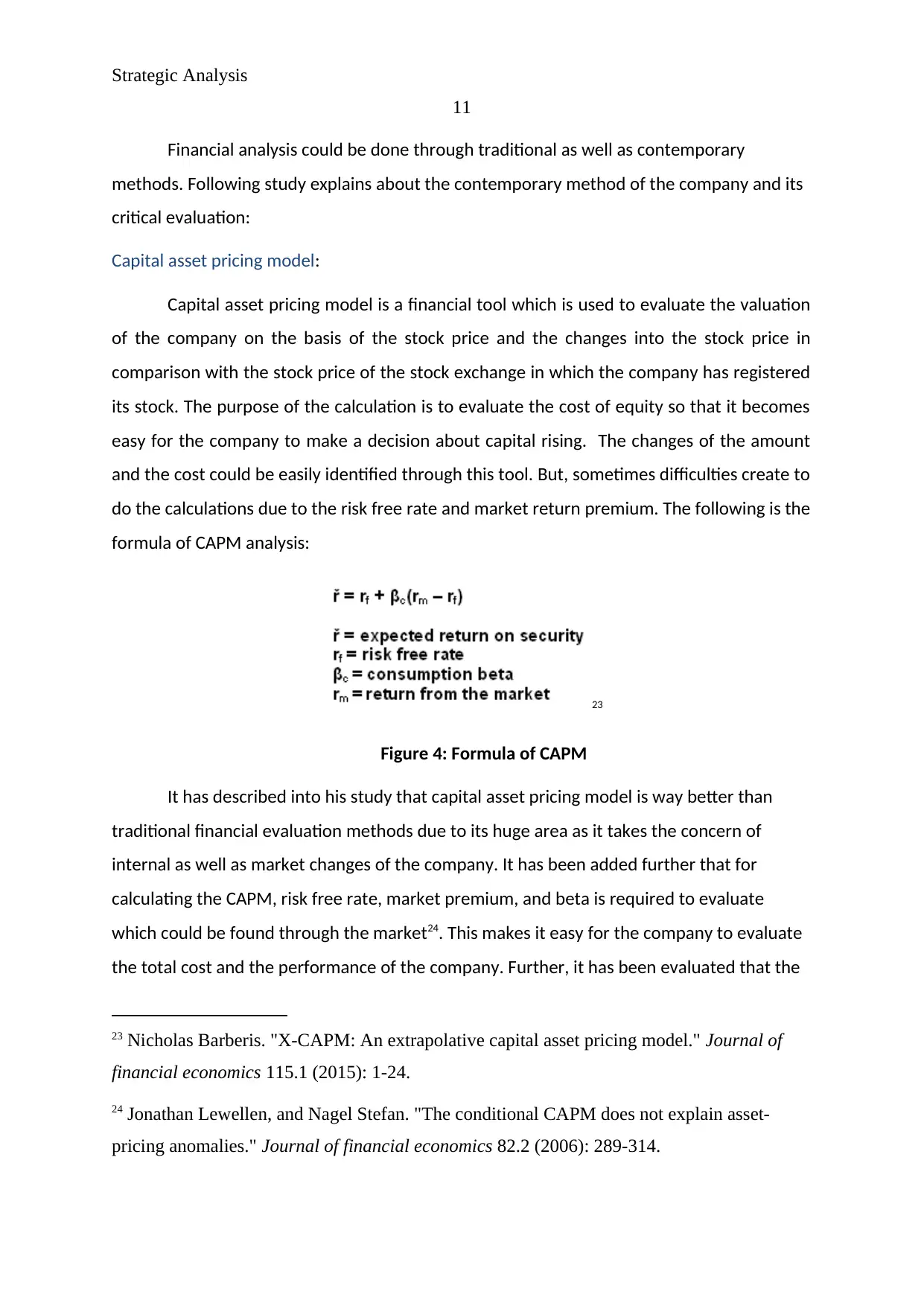
Strategic Analysis
11
Financial analysis could be done through traditional as well as contemporary
methods. Following study explains about the contemporary method of the company and its
critical evaluation:
Capital asset pricing model:
Capital asset pricing model is a financial tool which is used to evaluate the valuation
of the company on the basis of the stock price and the changes into the stock price in
comparison with the stock price of the stock exchange in which the company has registered
its stock. The purpose of the calculation is to evaluate the cost of equity so that it becomes
easy for the company to make a decision about capital rising. The changes of the amount
and the cost could be easily identified through this tool. But, sometimes difficulties create to
do the calculations due to the risk free rate and market return premium. The following is the
formula of CAPM analysis:
23
Figure 4: Formula of CAPM
It has described into his study that capital asset pricing model is way better than
traditional financial evaluation methods due to its huge area as it takes the concern of
internal as well as market changes of the company. It has been added further that for
calculating the CAPM, risk free rate, market premium, and beta is required to evaluate
which could be found through the market24. This makes it easy for the company to evaluate
the total cost and the performance of the company. Further, it has been evaluated that the
23 Nicholas Barberis. "X-CAPM: An extrapolative capital asset pricing model." Journal of
financial economics 115.1 (2015): 1-24.
24 Jonathan Lewellen, and Nagel Stefan. "The conditional CAPM does not explain asset-
pricing anomalies." Journal of financial economics 82.2 (2006): 289-314.
11
Financial analysis could be done through traditional as well as contemporary
methods. Following study explains about the contemporary method of the company and its
critical evaluation:
Capital asset pricing model:
Capital asset pricing model is a financial tool which is used to evaluate the valuation
of the company on the basis of the stock price and the changes into the stock price in
comparison with the stock price of the stock exchange in which the company has registered
its stock. The purpose of the calculation is to evaluate the cost of equity so that it becomes
easy for the company to make a decision about capital rising. The changes of the amount
and the cost could be easily identified through this tool. But, sometimes difficulties create to
do the calculations due to the risk free rate and market return premium. The following is the
formula of CAPM analysis:
23
Figure 4: Formula of CAPM
It has described into his study that capital asset pricing model is way better than
traditional financial evaluation methods due to its huge area as it takes the concern of
internal as well as market changes of the company. It has been added further that for
calculating the CAPM, risk free rate, market premium, and beta is required to evaluate
which could be found through the market24. This makes it easy for the company to evaluate
the total cost and the performance of the company. Further, it has been evaluated that the
23 Nicholas Barberis. "X-CAPM: An extrapolative capital asset pricing model." Journal of
financial economics 115.1 (2015): 1-24.
24 Jonathan Lewellen, and Nagel Stefan. "The conditional CAPM does not explain asset-
pricing anomalies." Journal of financial economics 82.2 (2006): 289-314.
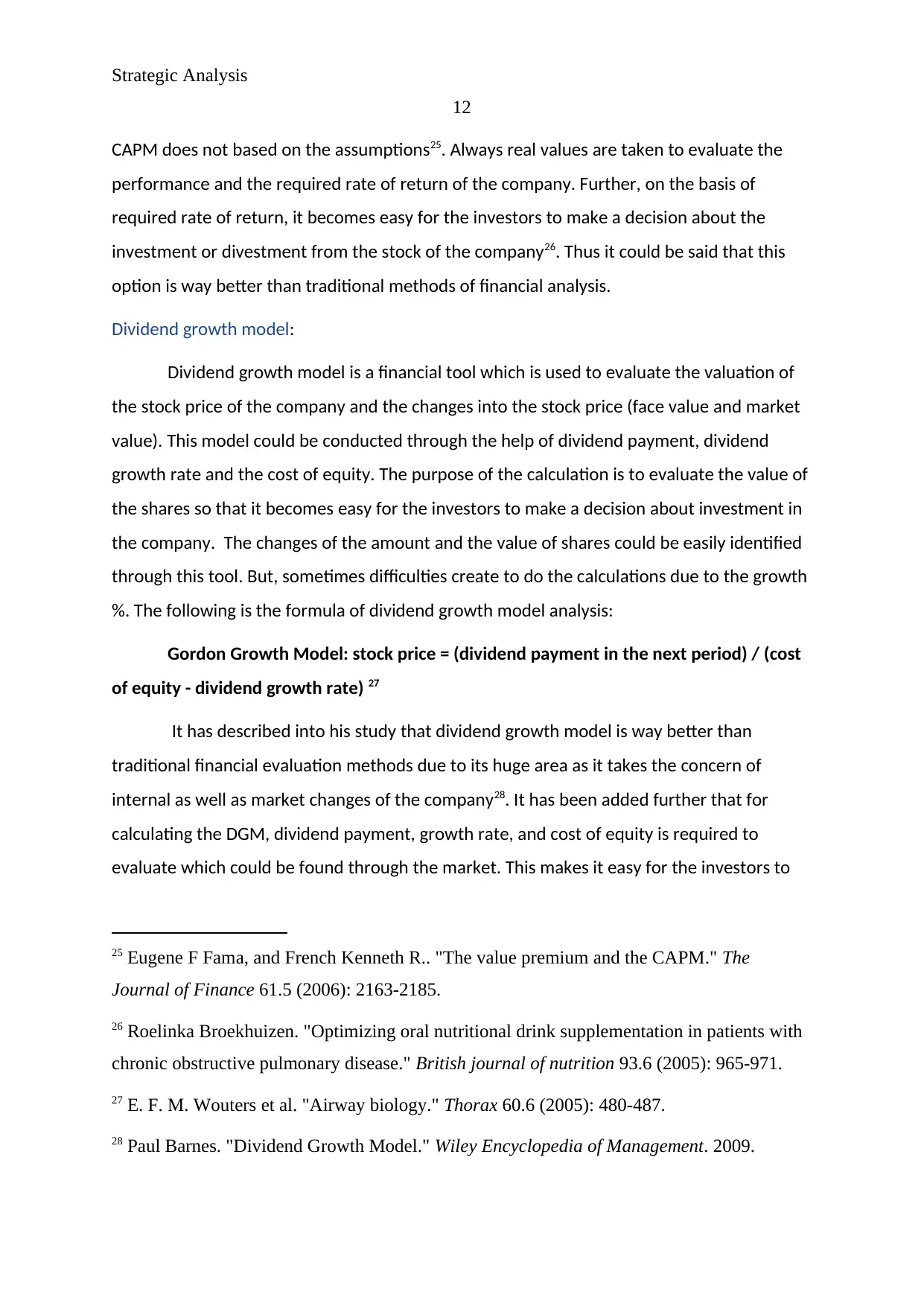
Strategic Analysis
12
CAPM does not based on the assumptions25. Always real values are taken to evaluate the
performance and the required rate of return of the company. Further, on the basis of
required rate of return, it becomes easy for the investors to make a decision about the
investment or divestment from the stock of the company26. Thus it could be said that this
option is way better than traditional methods of financial analysis.
Dividend growth model:
Dividend growth model is a financial tool which is used to evaluate the valuation of
the stock price of the company and the changes into the stock price (face value and market
value). This model could be conducted through the help of dividend payment, dividend
growth rate and the cost of equity. The purpose of the calculation is to evaluate the value of
the shares so that it becomes easy for the investors to make a decision about investment in
the company. The changes of the amount and the value of shares could be easily identified
through this tool. But, sometimes difficulties create to do the calculations due to the growth
%. The following is the formula of dividend growth model analysis:
Gordon Growth Model: stock price = (dividend payment in the next period) / (cost
of equity - dividend growth rate) 27
It has described into his study that dividend growth model is way better than
traditional financial evaluation methods due to its huge area as it takes the concern of
internal as well as market changes of the company28. It has been added further that for
calculating the DGM, dividend payment, growth rate, and cost of equity is required to
evaluate which could be found through the market. This makes it easy for the investors to
25 Eugene F Fama, and French Kenneth R.. "The value premium and the CAPM." The
Journal of Finance 61.5 (2006): 2163-2185.
26 Roelinka Broekhuizen. "Optimizing oral nutritional drink supplementation in patients with
chronic obstructive pulmonary disease." British journal of nutrition 93.6 (2005): 965-971.
27 E. F. M. Wouters et al. "Airway biology." Thorax 60.6 (2005): 480-487.
28 Paul Barnes. "Dividend Growth Model." Wiley Encyclopedia of Management. 2009.
12
CAPM does not based on the assumptions25. Always real values are taken to evaluate the
performance and the required rate of return of the company. Further, on the basis of
required rate of return, it becomes easy for the investors to make a decision about the
investment or divestment from the stock of the company26. Thus it could be said that this
option is way better than traditional methods of financial analysis.
Dividend growth model:
Dividend growth model is a financial tool which is used to evaluate the valuation of
the stock price of the company and the changes into the stock price (face value and market
value). This model could be conducted through the help of dividend payment, dividend
growth rate and the cost of equity. The purpose of the calculation is to evaluate the value of
the shares so that it becomes easy for the investors to make a decision about investment in
the company. The changes of the amount and the value of shares could be easily identified
through this tool. But, sometimes difficulties create to do the calculations due to the growth
%. The following is the formula of dividend growth model analysis:
Gordon Growth Model: stock price = (dividend payment in the next period) / (cost
of equity - dividend growth rate) 27
It has described into his study that dividend growth model is way better than
traditional financial evaluation methods due to its huge area as it takes the concern of
internal as well as market changes of the company28. It has been added further that for
calculating the DGM, dividend payment, growth rate, and cost of equity is required to
evaluate which could be found through the market. This makes it easy for the investors to
25 Eugene F Fama, and French Kenneth R.. "The value premium and the CAPM." The
Journal of Finance 61.5 (2006): 2163-2185.
26 Roelinka Broekhuizen. "Optimizing oral nutritional drink supplementation in patients with
chronic obstructive pulmonary disease." British journal of nutrition 93.6 (2005): 965-971.
27 E. F. M. Wouters et al. "Airway biology." Thorax 60.6 (2005): 480-487.
28 Paul Barnes. "Dividend Growth Model." Wiley Encyclopedia of Management. 2009.
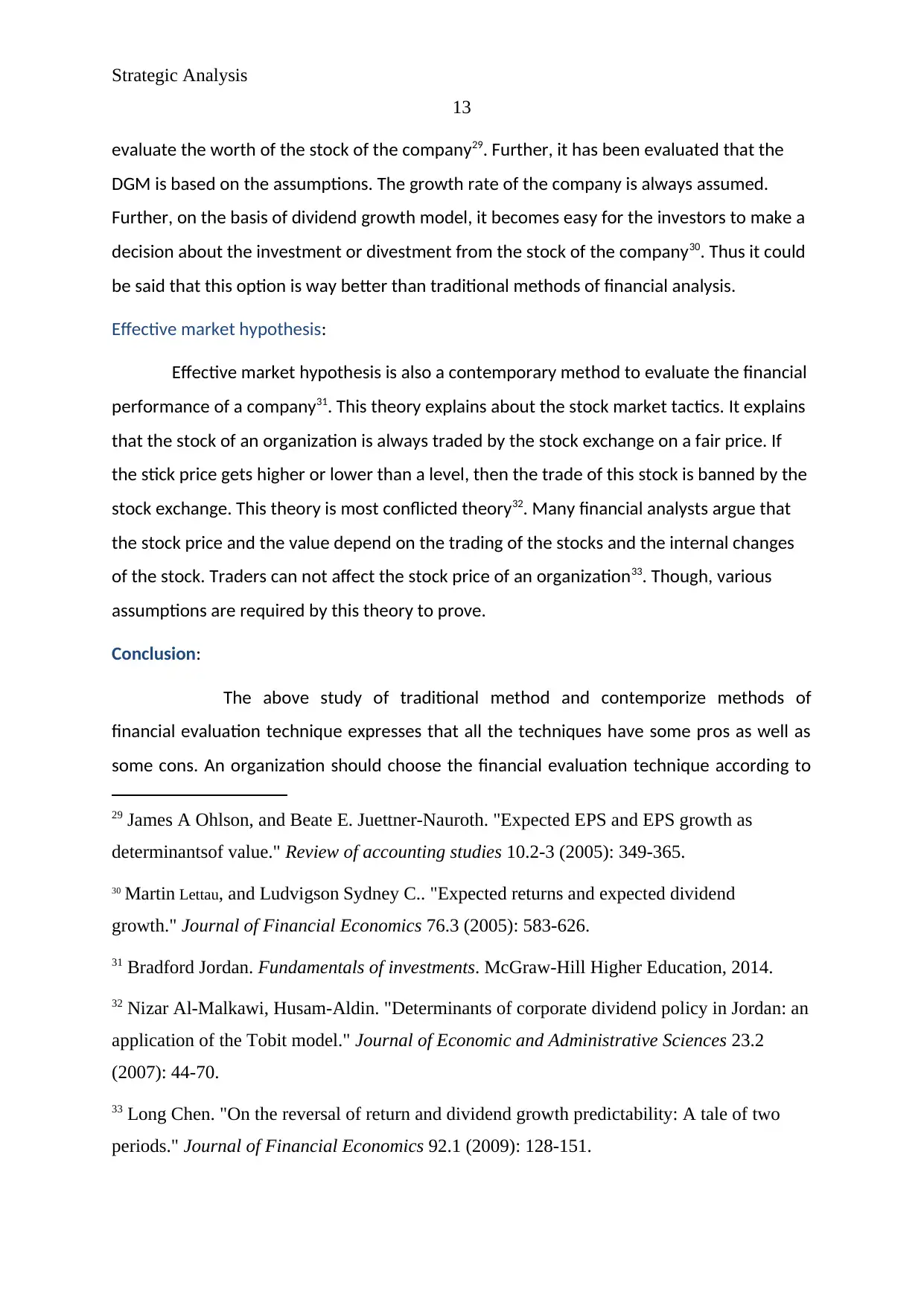
Strategic Analysis
13
evaluate the worth of the stock of the company29. Further, it has been evaluated that the
DGM is based on the assumptions. The growth rate of the company is always assumed.
Further, on the basis of dividend growth model, it becomes easy for the investors to make a
decision about the investment or divestment from the stock of the company30. Thus it could
be said that this option is way better than traditional methods of financial analysis.
Effective market hypothesis:
Effective market hypothesis is also a contemporary method to evaluate the financial
performance of a company31. This theory explains about the stock market tactics. It explains
that the stock of an organization is always traded by the stock exchange on a fair price. If
the stick price gets higher or lower than a level, then the trade of this stock is banned by the
stock exchange. This theory is most conflicted theory32. Many financial analysts argue that
the stock price and the value depend on the trading of the stocks and the internal changes
of the stock. Traders can not affect the stock price of an organization33. Though, various
assumptions are required by this theory to prove.
Conclusion:
The above study of traditional method and contemporize methods of
financial evaluation technique expresses that all the techniques have some pros as well as
some cons. An organization should choose the financial evaluation technique according to
29 James A Ohlson, and Beate E. Juettner-Nauroth. "Expected EPS and EPS growth as
determinantsof value." Review of accounting studies 10.2-3 (2005): 349-365.
30 Martin Lettau, and Ludvigson Sydney C.. "Expected returns and expected dividend
growth." Journal of Financial Economics 76.3 (2005): 583-626.
31 Bradford Jordan. Fundamentals of investments. McGraw-Hill Higher Education, 2014.
32 Nizar Al-Malkawi, Husam-Aldin. "Determinants of corporate dividend policy in Jordan: an
application of the Tobit model." Journal of Economic and Administrative Sciences 23.2
(2007): 44-70.
33 Long Chen. "On the reversal of return and dividend growth predictability: A tale of two
periods." Journal of Financial Economics 92.1 (2009): 128-151.
13
evaluate the worth of the stock of the company29. Further, it has been evaluated that the
DGM is based on the assumptions. The growth rate of the company is always assumed.
Further, on the basis of dividend growth model, it becomes easy for the investors to make a
decision about the investment or divestment from the stock of the company30. Thus it could
be said that this option is way better than traditional methods of financial analysis.
Effective market hypothesis:
Effective market hypothesis is also a contemporary method to evaluate the financial
performance of a company31. This theory explains about the stock market tactics. It explains
that the stock of an organization is always traded by the stock exchange on a fair price. If
the stick price gets higher or lower than a level, then the trade of this stock is banned by the
stock exchange. This theory is most conflicted theory32. Many financial analysts argue that
the stock price and the value depend on the trading of the stocks and the internal changes
of the stock. Traders can not affect the stock price of an organization33. Though, various
assumptions are required by this theory to prove.
Conclusion:
The above study of traditional method and contemporize methods of
financial evaluation technique expresses that all the techniques have some pros as well as
some cons. An organization should choose the financial evaluation technique according to
29 James A Ohlson, and Beate E. Juettner-Nauroth. "Expected EPS and EPS growth as
determinantsof value." Review of accounting studies 10.2-3 (2005): 349-365.
30 Martin Lettau, and Ludvigson Sydney C.. "Expected returns and expected dividend
growth." Journal of Financial Economics 76.3 (2005): 583-626.
31 Bradford Jordan. Fundamentals of investments. McGraw-Hill Higher Education, 2014.
32 Nizar Al-Malkawi, Husam-Aldin. "Determinants of corporate dividend policy in Jordan: an
application of the Tobit model." Journal of Economic and Administrative Sciences 23.2
(2007): 44-70.
33 Long Chen. "On the reversal of return and dividend growth predictability: A tale of two
periods." Journal of Financial Economics 92.1 (2009): 128-151.
Paraphrase This Document
Need a fresh take? Get an instant paraphrase of this document with our AI Paraphraser
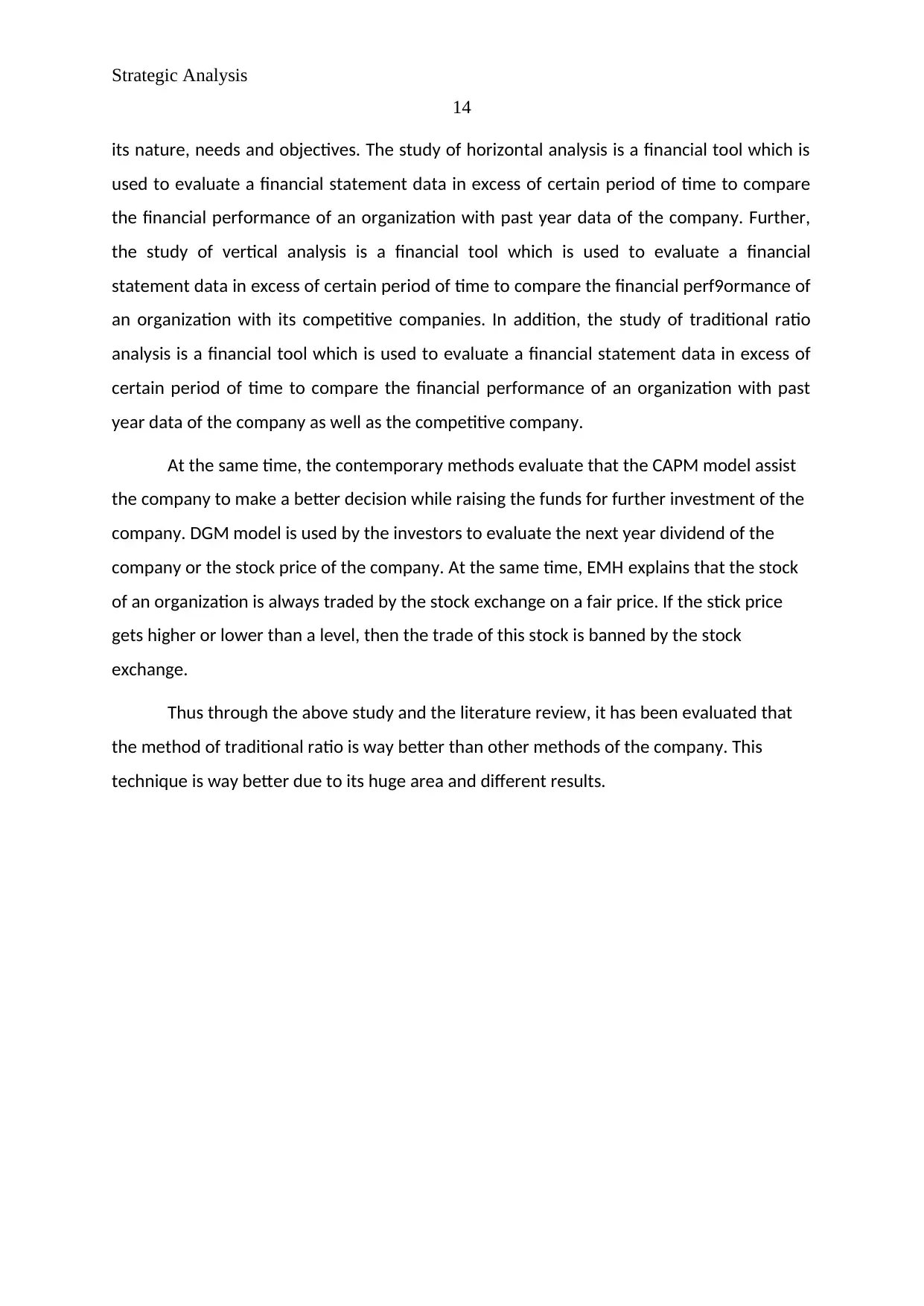
Strategic Analysis
14
its nature, needs and objectives. The study of horizontal analysis is a financial tool which is
used to evaluate a financial statement data in excess of certain period of time to compare
the financial performance of an organization with past year data of the company. Further,
the study of vertical analysis is a financial tool which is used to evaluate a financial
statement data in excess of certain period of time to compare the financial perf9ormance of
an organization with its competitive companies. In addition, the study of traditional ratio
analysis is a financial tool which is used to evaluate a financial statement data in excess of
certain period of time to compare the financial performance of an organization with past
year data of the company as well as the competitive company.
At the same time, the contemporary methods evaluate that the CAPM model assist
the company to make a better decision while raising the funds for further investment of the
company. DGM model is used by the investors to evaluate the next year dividend of the
company or the stock price of the company. At the same time, EMH explains that the stock
of an organization is always traded by the stock exchange on a fair price. If the stick price
gets higher or lower than a level, then the trade of this stock is banned by the stock
exchange.
Thus through the above study and the literature review, it has been evaluated that
the method of traditional ratio is way better than other methods of the company. This
technique is way better due to its huge area and different results.
14
its nature, needs and objectives. The study of horizontal analysis is a financial tool which is
used to evaluate a financial statement data in excess of certain period of time to compare
the financial performance of an organization with past year data of the company. Further,
the study of vertical analysis is a financial tool which is used to evaluate a financial
statement data in excess of certain period of time to compare the financial perf9ormance of
an organization with its competitive companies. In addition, the study of traditional ratio
analysis is a financial tool which is used to evaluate a financial statement data in excess of
certain period of time to compare the financial performance of an organization with past
year data of the company as well as the competitive company.
At the same time, the contemporary methods evaluate that the CAPM model assist
the company to make a better decision while raising the funds for further investment of the
company. DGM model is used by the investors to evaluate the next year dividend of the
company or the stock price of the company. At the same time, EMH explains that the stock
of an organization is always traded by the stock exchange on a fair price. If the stick price
gets higher or lower than a level, then the trade of this stock is banned by the stock
exchange.
Thus through the above study and the literature review, it has been evaluated that
the method of traditional ratio is way better than other methods of the company. This
technique is way better due to its huge area and different results.
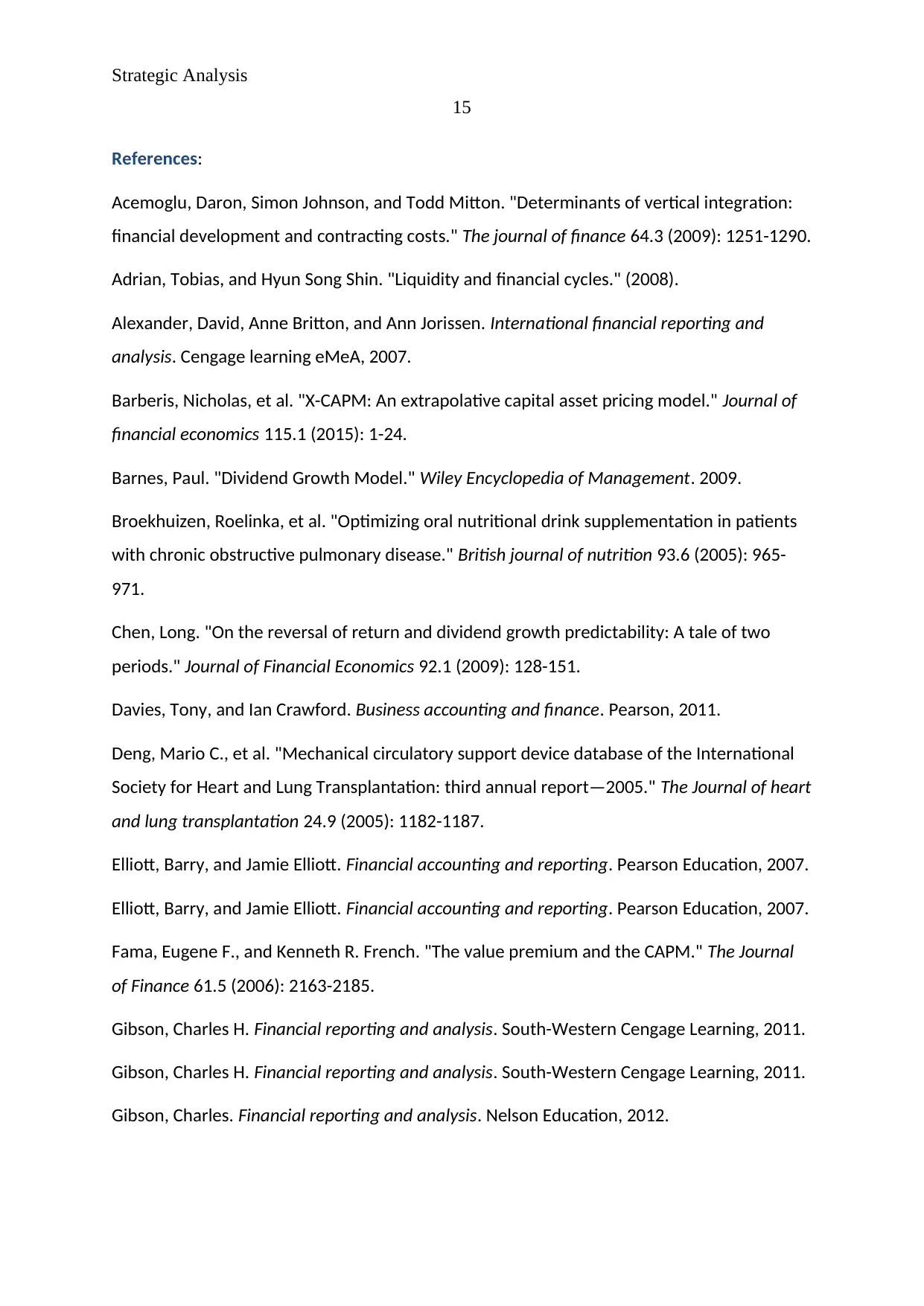
Strategic Analysis
15
References:
Acemoglu, Daron, Simon Johnson, and Todd Mitton. "Determinants of vertical integration:
financial development and contracting costs." The journal of finance 64.3 (2009): 1251-1290.
Adrian, Tobias, and Hyun Song Shin. "Liquidity and financial cycles." (2008).
Alexander, David, Anne Britton, and Ann Jorissen. International financial reporting and
analysis. Cengage learning eMeA, 2007.
Barberis, Nicholas, et al. "X-CAPM: An extrapolative capital asset pricing model." Journal of
financial economics 115.1 (2015): 1-24.
Barnes, Paul. "Dividend Growth Model." Wiley Encyclopedia of Management. 2009.
Broekhuizen, Roelinka, et al. "Optimizing oral nutritional drink supplementation in patients
with chronic obstructive pulmonary disease." British journal of nutrition 93.6 (2005): 965-
971.
Chen, Long. "On the reversal of return and dividend growth predictability: A tale of two
periods." Journal of Financial Economics 92.1 (2009): 128-151.
Davies, Tony, and Ian Crawford. Business accounting and finance. Pearson, 2011.
Deng, Mario C., et al. "Mechanical circulatory support device database of the International
Society for Heart and Lung Transplantation: third annual report—2005." The Journal of heart
and lung transplantation 24.9 (2005): 1182-1187.
Elliott, Barry, and Jamie Elliott. Financial accounting and reporting. Pearson Education, 2007.
Elliott, Barry, and Jamie Elliott. Financial accounting and reporting. Pearson Education, 2007.
Fama, Eugene F., and Kenneth R. French. "The value premium and the CAPM." The Journal
of Finance 61.5 (2006): 2163-2185.
Gibson, Charles H. Financial reporting and analysis. South-Western Cengage Learning, 2011.
Gibson, Charles H. Financial reporting and analysis. South-Western Cengage Learning, 2011.
Gibson, Charles. Financial reporting and analysis. Nelson Education, 2012.
15
References:
Acemoglu, Daron, Simon Johnson, and Todd Mitton. "Determinants of vertical integration:
financial development and contracting costs." The journal of finance 64.3 (2009): 1251-1290.
Adrian, Tobias, and Hyun Song Shin. "Liquidity and financial cycles." (2008).
Alexander, David, Anne Britton, and Ann Jorissen. International financial reporting and
analysis. Cengage learning eMeA, 2007.
Barberis, Nicholas, et al. "X-CAPM: An extrapolative capital asset pricing model." Journal of
financial economics 115.1 (2015): 1-24.
Barnes, Paul. "Dividend Growth Model." Wiley Encyclopedia of Management. 2009.
Broekhuizen, Roelinka, et al. "Optimizing oral nutritional drink supplementation in patients
with chronic obstructive pulmonary disease." British journal of nutrition 93.6 (2005): 965-
971.
Chen, Long. "On the reversal of return and dividend growth predictability: A tale of two
periods." Journal of Financial Economics 92.1 (2009): 128-151.
Davies, Tony, and Ian Crawford. Business accounting and finance. Pearson, 2011.
Deng, Mario C., et al. "Mechanical circulatory support device database of the International
Society for Heart and Lung Transplantation: third annual report—2005." The Journal of heart
and lung transplantation 24.9 (2005): 1182-1187.
Elliott, Barry, and Jamie Elliott. Financial accounting and reporting. Pearson Education, 2007.
Elliott, Barry, and Jamie Elliott. Financial accounting and reporting. Pearson Education, 2007.
Fama, Eugene F., and Kenneth R. French. "The value premium and the CAPM." The Journal
of Finance 61.5 (2006): 2163-2185.
Gibson, Charles H. Financial reporting and analysis. South-Western Cengage Learning, 2011.
Gibson, Charles H. Financial reporting and analysis. South-Western Cengage Learning, 2011.
Gibson, Charles. Financial reporting and analysis. Nelson Education, 2012.
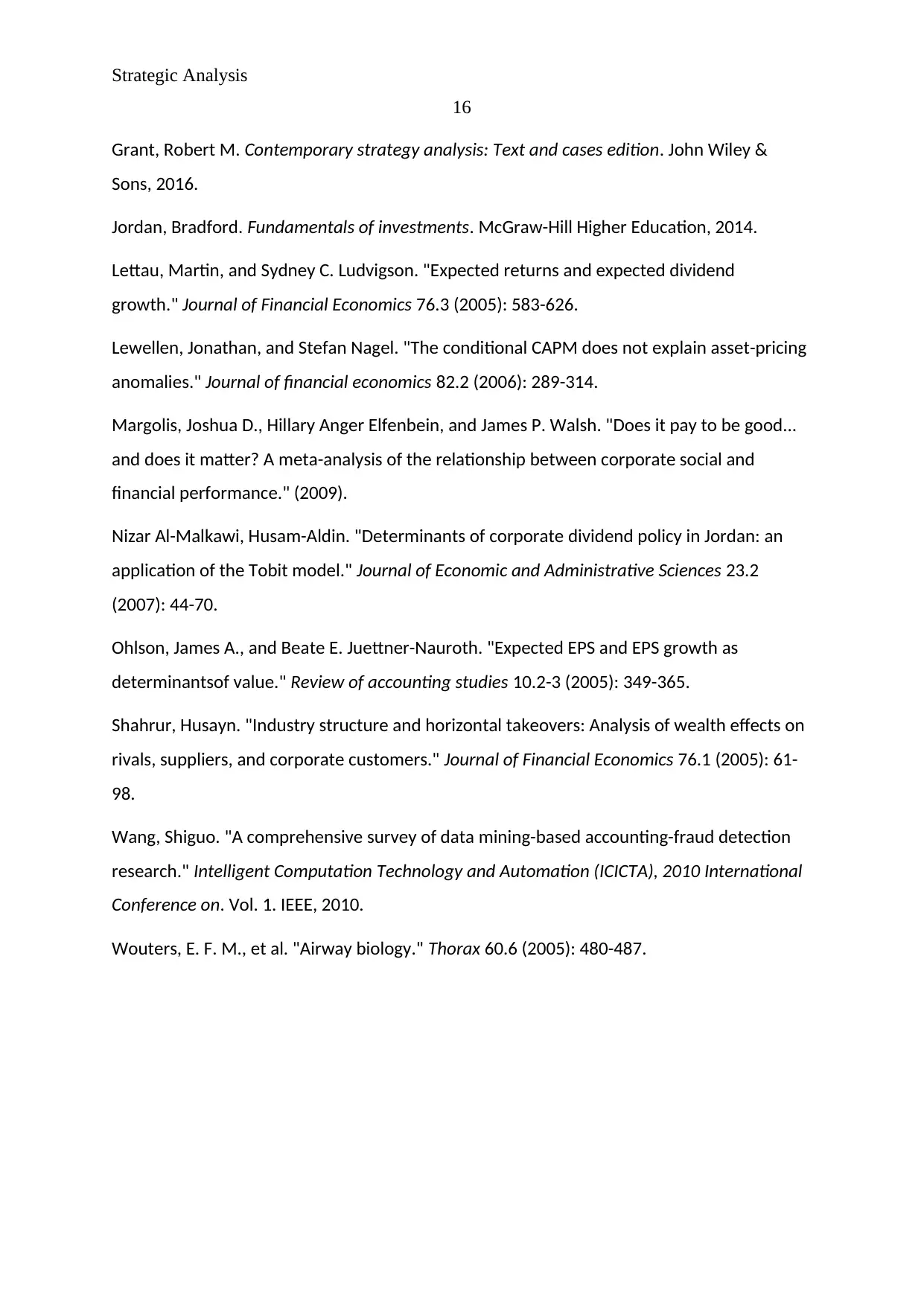
Strategic Analysis
16
Grant, Robert M. Contemporary strategy analysis: Text and cases edition. John Wiley &
Sons, 2016.
Jordan, Bradford. Fundamentals of investments. McGraw-Hill Higher Education, 2014.
Lettau, Martin, and Sydney C. Ludvigson. "Expected returns and expected dividend
growth." Journal of Financial Economics 76.3 (2005): 583-626.
Lewellen, Jonathan, and Stefan Nagel. "The conditional CAPM does not explain asset-pricing
anomalies." Journal of financial economics 82.2 (2006): 289-314.
Margolis, Joshua D., Hillary Anger Elfenbein, and James P. Walsh. "Does it pay to be good...
and does it matter? A meta-analysis of the relationship between corporate social and
financial performance." (2009).
Nizar Al-Malkawi, Husam-Aldin. "Determinants of corporate dividend policy in Jordan: an
application of the Tobit model." Journal of Economic and Administrative Sciences 23.2
(2007): 44-70.
Ohlson, James A., and Beate E. Juettner-Nauroth. "Expected EPS and EPS growth as
determinantsof value." Review of accounting studies 10.2-3 (2005): 349-365.
Shahrur, Husayn. "Industry structure and horizontal takeovers: Analysis of wealth effects on
rivals, suppliers, and corporate customers." Journal of Financial Economics 76.1 (2005): 61-
98.
Wang, Shiguo. "A comprehensive survey of data mining-based accounting-fraud detection
research." Intelligent Computation Technology and Automation (ICICTA), 2010 International
Conference on. Vol. 1. IEEE, 2010.
Wouters, E. F. M., et al. "Airway biology." Thorax 60.6 (2005): 480-487.
16
Grant, Robert M. Contemporary strategy analysis: Text and cases edition. John Wiley &
Sons, 2016.
Jordan, Bradford. Fundamentals of investments. McGraw-Hill Higher Education, 2014.
Lettau, Martin, and Sydney C. Ludvigson. "Expected returns and expected dividend
growth." Journal of Financial Economics 76.3 (2005): 583-626.
Lewellen, Jonathan, and Stefan Nagel. "The conditional CAPM does not explain asset-pricing
anomalies." Journal of financial economics 82.2 (2006): 289-314.
Margolis, Joshua D., Hillary Anger Elfenbein, and James P. Walsh. "Does it pay to be good...
and does it matter? A meta-analysis of the relationship between corporate social and
financial performance." (2009).
Nizar Al-Malkawi, Husam-Aldin. "Determinants of corporate dividend policy in Jordan: an
application of the Tobit model." Journal of Economic and Administrative Sciences 23.2
(2007): 44-70.
Ohlson, James A., and Beate E. Juettner-Nauroth. "Expected EPS and EPS growth as
determinantsof value." Review of accounting studies 10.2-3 (2005): 349-365.
Shahrur, Husayn. "Industry structure and horizontal takeovers: Analysis of wealth effects on
rivals, suppliers, and corporate customers." Journal of Financial Economics 76.1 (2005): 61-
98.
Wang, Shiguo. "A comprehensive survey of data mining-based accounting-fraud detection
research." Intelligent Computation Technology and Automation (ICICTA), 2010 International
Conference on. Vol. 1. IEEE, 2010.
Wouters, E. F. M., et al. "Airway biology." Thorax 60.6 (2005): 480-487.
Secure Best Marks with AI Grader
Need help grading? Try our AI Grader for instant feedback on your assignments.
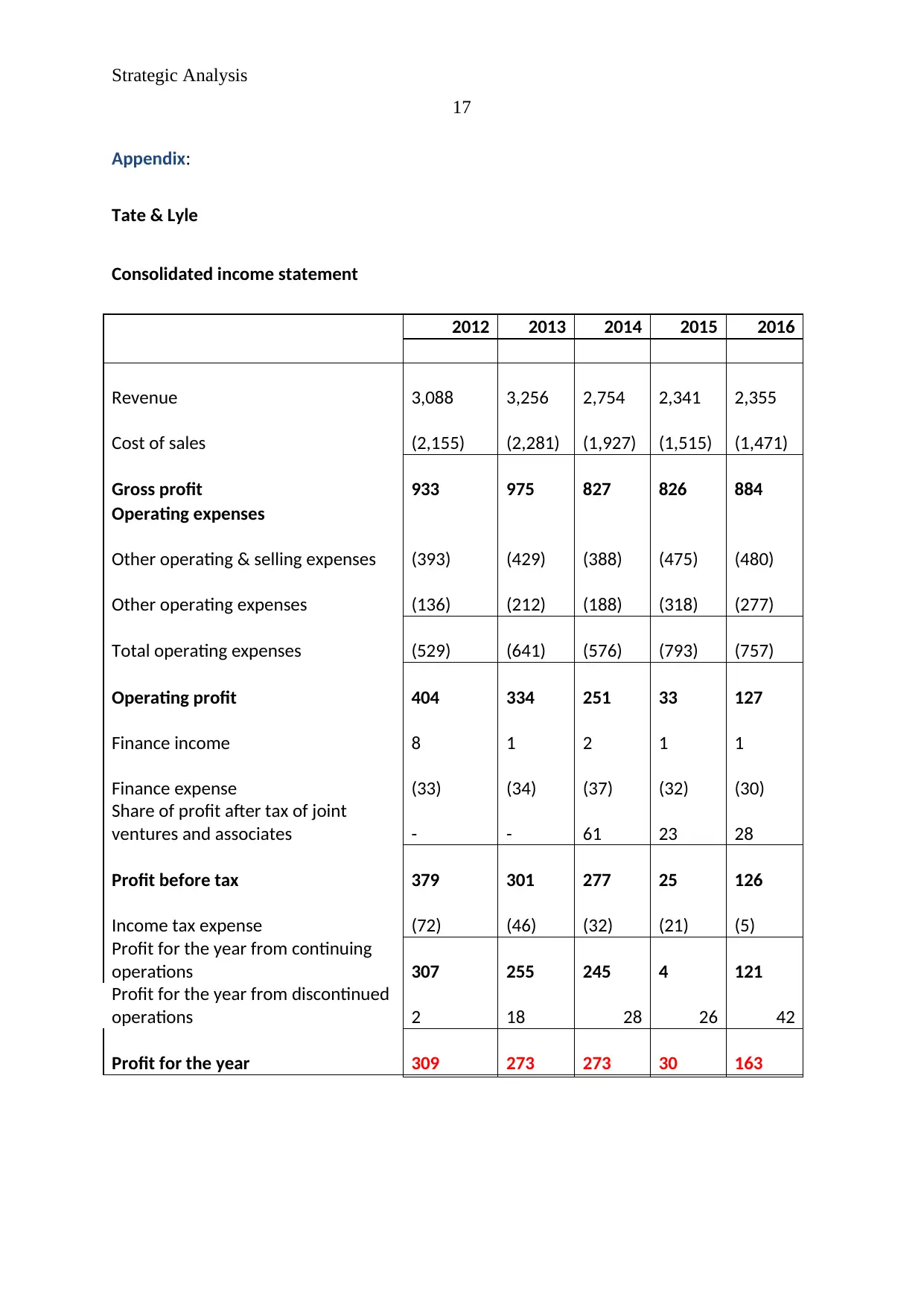
Strategic Analysis
17
Appendix:
Tate & Lyle
Consolidated income statement
2012 2013 2014 2015 2016
Revenue 3,088 3,256 2,754 2,341 2,355
Cost of sales (2,155) (2,281) (1,927) (1,515) (1,471)
Gross profit 933 975 827 826 884
Operating expenses
Other operating & selling expenses (393) (429) (388) (475) (480)
Other operating expenses (136) (212) (188) (318) (277)
Total operating expenses (529) (641) (576) (793) (757)
Operating profit 404 334 251 33 127
Finance income 8 1 2 1 1
Finance expense (33) (34) (37) (32) (30)
Share of profit after tax of joint
ventures and associates - - 61 23 28
Profit before tax 379 301 277 25 126
Income tax expense (72) (46) (32) (21) (5)
Profit for the year from continuing
operations 307 255 245 4 121
Profit for the year from discontinued
operations 2 18 28 26 42
Profit for the year 309 273 273 30 163
17
Appendix:
Tate & Lyle
Consolidated income statement
2012 2013 2014 2015 2016
Revenue 3,088 3,256 2,754 2,341 2,355
Cost of sales (2,155) (2,281) (1,927) (1,515) (1,471)
Gross profit 933 975 827 826 884
Operating expenses
Other operating & selling expenses (393) (429) (388) (475) (480)
Other operating expenses (136) (212) (188) (318) (277)
Total operating expenses (529) (641) (576) (793) (757)
Operating profit 404 334 251 33 127
Finance income 8 1 2 1 1
Finance expense (33) (34) (37) (32) (30)
Share of profit after tax of joint
ventures and associates - - 61 23 28
Profit before tax 379 301 277 25 126
Income tax expense (72) (46) (32) (21) (5)
Profit for the year from continuing
operations 307 255 245 4 121
Profit for the year from discontinued
operations 2 18 28 26 42
Profit for the year 309 273 273 30 163
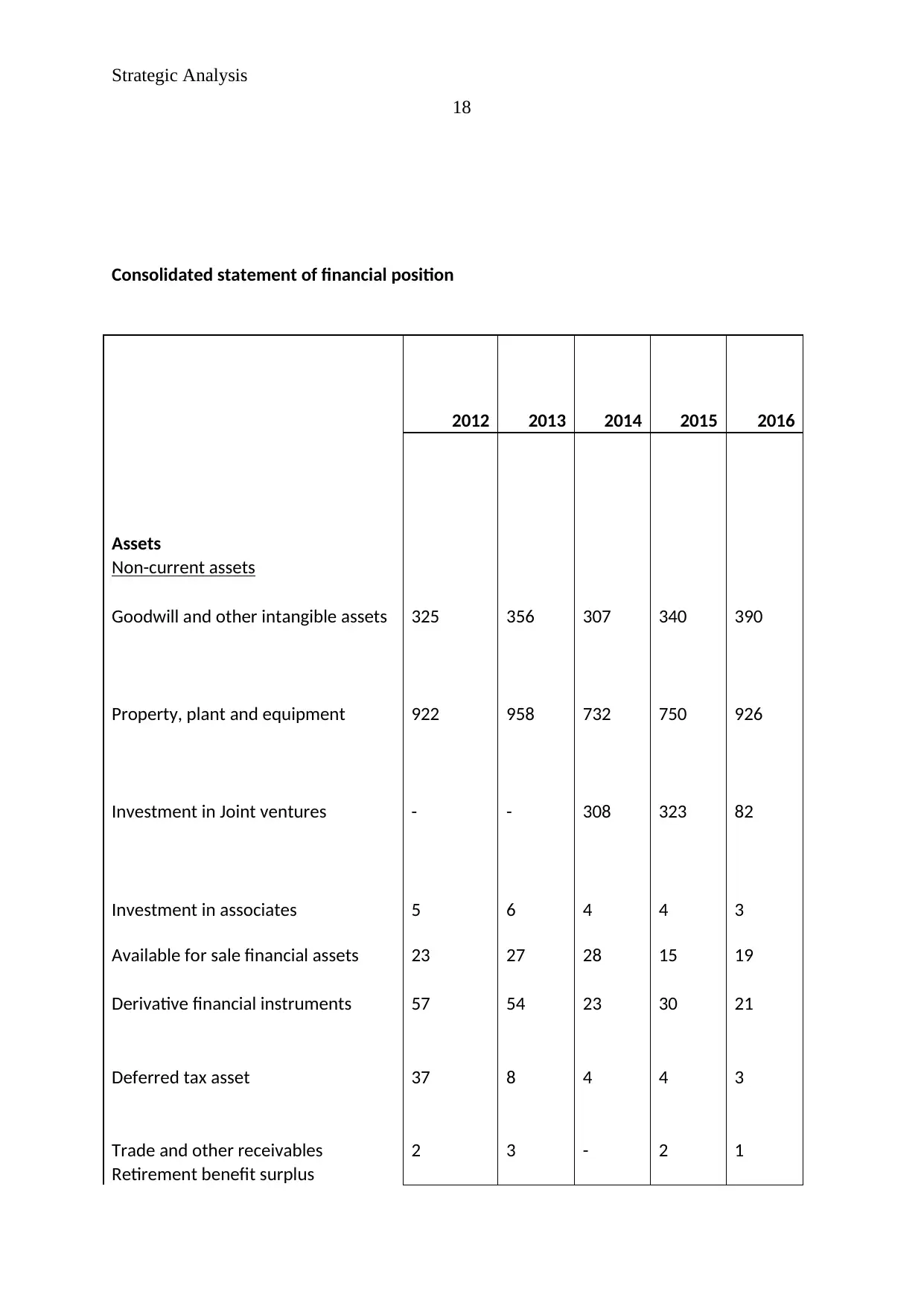
Strategic Analysis
18
Consolidated statement of financial position
2012 2013 2014 2015 2016
Assets
Non-current assets
Goodwill and other intangible assets 325 356 307 340 390
Property, plant and equipment 922 958 732 750 926
Investment in Joint ventures - - 308 323 82
Investment in associates 5 6 4 4 3
Available for sale financial assets 23 27 28 15 19
Derivative financial instruments 57 54 23 30 21
Deferred tax asset 37 8 4 4 3
Trade and other receivables 2 3 - 2 1
Retirement benefit surplus
18
Consolidated statement of financial position
2012 2013 2014 2015 2016
Assets
Non-current assets
Goodwill and other intangible assets 325 356 307 340 390
Property, plant and equipment 922 958 732 750 926
Investment in Joint ventures - - 308 323 82
Investment in associates 5 6 4 4 3
Available for sale financial assets 23 27 28 15 19
Derivative financial instruments 57 54 23 30 21
Deferred tax asset 37 8 4 4 3
Trade and other receivables 2 3 - 2 1
Retirement benefit surplus
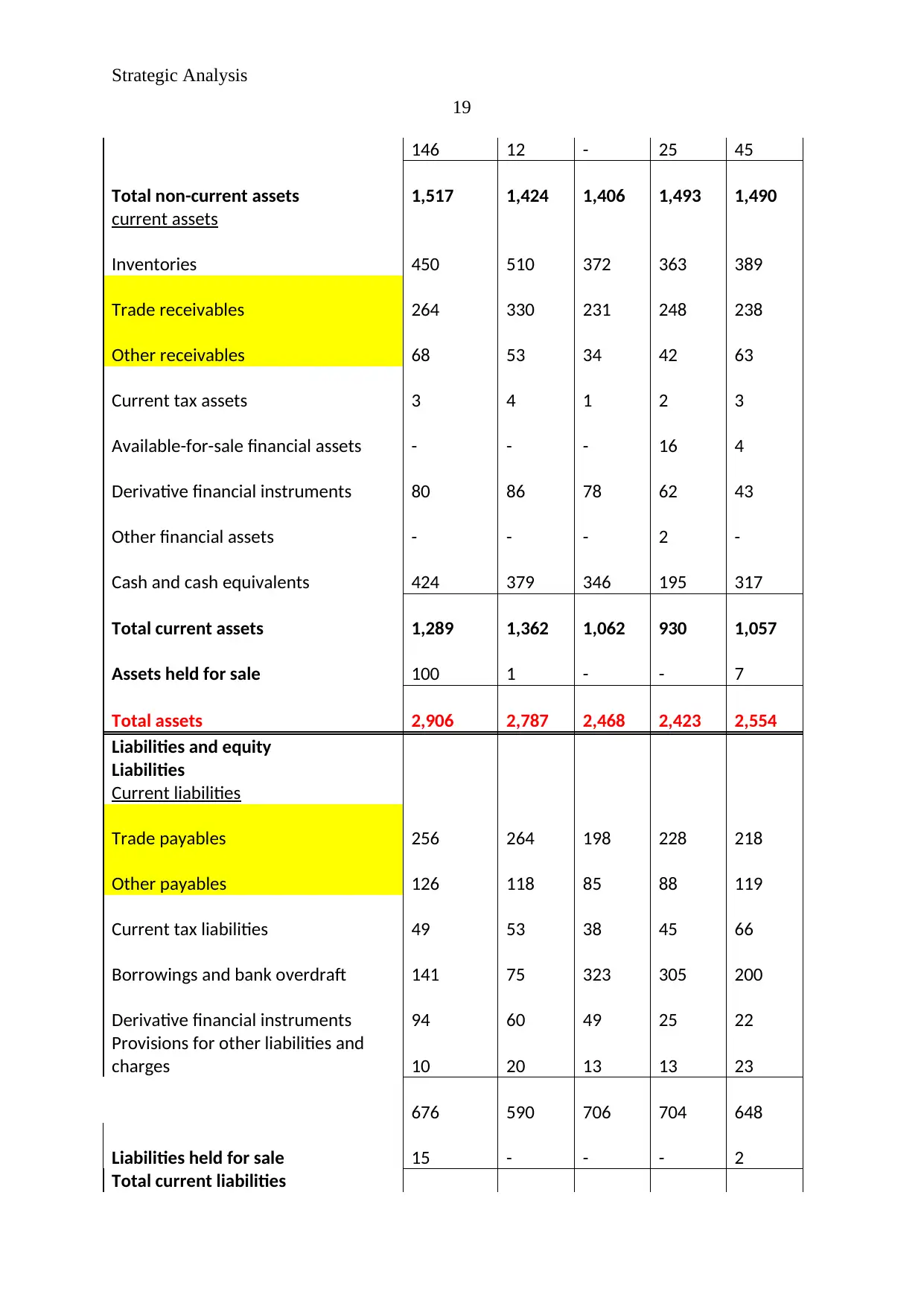
Strategic Analysis
19
146 12 - 25 45
Total non-current assets 1,517 1,424 1,406 1,493 1,490
current assets
Inventories 450 510 372 363 389
Trade receivables 264 330 231 248 238
Other receivables 68 53 34 42 63
Current tax assets 3 4 1 2 3
Available-for-sale financial assets - - - 16 4
Derivative financial instruments 80 86 78 62 43
Other financial assets - - - 2 -
Cash and cash equivalents 424 379 346 195 317
Total current assets 1,289 1,362 1,062 930 1,057
Assets held for sale 100 1 - - 7
Total assets 2,906 2,787 2,468 2,423 2,554
Liabilities and equity
Liabilities
Current liabilities
Trade payables 256 264 198 228 218
Other payables 126 118 85 88 119
Current tax liabilities 49 53 38 45 66
Borrowings and bank overdraft 141 75 323 305 200
Derivative financial instruments 94 60 49 25 22
Provisions for other liabilities and
charges 10 20 13 13 23
676 590 706 704 648
Liabilities held for sale 15 - - - 2
Total current liabilities
19
146 12 - 25 45
Total non-current assets 1,517 1,424 1,406 1,493 1,490
current assets
Inventories 450 510 372 363 389
Trade receivables 264 330 231 248 238
Other receivables 68 53 34 42 63
Current tax assets 3 4 1 2 3
Available-for-sale financial assets - - - 16 4
Derivative financial instruments 80 86 78 62 43
Other financial assets - - - 2 -
Cash and cash equivalents 424 379 346 195 317
Total current assets 1,289 1,362 1,062 930 1,057
Assets held for sale 100 1 - - 7
Total assets 2,906 2,787 2,468 2,423 2,554
Liabilities and equity
Liabilities
Current liabilities
Trade payables 256 264 198 228 218
Other payables 126 118 85 88 119
Current tax liabilities 49 53 38 45 66
Borrowings and bank overdraft 141 75 323 305 200
Derivative financial instruments 94 60 49 25 22
Provisions for other liabilities and
charges 10 20 13 13 23
676 590 706 704 648
Liabilities held for sale 15 - - - 2
Total current liabilities
Paraphrase This Document
Need a fresh take? Get an instant paraphrase of this document with our AI Paraphraser
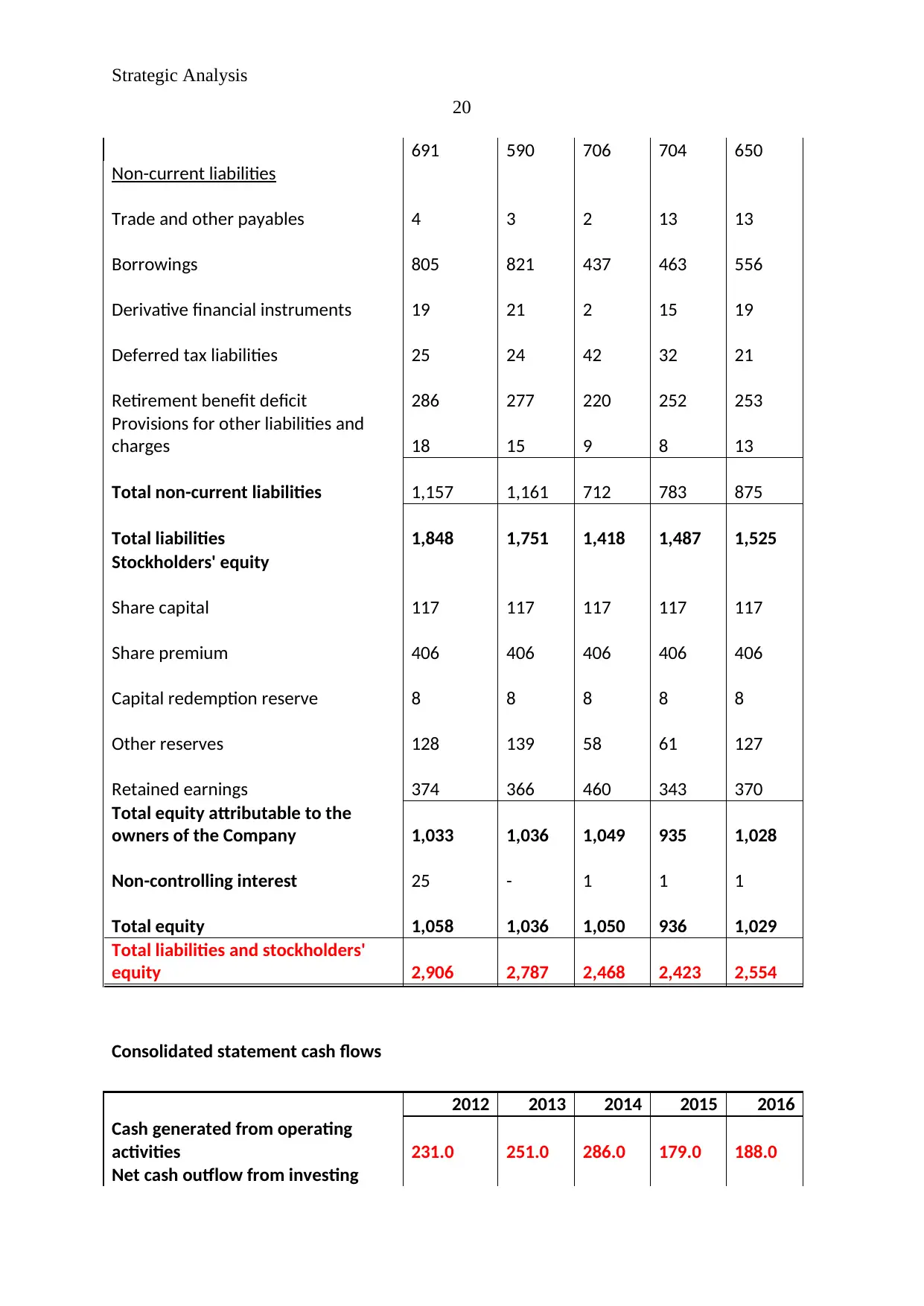
Strategic Analysis
20
691 590 706 704 650
Non-current liabilities
Trade and other payables 4 3 2 13 13
Borrowings 805 821 437 463 556
Derivative financial instruments 19 21 2 15 19
Deferred tax liabilities 25 24 42 32 21
Retirement benefit deficit 286 277 220 252 253
Provisions for other liabilities and
charges 18 15 9 8 13
Total non-current liabilities 1,157 1,161 712 783 875
Total liabilities 1,848 1,751 1,418 1,487 1,525
Stockholders' equity
Share capital 117 117 117 117 117
Share premium 406 406 406 406 406
Capital redemption reserve 8 8 8 8 8
Other reserves 128 139 58 61 127
Retained earnings 374 366 460 343 370
Total equity attributable to the
owners of the Company 1,033 1,036 1,049 935 1,028
Non-controlling interest 25 - 1 1 1
Total equity 1,058 1,036 1,050 936 1,029
Total liabilities and stockholders'
equity 2,906 2,787 2,468 2,423 2,554
Consolidated statement cash flows
2012 2013 2014 2015 2016
Cash generated from operating
activities 231.0 251.0 286.0 179.0 188.0
Net cash outflow from investing
20
691 590 706 704 650
Non-current liabilities
Trade and other payables 4 3 2 13 13
Borrowings 805 821 437 463 556
Derivative financial instruments 19 21 2 15 19
Deferred tax liabilities 25 24 42 32 21
Retirement benefit deficit 286 277 220 252 253
Provisions for other liabilities and
charges 18 15 9 8 13
Total non-current liabilities 1,157 1,161 712 783 875
Total liabilities 1,848 1,751 1,418 1,487 1,525
Stockholders' equity
Share capital 117 117 117 117 117
Share premium 406 406 406 406 406
Capital redemption reserve 8 8 8 8 8
Other reserves 128 139 58 61 127
Retained earnings 374 366 460 343 370
Total equity attributable to the
owners of the Company 1,033 1,036 1,049 935 1,028
Non-controlling interest 25 - 1 1 1
Total equity 1,058 1,036 1,050 936 1,029
Total liabilities and stockholders'
equity 2,906 2,787 2,468 2,423 2,554
Consolidated statement cash flows
2012 2013 2014 2015 2016
Cash generated from operating
activities 231.0 251.0 286.0 179.0 188.0
Net cash outflow from investing
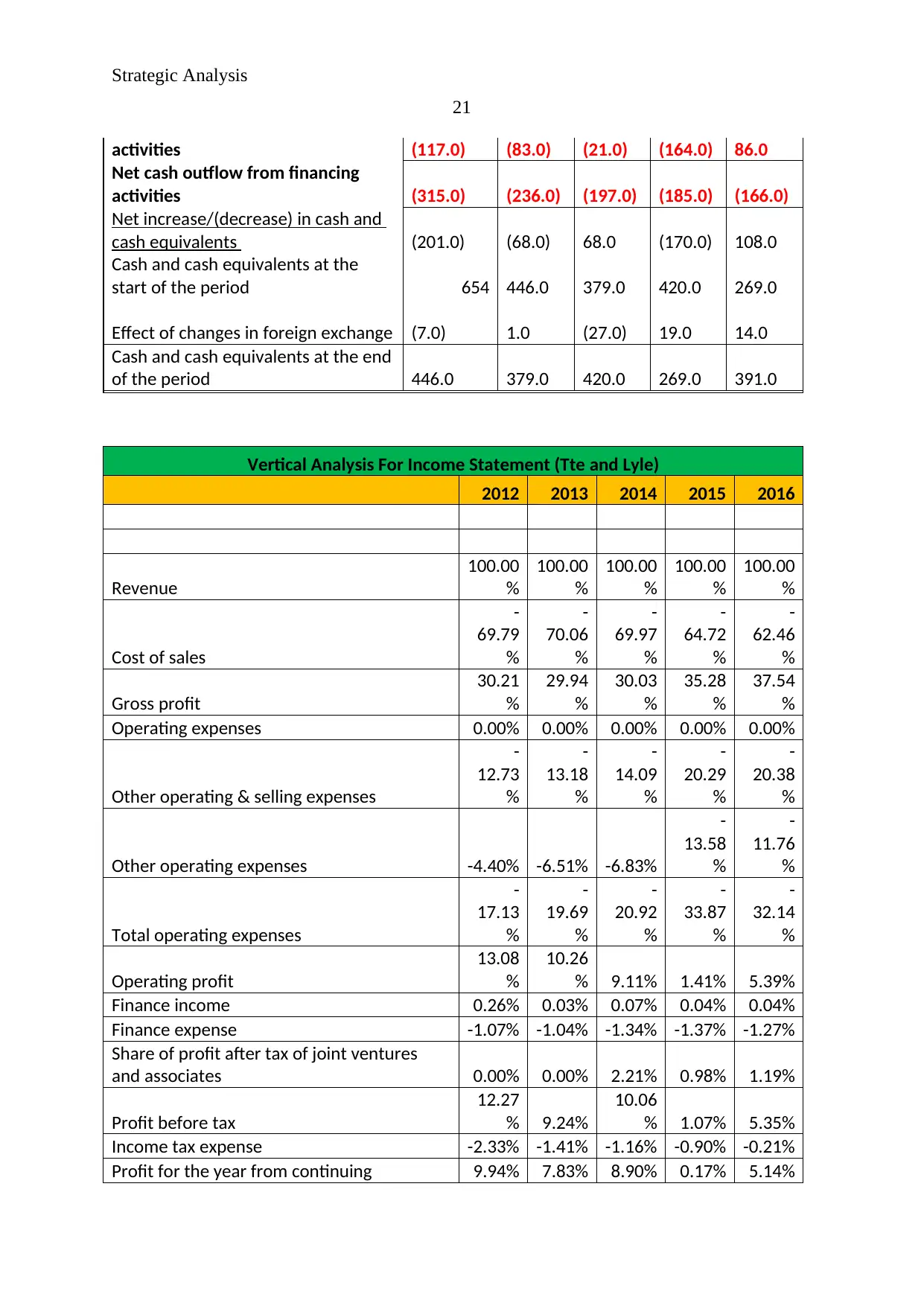
Strategic Analysis
21
activities (117.0) (83.0) (21.0) (164.0) 86.0
Net cash outflow from financing
activities (315.0) (236.0) (197.0) (185.0) (166.0)
Net increase/(decrease) in cash and
cash equivalents (201.0) (68.0) 68.0 (170.0) 108.0
Cash and cash equivalents at the
start of the period 654 446.0 379.0 420.0 269.0
Effect of changes in foreign exchange (7.0) 1.0 (27.0) 19.0 14.0
Cash and cash equivalents at the end
of the period 446.0 379.0 420.0 269.0 391.0
Vertical Analysis For Income Statement (Tte and Lyle)
2012 2013 2014 2015 2016
Revenue
100.00
%
100.00
%
100.00
%
100.00
%
100.00
%
Cost of sales
-
69.79
%
-
70.06
%
-
69.97
%
-
64.72
%
-
62.46
%
Gross profit
30.21
%
29.94
%
30.03
%
35.28
%
37.54
%
Operating expenses 0.00% 0.00% 0.00% 0.00% 0.00%
Other operating & selling expenses
-
12.73
%
-
13.18
%
-
14.09
%
-
20.29
%
-
20.38
%
Other operating expenses -4.40% -6.51% -6.83%
-
13.58
%
-
11.76
%
Total operating expenses
-
17.13
%
-
19.69
%
-
20.92
%
-
33.87
%
-
32.14
%
Operating profit
13.08
%
10.26
% 9.11% 1.41% 5.39%
Finance income 0.26% 0.03% 0.07% 0.04% 0.04%
Finance expense -1.07% -1.04% -1.34% -1.37% -1.27%
Share of profit after tax of joint ventures
and associates 0.00% 0.00% 2.21% 0.98% 1.19%
Profit before tax
12.27
% 9.24%
10.06
% 1.07% 5.35%
Income tax expense -2.33% -1.41% -1.16% -0.90% -0.21%
Profit for the year from continuing 9.94% 7.83% 8.90% 0.17% 5.14%
21
activities (117.0) (83.0) (21.0) (164.0) 86.0
Net cash outflow from financing
activities (315.0) (236.0) (197.0) (185.0) (166.0)
Net increase/(decrease) in cash and
cash equivalents (201.0) (68.0) 68.0 (170.0) 108.0
Cash and cash equivalents at the
start of the period 654 446.0 379.0 420.0 269.0
Effect of changes in foreign exchange (7.0) 1.0 (27.0) 19.0 14.0
Cash and cash equivalents at the end
of the period 446.0 379.0 420.0 269.0 391.0
Vertical Analysis For Income Statement (Tte and Lyle)
2012 2013 2014 2015 2016
Revenue
100.00
%
100.00
%
100.00
%
100.00
%
100.00
%
Cost of sales
-
69.79
%
-
70.06
%
-
69.97
%
-
64.72
%
-
62.46
%
Gross profit
30.21
%
29.94
%
30.03
%
35.28
%
37.54
%
Operating expenses 0.00% 0.00% 0.00% 0.00% 0.00%
Other operating & selling expenses
-
12.73
%
-
13.18
%
-
14.09
%
-
20.29
%
-
20.38
%
Other operating expenses -4.40% -6.51% -6.83%
-
13.58
%
-
11.76
%
Total operating expenses
-
17.13
%
-
19.69
%
-
20.92
%
-
33.87
%
-
32.14
%
Operating profit
13.08
%
10.26
% 9.11% 1.41% 5.39%
Finance income 0.26% 0.03% 0.07% 0.04% 0.04%
Finance expense -1.07% -1.04% -1.34% -1.37% -1.27%
Share of profit after tax of joint ventures
and associates 0.00% 0.00% 2.21% 0.98% 1.19%
Profit before tax
12.27
% 9.24%
10.06
% 1.07% 5.35%
Income tax expense -2.33% -1.41% -1.16% -0.90% -0.21%
Profit for the year from continuing 9.94% 7.83% 8.90% 0.17% 5.14%
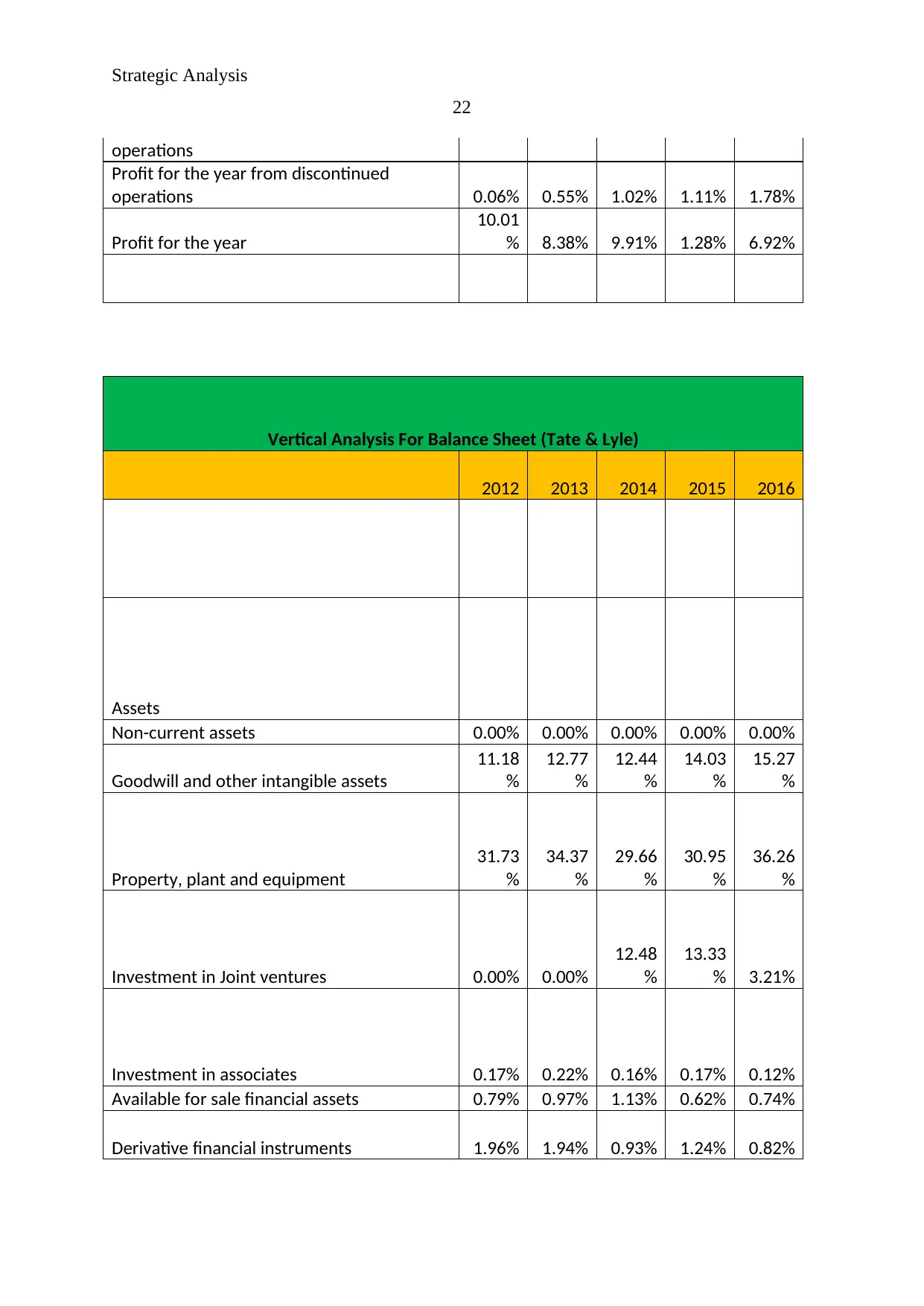
Strategic Analysis
22
operations
Profit for the year from discontinued
operations 0.06% 0.55% 1.02% 1.11% 1.78%
Profit for the year
10.01
% 8.38% 9.91% 1.28% 6.92%
Vertical Analysis For Balance Sheet (Tate & Lyle)
2012 2013 2014 2015 2016
Assets
Non-current assets 0.00% 0.00% 0.00% 0.00% 0.00%
Goodwill and other intangible assets
11.18
%
12.77
%
12.44
%
14.03
%
15.27
%
Property, plant and equipment
31.73
%
34.37
%
29.66
%
30.95
%
36.26
%
Investment in Joint ventures 0.00% 0.00%
12.48
%
13.33
% 3.21%
Investment in associates 0.17% 0.22% 0.16% 0.17% 0.12%
Available for sale financial assets 0.79% 0.97% 1.13% 0.62% 0.74%
Derivative financial instruments 1.96% 1.94% 0.93% 1.24% 0.82%
22
operations
Profit for the year from discontinued
operations 0.06% 0.55% 1.02% 1.11% 1.78%
Profit for the year
10.01
% 8.38% 9.91% 1.28% 6.92%
Vertical Analysis For Balance Sheet (Tate & Lyle)
2012 2013 2014 2015 2016
Assets
Non-current assets 0.00% 0.00% 0.00% 0.00% 0.00%
Goodwill and other intangible assets
11.18
%
12.77
%
12.44
%
14.03
%
15.27
%
Property, plant and equipment
31.73
%
34.37
%
29.66
%
30.95
%
36.26
%
Investment in Joint ventures 0.00% 0.00%
12.48
%
13.33
% 3.21%
Investment in associates 0.17% 0.22% 0.16% 0.17% 0.12%
Available for sale financial assets 0.79% 0.97% 1.13% 0.62% 0.74%
Derivative financial instruments 1.96% 1.94% 0.93% 1.24% 0.82%
Secure Best Marks with AI Grader
Need help grading? Try our AI Grader for instant feedback on your assignments.
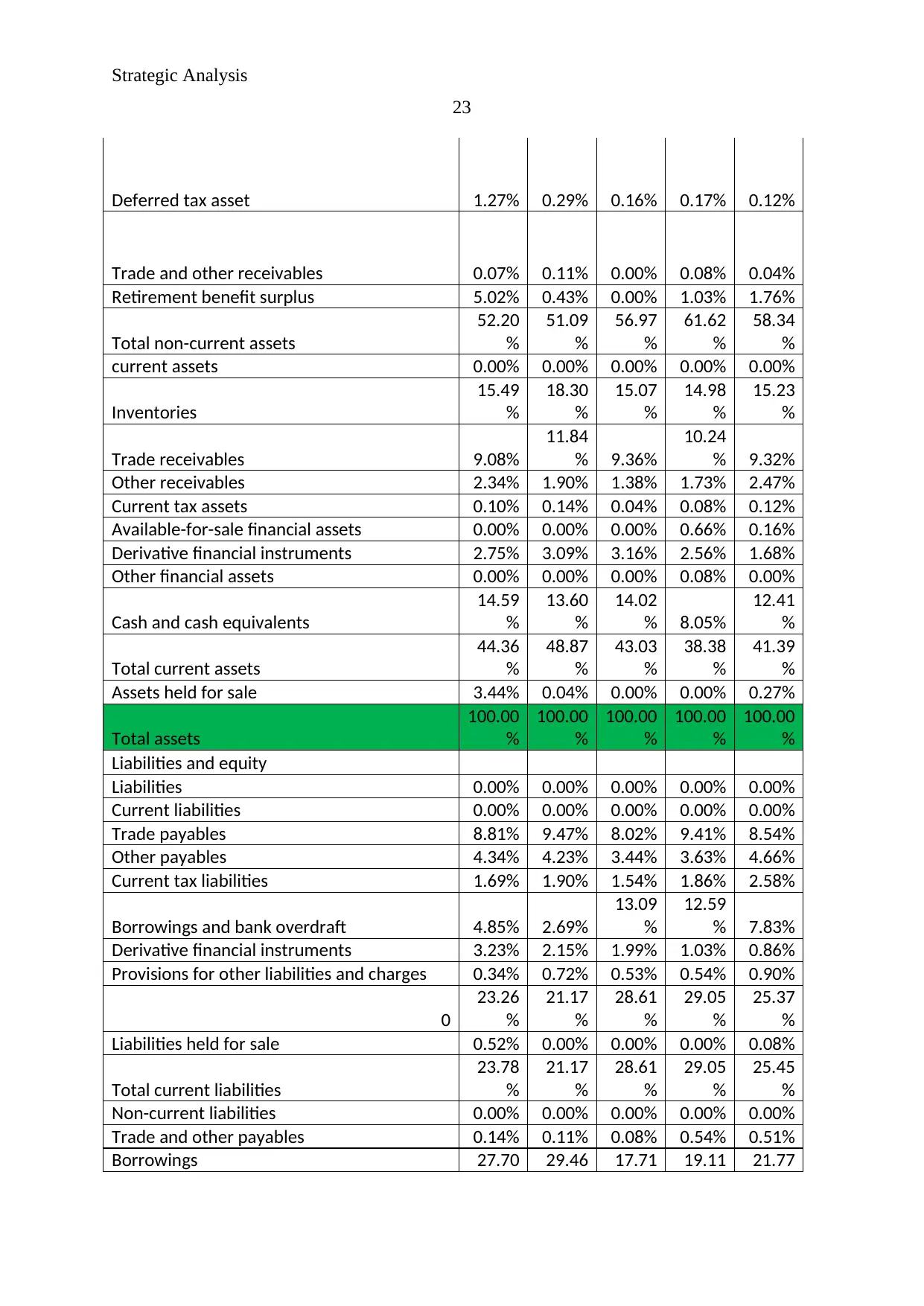
Strategic Analysis
23
Deferred tax asset 1.27% 0.29% 0.16% 0.17% 0.12%
Trade and other receivables 0.07% 0.11% 0.00% 0.08% 0.04%
Retirement benefit surplus 5.02% 0.43% 0.00% 1.03% 1.76%
Total non-current assets
52.20
%
51.09
%
56.97
%
61.62
%
58.34
%
current assets 0.00% 0.00% 0.00% 0.00% 0.00%
Inventories
15.49
%
18.30
%
15.07
%
14.98
%
15.23
%
Trade receivables 9.08%
11.84
% 9.36%
10.24
% 9.32%
Other receivables 2.34% 1.90% 1.38% 1.73% 2.47%
Current tax assets 0.10% 0.14% 0.04% 0.08% 0.12%
Available-for-sale financial assets 0.00% 0.00% 0.00% 0.66% 0.16%
Derivative financial instruments 2.75% 3.09% 3.16% 2.56% 1.68%
Other financial assets 0.00% 0.00% 0.00% 0.08% 0.00%
Cash and cash equivalents
14.59
%
13.60
%
14.02
% 8.05%
12.41
%
Total current assets
44.36
%
48.87
%
43.03
%
38.38
%
41.39
%
Assets held for sale 3.44% 0.04% 0.00% 0.00% 0.27%
Total assets
100.00
%
100.00
%
100.00
%
100.00
%
100.00
%
Liabilities and equity
Liabilities 0.00% 0.00% 0.00% 0.00% 0.00%
Current liabilities 0.00% 0.00% 0.00% 0.00% 0.00%
Trade payables 8.81% 9.47% 8.02% 9.41% 8.54%
Other payables 4.34% 4.23% 3.44% 3.63% 4.66%
Current tax liabilities 1.69% 1.90% 1.54% 1.86% 2.58%
Borrowings and bank overdraft 4.85% 2.69%
13.09
%
12.59
% 7.83%
Derivative financial instruments 3.23% 2.15% 1.99% 1.03% 0.86%
Provisions for other liabilities and charges 0.34% 0.72% 0.53% 0.54% 0.90%
0
23.26
%
21.17
%
28.61
%
29.05
%
25.37
%
Liabilities held for sale 0.52% 0.00% 0.00% 0.00% 0.08%
Total current liabilities
23.78
%
21.17
%
28.61
%
29.05
%
25.45
%
Non-current liabilities 0.00% 0.00% 0.00% 0.00% 0.00%
Trade and other payables 0.14% 0.11% 0.08% 0.54% 0.51%
Borrowings 27.70 29.46 17.71 19.11 21.77
23
Deferred tax asset 1.27% 0.29% 0.16% 0.17% 0.12%
Trade and other receivables 0.07% 0.11% 0.00% 0.08% 0.04%
Retirement benefit surplus 5.02% 0.43% 0.00% 1.03% 1.76%
Total non-current assets
52.20
%
51.09
%
56.97
%
61.62
%
58.34
%
current assets 0.00% 0.00% 0.00% 0.00% 0.00%
Inventories
15.49
%
18.30
%
15.07
%
14.98
%
15.23
%
Trade receivables 9.08%
11.84
% 9.36%
10.24
% 9.32%
Other receivables 2.34% 1.90% 1.38% 1.73% 2.47%
Current tax assets 0.10% 0.14% 0.04% 0.08% 0.12%
Available-for-sale financial assets 0.00% 0.00% 0.00% 0.66% 0.16%
Derivative financial instruments 2.75% 3.09% 3.16% 2.56% 1.68%
Other financial assets 0.00% 0.00% 0.00% 0.08% 0.00%
Cash and cash equivalents
14.59
%
13.60
%
14.02
% 8.05%
12.41
%
Total current assets
44.36
%
48.87
%
43.03
%
38.38
%
41.39
%
Assets held for sale 3.44% 0.04% 0.00% 0.00% 0.27%
Total assets
100.00
%
100.00
%
100.00
%
100.00
%
100.00
%
Liabilities and equity
Liabilities 0.00% 0.00% 0.00% 0.00% 0.00%
Current liabilities 0.00% 0.00% 0.00% 0.00% 0.00%
Trade payables 8.81% 9.47% 8.02% 9.41% 8.54%
Other payables 4.34% 4.23% 3.44% 3.63% 4.66%
Current tax liabilities 1.69% 1.90% 1.54% 1.86% 2.58%
Borrowings and bank overdraft 4.85% 2.69%
13.09
%
12.59
% 7.83%
Derivative financial instruments 3.23% 2.15% 1.99% 1.03% 0.86%
Provisions for other liabilities and charges 0.34% 0.72% 0.53% 0.54% 0.90%
0
23.26
%
21.17
%
28.61
%
29.05
%
25.37
%
Liabilities held for sale 0.52% 0.00% 0.00% 0.00% 0.08%
Total current liabilities
23.78
%
21.17
%
28.61
%
29.05
%
25.45
%
Non-current liabilities 0.00% 0.00% 0.00% 0.00% 0.00%
Trade and other payables 0.14% 0.11% 0.08% 0.54% 0.51%
Borrowings 27.70 29.46 17.71 19.11 21.77
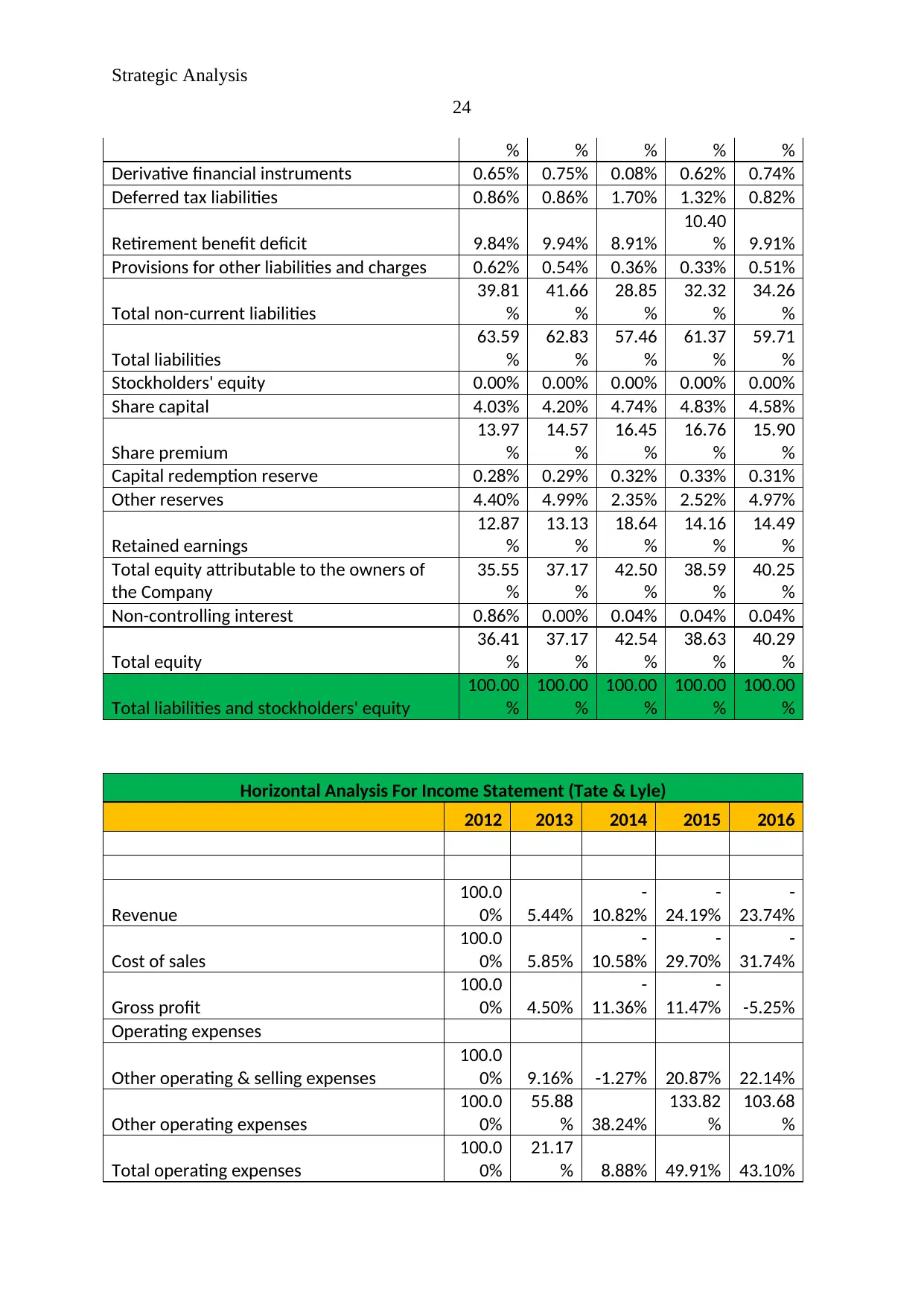
Strategic Analysis
24
% % % % %
Derivative financial instruments 0.65% 0.75% 0.08% 0.62% 0.74%
Deferred tax liabilities 0.86% 0.86% 1.70% 1.32% 0.82%
Retirement benefit deficit 9.84% 9.94% 8.91%
10.40
% 9.91%
Provisions for other liabilities and charges 0.62% 0.54% 0.36% 0.33% 0.51%
Total non-current liabilities
39.81
%
41.66
%
28.85
%
32.32
%
34.26
%
Total liabilities
63.59
%
62.83
%
57.46
%
61.37
%
59.71
%
Stockholders' equity 0.00% 0.00% 0.00% 0.00% 0.00%
Share capital 4.03% 4.20% 4.74% 4.83% 4.58%
Share premium
13.97
%
14.57
%
16.45
%
16.76
%
15.90
%
Capital redemption reserve 0.28% 0.29% 0.32% 0.33% 0.31%
Other reserves 4.40% 4.99% 2.35% 2.52% 4.97%
Retained earnings
12.87
%
13.13
%
18.64
%
14.16
%
14.49
%
Total equity attributable to the owners of
the Company
35.55
%
37.17
%
42.50
%
38.59
%
40.25
%
Non-controlling interest 0.86% 0.00% 0.04% 0.04% 0.04%
Total equity
36.41
%
37.17
%
42.54
%
38.63
%
40.29
%
Total liabilities and stockholders' equity
100.00
%
100.00
%
100.00
%
100.00
%
100.00
%
Horizontal Analysis For Income Statement (Tate & Lyle)
2012 2013 2014 2015 2016
Revenue
100.0
0% 5.44%
-
10.82%
-
24.19%
-
23.74%
Cost of sales
100.0
0% 5.85%
-
10.58%
-
29.70%
-
31.74%
Gross profit
100.0
0% 4.50%
-
11.36%
-
11.47% -5.25%
Operating expenses
Other operating & selling expenses
100.0
0% 9.16% -1.27% 20.87% 22.14%
Other operating expenses
100.0
0%
55.88
% 38.24%
133.82
%
103.68
%
Total operating expenses
100.0
0%
21.17
% 8.88% 49.91% 43.10%
24
% % % % %
Derivative financial instruments 0.65% 0.75% 0.08% 0.62% 0.74%
Deferred tax liabilities 0.86% 0.86% 1.70% 1.32% 0.82%
Retirement benefit deficit 9.84% 9.94% 8.91%
10.40
% 9.91%
Provisions for other liabilities and charges 0.62% 0.54% 0.36% 0.33% 0.51%
Total non-current liabilities
39.81
%
41.66
%
28.85
%
32.32
%
34.26
%
Total liabilities
63.59
%
62.83
%
57.46
%
61.37
%
59.71
%
Stockholders' equity 0.00% 0.00% 0.00% 0.00% 0.00%
Share capital 4.03% 4.20% 4.74% 4.83% 4.58%
Share premium
13.97
%
14.57
%
16.45
%
16.76
%
15.90
%
Capital redemption reserve 0.28% 0.29% 0.32% 0.33% 0.31%
Other reserves 4.40% 4.99% 2.35% 2.52% 4.97%
Retained earnings
12.87
%
13.13
%
18.64
%
14.16
%
14.49
%
Total equity attributable to the owners of
the Company
35.55
%
37.17
%
42.50
%
38.59
%
40.25
%
Non-controlling interest 0.86% 0.00% 0.04% 0.04% 0.04%
Total equity
36.41
%
37.17
%
42.54
%
38.63
%
40.29
%
Total liabilities and stockholders' equity
100.00
%
100.00
%
100.00
%
100.00
%
100.00
%
Horizontal Analysis For Income Statement (Tate & Lyle)
2012 2013 2014 2015 2016
Revenue
100.0
0% 5.44%
-
10.82%
-
24.19%
-
23.74%
Cost of sales
100.0
0% 5.85%
-
10.58%
-
29.70%
-
31.74%
Gross profit
100.0
0% 4.50%
-
11.36%
-
11.47% -5.25%
Operating expenses
Other operating & selling expenses
100.0
0% 9.16% -1.27% 20.87% 22.14%
Other operating expenses
100.0
0%
55.88
% 38.24%
133.82
%
103.68
%
Total operating expenses
100.0
0%
21.17
% 8.88% 49.91% 43.10%
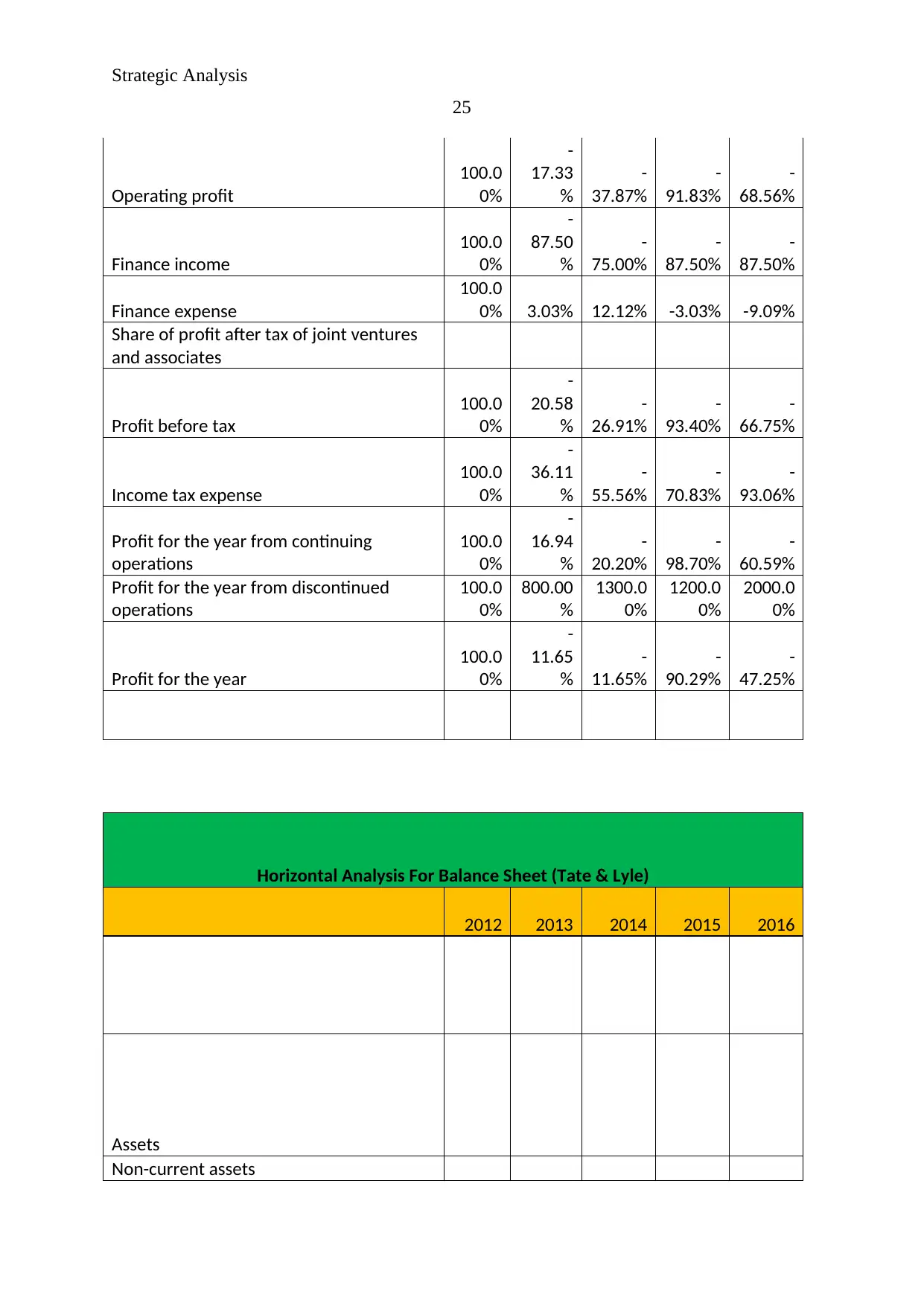
Strategic Analysis
25
Operating profit
100.0
0%
-
17.33
%
-
37.87%
-
91.83%
-
68.56%
Finance income
100.0
0%
-
87.50
%
-
75.00%
-
87.50%
-
87.50%
Finance expense
100.0
0% 3.03% 12.12% -3.03% -9.09%
Share of profit after tax of joint ventures
and associates
Profit before tax
100.0
0%
-
20.58
%
-
26.91%
-
93.40%
-
66.75%
Income tax expense
100.0
0%
-
36.11
%
-
55.56%
-
70.83%
-
93.06%
Profit for the year from continuing
operations
100.0
0%
-
16.94
%
-
20.20%
-
98.70%
-
60.59%
Profit for the year from discontinued
operations
100.0
0%
800.00
%
1300.0
0%
1200.0
0%
2000.0
0%
Profit for the year
100.0
0%
-
11.65
%
-
11.65%
-
90.29%
-
47.25%
Horizontal Analysis For Balance Sheet (Tate & Lyle)
2012 2013 2014 2015 2016
Assets
Non-current assets
25
Operating profit
100.0
0%
-
17.33
%
-
37.87%
-
91.83%
-
68.56%
Finance income
100.0
0%
-
87.50
%
-
75.00%
-
87.50%
-
87.50%
Finance expense
100.0
0% 3.03% 12.12% -3.03% -9.09%
Share of profit after tax of joint ventures
and associates
Profit before tax
100.0
0%
-
20.58
%
-
26.91%
-
93.40%
-
66.75%
Income tax expense
100.0
0%
-
36.11
%
-
55.56%
-
70.83%
-
93.06%
Profit for the year from continuing
operations
100.0
0%
-
16.94
%
-
20.20%
-
98.70%
-
60.59%
Profit for the year from discontinued
operations
100.0
0%
800.00
%
1300.0
0%
1200.0
0%
2000.0
0%
Profit for the year
100.0
0%
-
11.65
%
-
11.65%
-
90.29%
-
47.25%
Horizontal Analysis For Balance Sheet (Tate & Lyle)
2012 2013 2014 2015 2016
Assets
Non-current assets
Paraphrase This Document
Need a fresh take? Get an instant paraphrase of this document with our AI Paraphraser
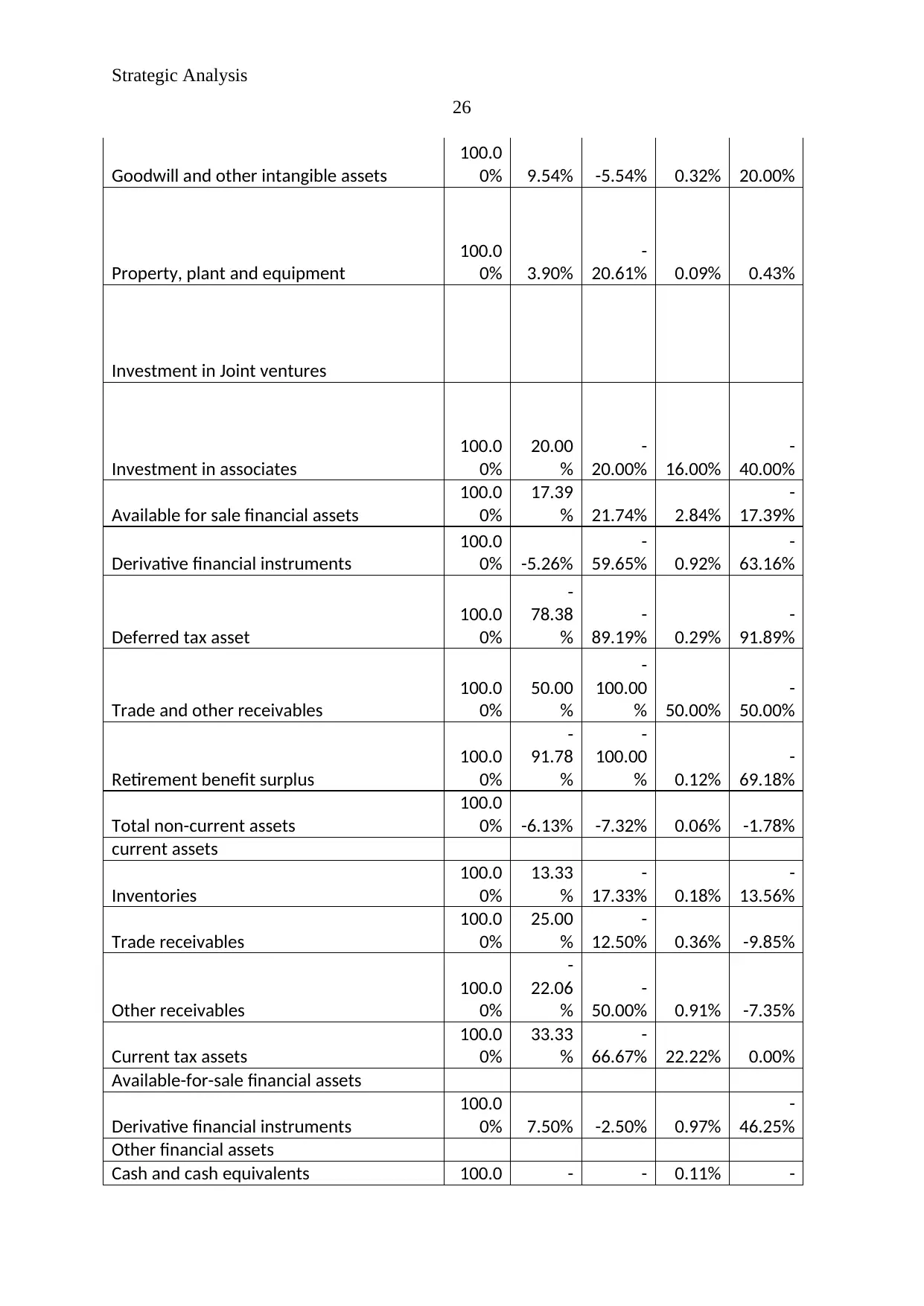
Strategic Analysis
26
Goodwill and other intangible assets
100.0
0% 9.54% -5.54% 0.32% 20.00%
Property, plant and equipment
100.0
0% 3.90%
-
20.61% 0.09% 0.43%
Investment in Joint ventures
Investment in associates
100.0
0%
20.00
%
-
20.00% 16.00%
-
40.00%
Available for sale financial assets
100.0
0%
17.39
% 21.74% 2.84%
-
17.39%
Derivative financial instruments
100.0
0% -5.26%
-
59.65% 0.92%
-
63.16%
Deferred tax asset
100.0
0%
-
78.38
%
-
89.19% 0.29%
-
91.89%
Trade and other receivables
100.0
0%
50.00
%
-
100.00
% 50.00%
-
50.00%
Retirement benefit surplus
100.0
0%
-
91.78
%
-
100.00
% 0.12%
-
69.18%
Total non-current assets
100.0
0% -6.13% -7.32% 0.06% -1.78%
current assets
Inventories
100.0
0%
13.33
%
-
17.33% 0.18%
-
13.56%
Trade receivables
100.0
0%
25.00
%
-
12.50% 0.36% -9.85%
Other receivables
100.0
0%
-
22.06
%
-
50.00% 0.91% -7.35%
Current tax assets
100.0
0%
33.33
%
-
66.67% 22.22% 0.00%
Available-for-sale financial assets
Derivative financial instruments
100.0
0% 7.50% -2.50% 0.97%
-
46.25%
Other financial assets
Cash and cash equivalents 100.0 - - 0.11% -
26
Goodwill and other intangible assets
100.0
0% 9.54% -5.54% 0.32% 20.00%
Property, plant and equipment
100.0
0% 3.90%
-
20.61% 0.09% 0.43%
Investment in Joint ventures
Investment in associates
100.0
0%
20.00
%
-
20.00% 16.00%
-
40.00%
Available for sale financial assets
100.0
0%
17.39
% 21.74% 2.84%
-
17.39%
Derivative financial instruments
100.0
0% -5.26%
-
59.65% 0.92%
-
63.16%
Deferred tax asset
100.0
0%
-
78.38
%
-
89.19% 0.29%
-
91.89%
Trade and other receivables
100.0
0%
50.00
%
-
100.00
% 50.00%
-
50.00%
Retirement benefit surplus
100.0
0%
-
91.78
%
-
100.00
% 0.12%
-
69.18%
Total non-current assets
100.0
0% -6.13% -7.32% 0.06% -1.78%
current assets
Inventories
100.0
0%
13.33
%
-
17.33% 0.18%
-
13.56%
Trade receivables
100.0
0%
25.00
%
-
12.50% 0.36% -9.85%
Other receivables
100.0
0%
-
22.06
%
-
50.00% 0.91% -7.35%
Current tax assets
100.0
0%
33.33
%
-
66.67% 22.22% 0.00%
Available-for-sale financial assets
Derivative financial instruments
100.0
0% 7.50% -2.50% 0.97%
-
46.25%
Other financial assets
Cash and cash equivalents 100.0 - - 0.11% -
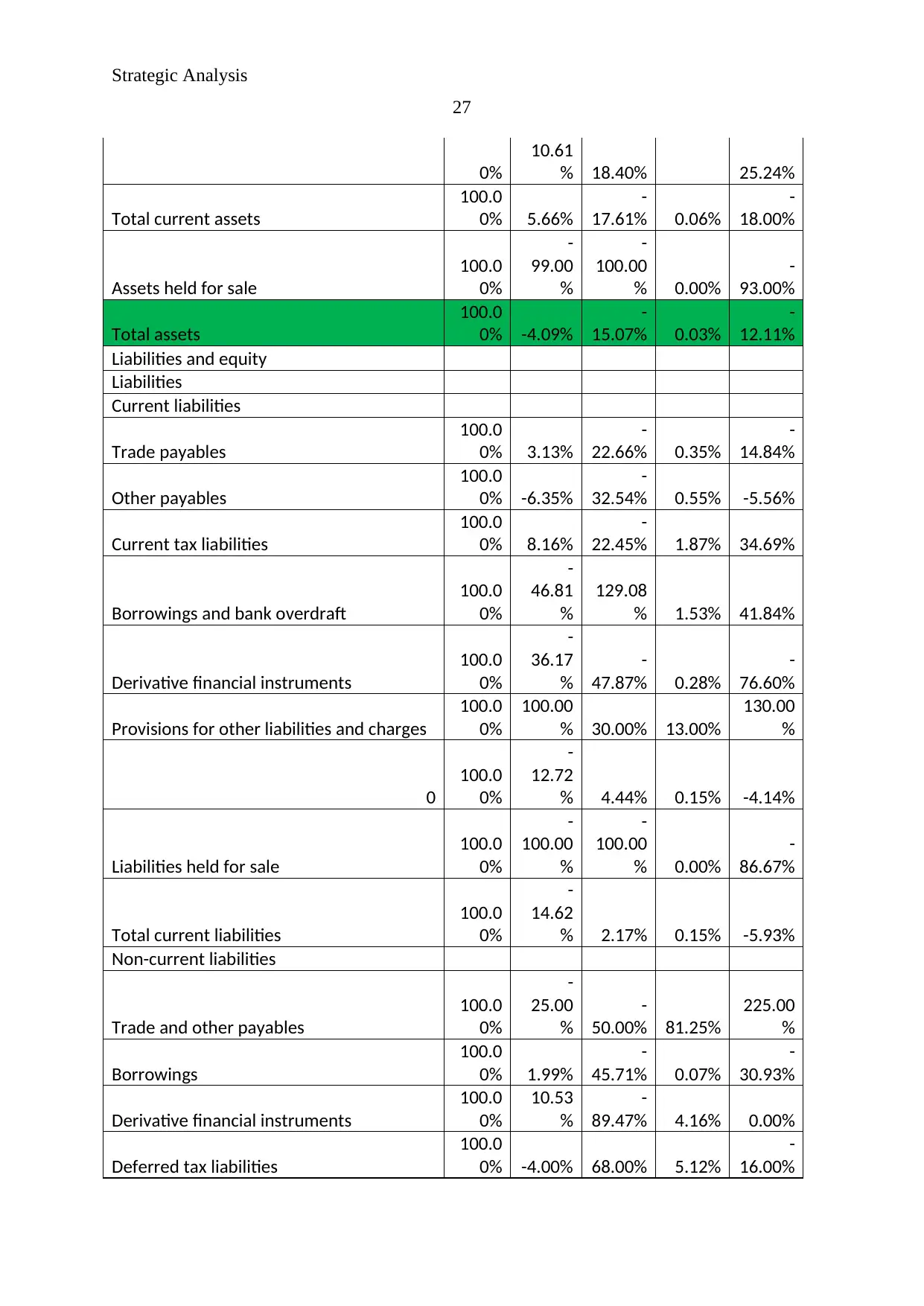
Strategic Analysis
27
0%
10.61
% 18.40% 25.24%
Total current assets
100.0
0% 5.66%
-
17.61% 0.06%
-
18.00%
Assets held for sale
100.0
0%
-
99.00
%
-
100.00
% 0.00%
-
93.00%
Total assets
100.0
0% -4.09%
-
15.07% 0.03%
-
12.11%
Liabilities and equity
Liabilities
Current liabilities
Trade payables
100.0
0% 3.13%
-
22.66% 0.35%
-
14.84%
Other payables
100.0
0% -6.35%
-
32.54% 0.55% -5.56%
Current tax liabilities
100.0
0% 8.16%
-
22.45% 1.87% 34.69%
Borrowings and bank overdraft
100.0
0%
-
46.81
%
129.08
% 1.53% 41.84%
Derivative financial instruments
100.0
0%
-
36.17
%
-
47.87% 0.28%
-
76.60%
Provisions for other liabilities and charges
100.0
0%
100.00
% 30.00% 13.00%
130.00
%
0
100.0
0%
-
12.72
% 4.44% 0.15% -4.14%
Liabilities held for sale
100.0
0%
-
100.00
%
-
100.00
% 0.00%
-
86.67%
Total current liabilities
100.0
0%
-
14.62
% 2.17% 0.15% -5.93%
Non-current liabilities
Trade and other payables
100.0
0%
-
25.00
%
-
50.00% 81.25%
225.00
%
Borrowings
100.0
0% 1.99%
-
45.71% 0.07%
-
30.93%
Derivative financial instruments
100.0
0%
10.53
%
-
89.47% 4.16% 0.00%
Deferred tax liabilities
100.0
0% -4.00% 68.00% 5.12%
-
16.00%
27
0%
10.61
% 18.40% 25.24%
Total current assets
100.0
0% 5.66%
-
17.61% 0.06%
-
18.00%
Assets held for sale
100.0
0%
-
99.00
%
-
100.00
% 0.00%
-
93.00%
Total assets
100.0
0% -4.09%
-
15.07% 0.03%
-
12.11%
Liabilities and equity
Liabilities
Current liabilities
Trade payables
100.0
0% 3.13%
-
22.66% 0.35%
-
14.84%
Other payables
100.0
0% -6.35%
-
32.54% 0.55% -5.56%
Current tax liabilities
100.0
0% 8.16%
-
22.45% 1.87% 34.69%
Borrowings and bank overdraft
100.0
0%
-
46.81
%
129.08
% 1.53% 41.84%
Derivative financial instruments
100.0
0%
-
36.17
%
-
47.87% 0.28%
-
76.60%
Provisions for other liabilities and charges
100.0
0%
100.00
% 30.00% 13.00%
130.00
%
0
100.0
0%
-
12.72
% 4.44% 0.15% -4.14%
Liabilities held for sale
100.0
0%
-
100.00
%
-
100.00
% 0.00%
-
86.67%
Total current liabilities
100.0
0%
-
14.62
% 2.17% 0.15% -5.93%
Non-current liabilities
Trade and other payables
100.0
0%
-
25.00
%
-
50.00% 81.25%
225.00
%
Borrowings
100.0
0% 1.99%
-
45.71% 0.07%
-
30.93%
Derivative financial instruments
100.0
0%
10.53
%
-
89.47% 4.16% 0.00%
Deferred tax liabilities
100.0
0% -4.00% 68.00% 5.12%
-
16.00%
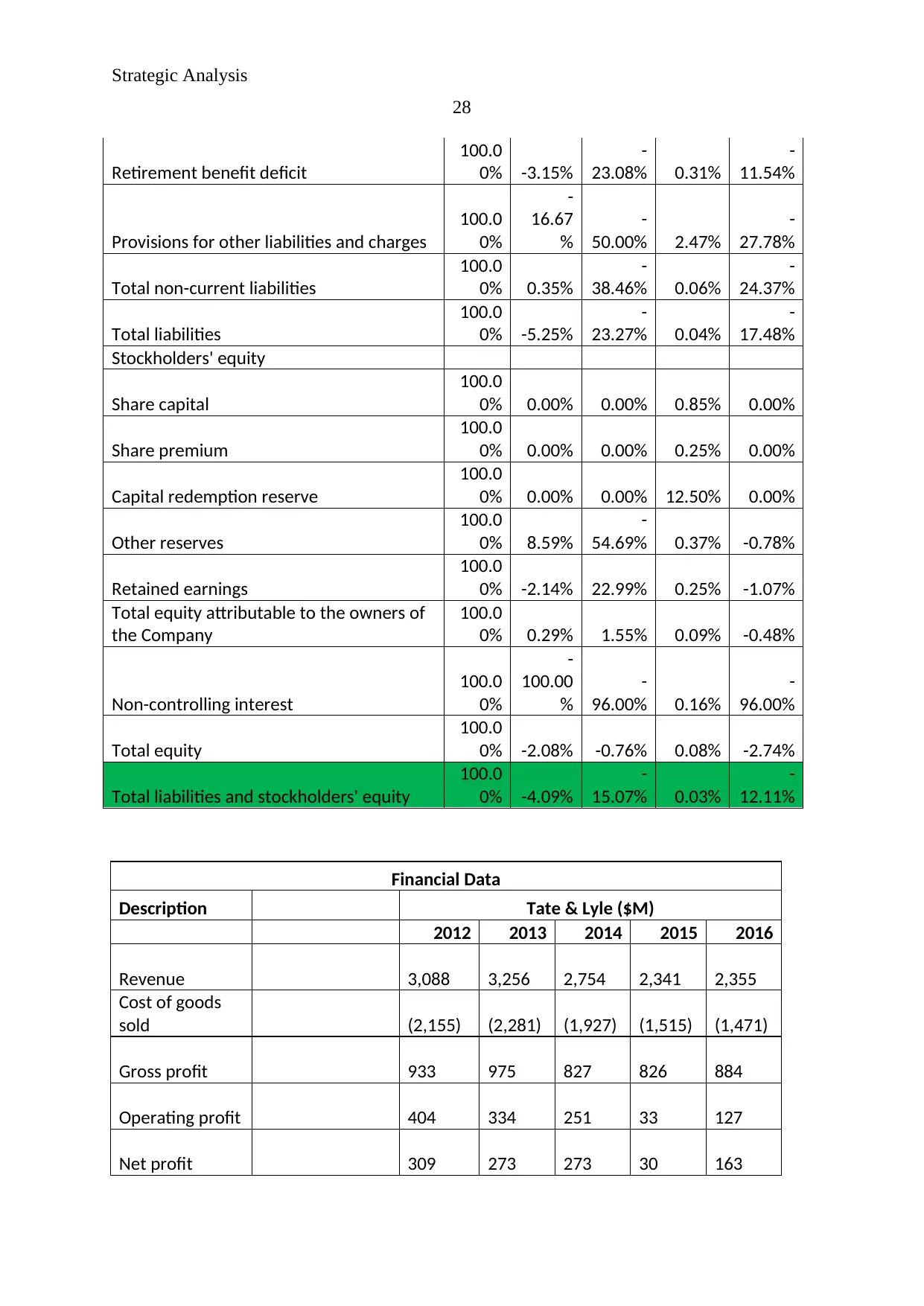
Strategic Analysis
28
Retirement benefit deficit
100.0
0% -3.15%
-
23.08% 0.31%
-
11.54%
Provisions for other liabilities and charges
100.0
0%
-
16.67
%
-
50.00% 2.47%
-
27.78%
Total non-current liabilities
100.0
0% 0.35%
-
38.46% 0.06%
-
24.37%
Total liabilities
100.0
0% -5.25%
-
23.27% 0.04%
-
17.48%
Stockholders' equity
Share capital
100.0
0% 0.00% 0.00% 0.85% 0.00%
Share premium
100.0
0% 0.00% 0.00% 0.25% 0.00%
Capital redemption reserve
100.0
0% 0.00% 0.00% 12.50% 0.00%
Other reserves
100.0
0% 8.59%
-
54.69% 0.37% -0.78%
Retained earnings
100.0
0% -2.14% 22.99% 0.25% -1.07%
Total equity attributable to the owners of
the Company
100.0
0% 0.29% 1.55% 0.09% -0.48%
Non-controlling interest
100.0
0%
-
100.00
%
-
96.00% 0.16%
-
96.00%
Total equity
100.0
0% -2.08% -0.76% 0.08% -2.74%
Total liabilities and stockholders' equity
100.0
0% -4.09%
-
15.07% 0.03%
-
12.11%
Financial Data
Description Tate & Lyle ($M)
2012 2013 2014 2015 2016
Revenue 3,088 3,256 2,754 2,341 2,355
Cost of goods
sold (2,155) (2,281) (1,927) (1,515) (1,471)
Gross profit 933 975 827 826 884
Operating profit 404 334 251 33 127
Net profit 309 273 273 30 163
28
Retirement benefit deficit
100.0
0% -3.15%
-
23.08% 0.31%
-
11.54%
Provisions for other liabilities and charges
100.0
0%
-
16.67
%
-
50.00% 2.47%
-
27.78%
Total non-current liabilities
100.0
0% 0.35%
-
38.46% 0.06%
-
24.37%
Total liabilities
100.0
0% -5.25%
-
23.27% 0.04%
-
17.48%
Stockholders' equity
Share capital
100.0
0% 0.00% 0.00% 0.85% 0.00%
Share premium
100.0
0% 0.00% 0.00% 0.25% 0.00%
Capital redemption reserve
100.0
0% 0.00% 0.00% 12.50% 0.00%
Other reserves
100.0
0% 8.59%
-
54.69% 0.37% -0.78%
Retained earnings
100.0
0% -2.14% 22.99% 0.25% -1.07%
Total equity attributable to the owners of
the Company
100.0
0% 0.29% 1.55% 0.09% -0.48%
Non-controlling interest
100.0
0%
-
100.00
%
-
96.00% 0.16%
-
96.00%
Total equity
100.0
0% -2.08% -0.76% 0.08% -2.74%
Total liabilities and stockholders' equity
100.0
0% -4.09%
-
15.07% 0.03%
-
12.11%
Financial Data
Description Tate & Lyle ($M)
2012 2013 2014 2015 2016
Revenue 3,088 3,256 2,754 2,341 2,355
Cost of goods
sold (2,155) (2,281) (1,927) (1,515) (1,471)
Gross profit 933 975 827 826 884
Operating profit 404 334 251 33 127
Net profit 309 273 273 30 163
Secure Best Marks with AI Grader
Need help grading? Try our AI Grader for instant feedback on your assignments.
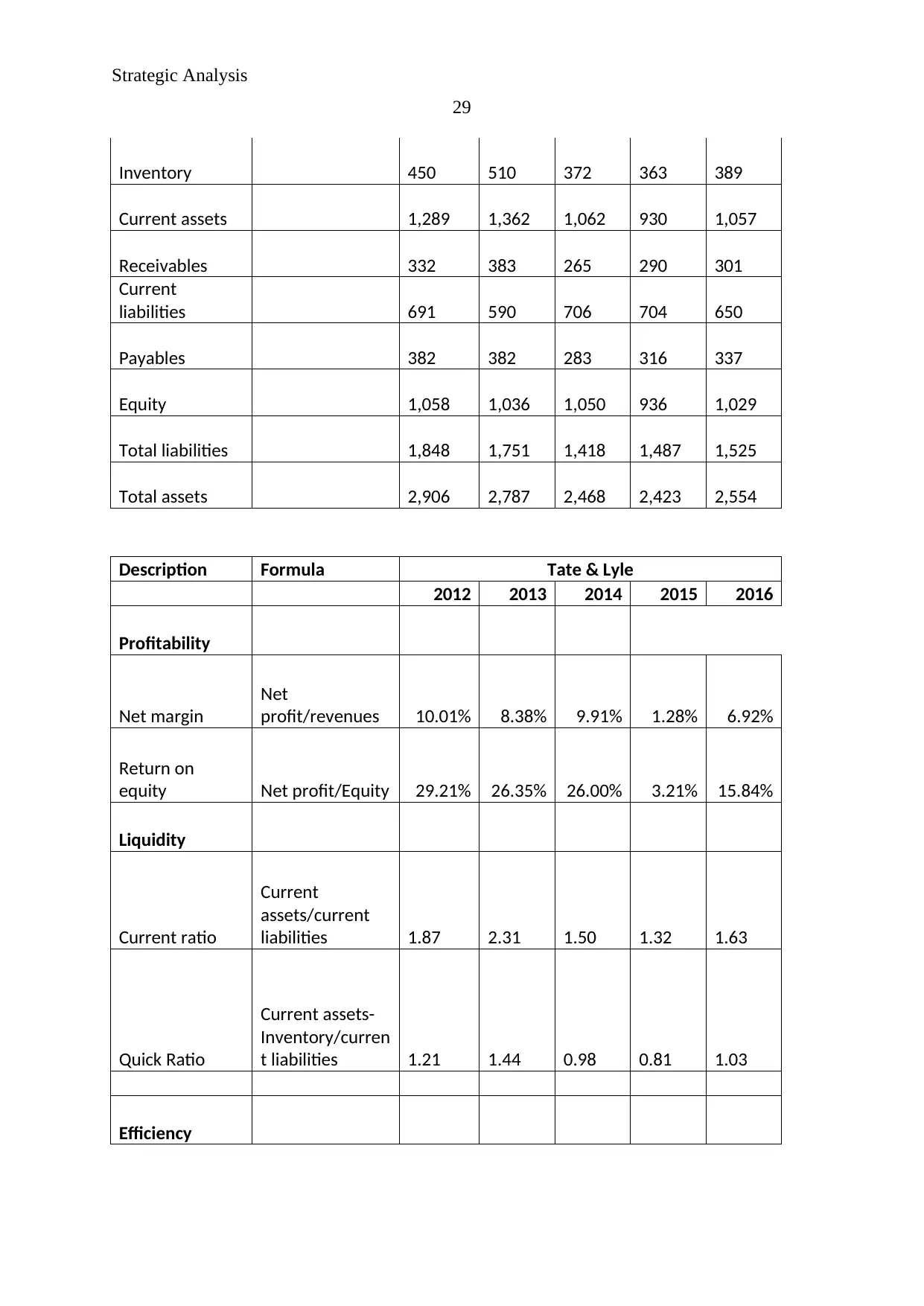
Strategic Analysis
29
Inventory 450 510 372 363 389
Current assets 1,289 1,362 1,062 930 1,057
Receivables 332 383 265 290 301
Current
liabilities 691 590 706 704 650
Payables 382 382 283 316 337
Equity 1,058 1,036 1,050 936 1,029
Total liabilities 1,848 1,751 1,418 1,487 1,525
Total assets 2,906 2,787 2,468 2,423 2,554
Description Formula Tate & Lyle
2012 2013 2014 2015 2016
Profitability
Net margin
Net
profit/revenues 10.01% 8.38% 9.91% 1.28% 6.92%
Return on
equity Net profit/Equity 29.21% 26.35% 26.00% 3.21% 15.84%
Liquidity
Current ratio
Current
assets/current
liabilities 1.87 2.31 1.50 1.32 1.63
Quick Ratio
Current assets-
Inventory/curren
t liabilities 1.21 1.44 0.98 0.81 1.03
Efficiency
29
Inventory 450 510 372 363 389
Current assets 1,289 1,362 1,062 930 1,057
Receivables 332 383 265 290 301
Current
liabilities 691 590 706 704 650
Payables 382 382 283 316 337
Equity 1,058 1,036 1,050 936 1,029
Total liabilities 1,848 1,751 1,418 1,487 1,525
Total assets 2,906 2,787 2,468 2,423 2,554
Description Formula Tate & Lyle
2012 2013 2014 2015 2016
Profitability
Net margin
Net
profit/revenues 10.01% 8.38% 9.91% 1.28% 6.92%
Return on
equity Net profit/Equity 29.21% 26.35% 26.00% 3.21% 15.84%
Liquidity
Current ratio
Current
assets/current
liabilities 1.87 2.31 1.50 1.32 1.63
Quick Ratio
Current assets-
Inventory/curren
t liabilities 1.21 1.44 0.98 0.81 1.03
Efficiency

Strategic Analysis
30
Receivables
collection
period
Receivables/
Total sales*365 39.24 42.93 35.12 45.22 46.65
Payables
collection
period
Payables/ Cost
of sales*365 (64.70) (61.13) (53.60) (76.13) (83.62)
Asset turnover
ratio
Total sales/ Total
assets 1.06 1.17 1.12 0.97 0.92
Solvency
Debt to Equity
Ratio Debt/ Equity 1.75 1.69 1.35 1.59 1.48
Debt to assets
Debt/ Total
assets 0.64 0.63 0.57 0.61 0.60
Wolseley
Group income statement
2012 2013 2014 2015 2016
Revenue 13,421 13,154 12,271 13,332 14,430
Cost of sales (9,724) (9,500) (8,863) (9,604) (10,351)
Gross profit 3,697 3,654 3,408 3,728 4,079
Operating costs
Total operating costs (3,485) (3,158) (2,703) (3,172) (3,312)
Operating profit 212 496 705 556 767
Finance income 2 3 1 1 -
30
Receivables
collection
period
Receivables/
Total sales*365 39.24 42.93 35.12 45.22 46.65
Payables
collection
period
Payables/ Cost
of sales*365 (64.70) (61.13) (53.60) (76.13) (83.62)
Asset turnover
ratio
Total sales/ Total
assets 1.06 1.17 1.12 0.97 0.92
Solvency
Debt to Equity
Ratio Debt/ Equity 1.75 1.69 1.35 1.59 1.48
Debt to assets
Debt/ Total
assets 0.64 0.63 0.57 0.61 0.60
Wolseley
Group income statement
2012 2013 2014 2015 2016
Revenue 13,421 13,154 12,271 13,332 14,430
Cost of sales (9,724) (9,500) (8,863) (9,604) (10,351)
Gross profit 3,697 3,654 3,408 3,728 4,079
Operating costs
Total operating costs (3,485) (3,158) (2,703) (3,172) (3,312)
Operating profit 212 496 705 556 767
Finance income 2 3 1 1 -
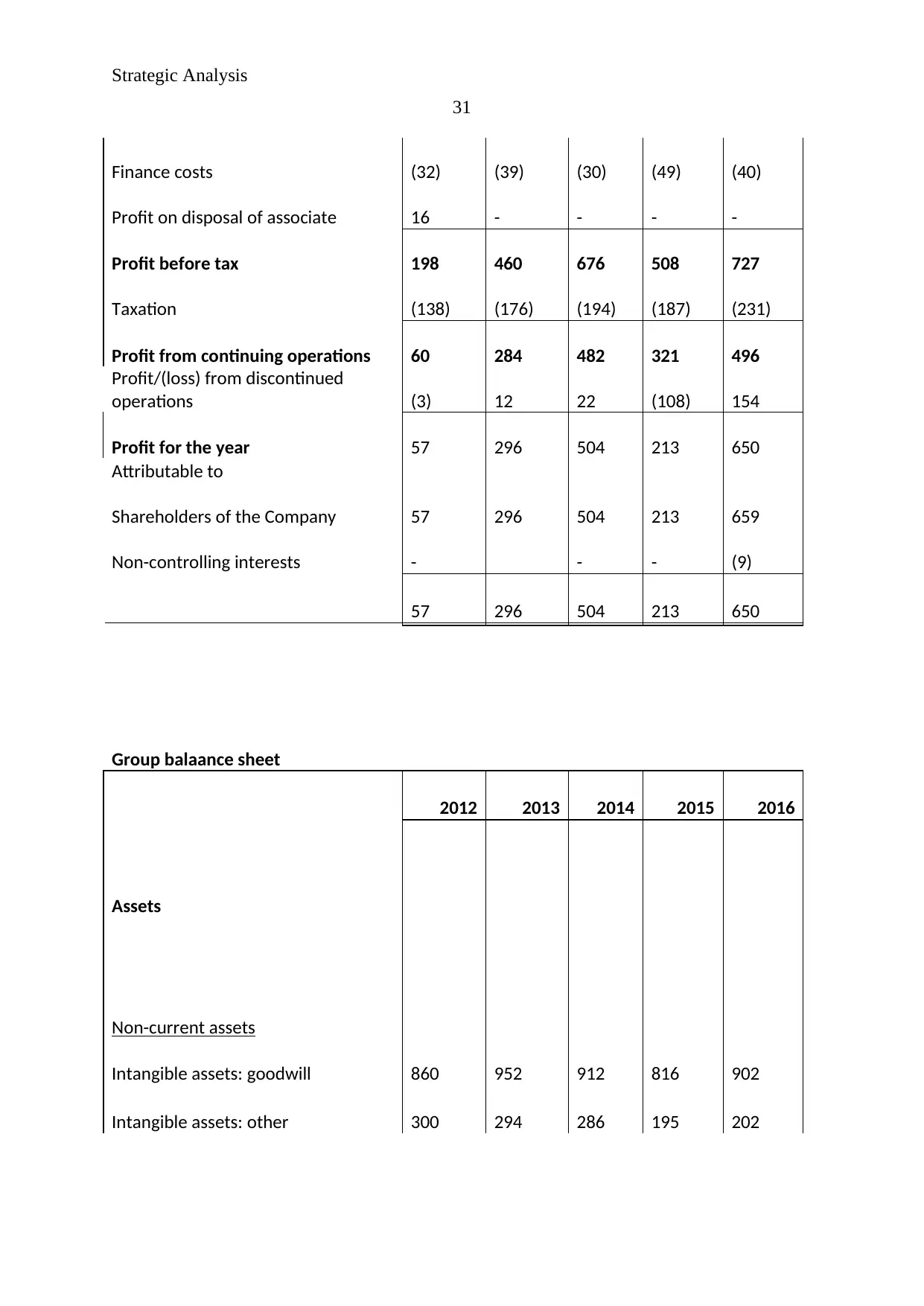
Strategic Analysis
31
Finance costs (32) (39) (30) (49) (40)
Profit on disposal of associate 16 - - - -
Profit before tax 198 460 676 508 727
Taxation (138) (176) (194) (187) (231)
Profit from continuing operations 60 284 482 321 496
Profit/(loss) from discontinued
operations (3) 12 22 (108) 154
Profit for the year 57 296 504 213 650
Attributable to
Shareholders of the Company 57 296 504 213 659
Non-controlling interests - - - (9)
57 296 504 213 650
Group balaance sheet
2012 2013 2014 2015 2016
Assets
Non-current assets
Intangible assets: goodwill 860 952 912 816 902
Intangible assets: other 300 294 286 195 202
31
Finance costs (32) (39) (30) (49) (40)
Profit on disposal of associate 16 - - - -
Profit before tax 198 460 676 508 727
Taxation (138) (176) (194) (187) (231)
Profit from continuing operations 60 284 482 321 496
Profit/(loss) from discontinued
operations (3) 12 22 (108) 154
Profit for the year 57 296 504 213 650
Attributable to
Shareholders of the Company 57 296 504 213 659
Non-controlling interests - - - (9)
57 296 504 213 650
Group balaance sheet
2012 2013 2014 2015 2016
Assets
Non-current assets
Intangible assets: goodwill 860 952 912 816 902
Intangible assets: other 300 294 286 195 202
Paraphrase This Document
Need a fresh take? Get an instant paraphrase of this document with our AI Paraphraser
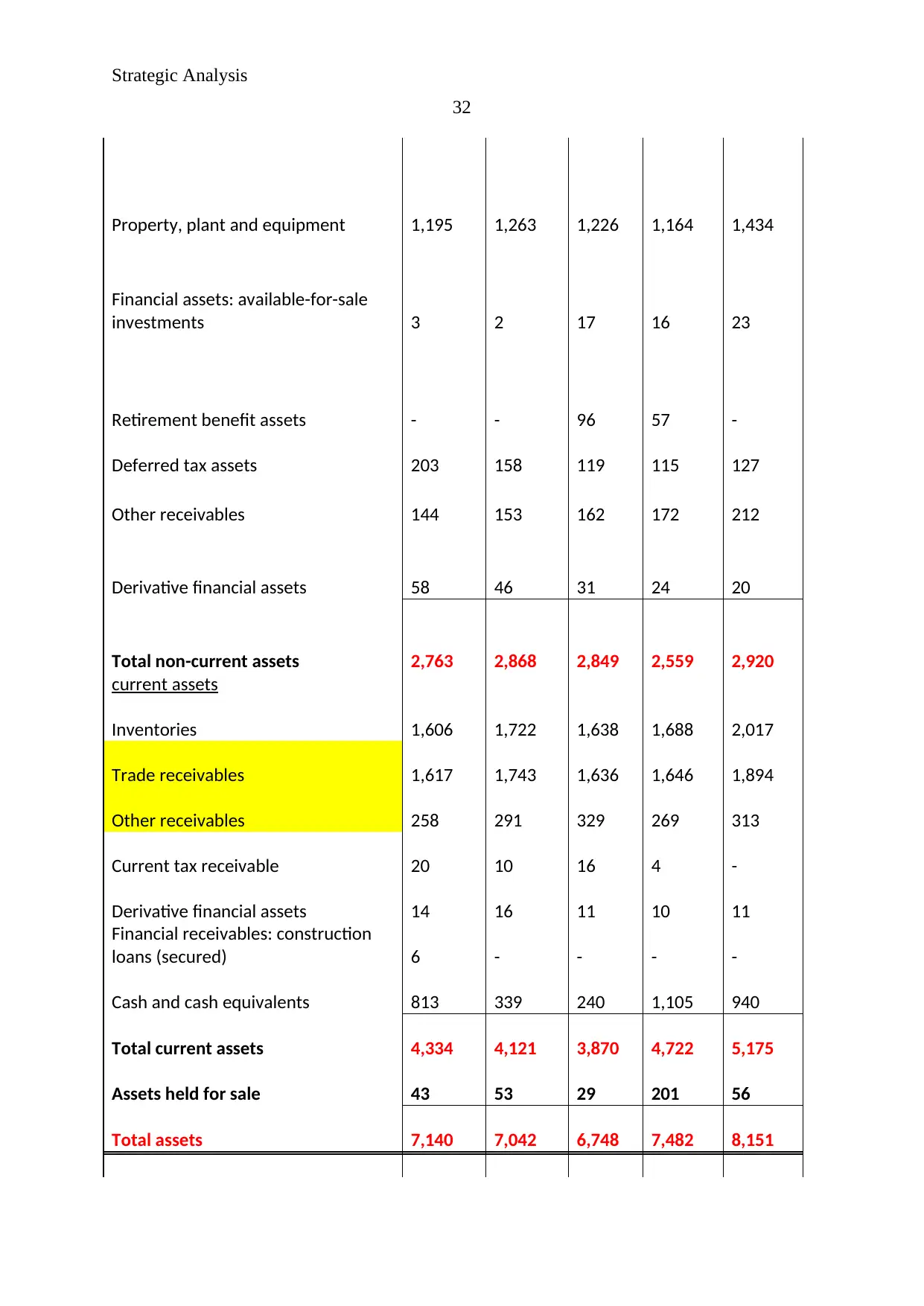
Strategic Analysis
32
Property, plant and equipment 1,195 1,263 1,226 1,164 1,434
Financial assets: available-for-sale
investments 3 2 17 16 23
Retirement benefit assets - - 96 57 -
Deferred tax assets 203 158 119 115 127
Other receivables 144 153 162 172 212
Derivative financial assets 58 46 31 24 20
Total non-current assets 2,763 2,868 2,849 2,559 2,920
current assets
Inventories 1,606 1,722 1,638 1,688 2,017
Trade receivables 1,617 1,743 1,636 1,646 1,894
Other receivables 258 291 329 269 313
Current tax receivable 20 10 16 4 -
Derivative financial assets 14 16 11 10 11
Financial receivables: construction
loans (secured) 6 - - - -
Cash and cash equivalents 813 339 240 1,105 940
Total current assets 4,334 4,121 3,870 4,722 5,175
Assets held for sale 43 53 29 201 56
Total assets 7,140 7,042 6,748 7,482 8,151
32
Property, plant and equipment 1,195 1,263 1,226 1,164 1,434
Financial assets: available-for-sale
investments 3 2 17 16 23
Retirement benefit assets - - 96 57 -
Deferred tax assets 203 158 119 115 127
Other receivables 144 153 162 172 212
Derivative financial assets 58 46 31 24 20
Total non-current assets 2,763 2,868 2,849 2,559 2,920
current assets
Inventories 1,606 1,722 1,638 1,688 2,017
Trade receivables 1,617 1,743 1,636 1,646 1,894
Other receivables 258 291 329 269 313
Current tax receivable 20 10 16 4 -
Derivative financial assets 14 16 11 10 11
Financial receivables: construction
loans (secured) 6 - - - -
Cash and cash equivalents 813 339 240 1,105 940
Total current assets 4,334 4,121 3,870 4,722 5,175
Assets held for sale 43 53 29 201 56
Total assets 7,140 7,042 6,748 7,482 8,151
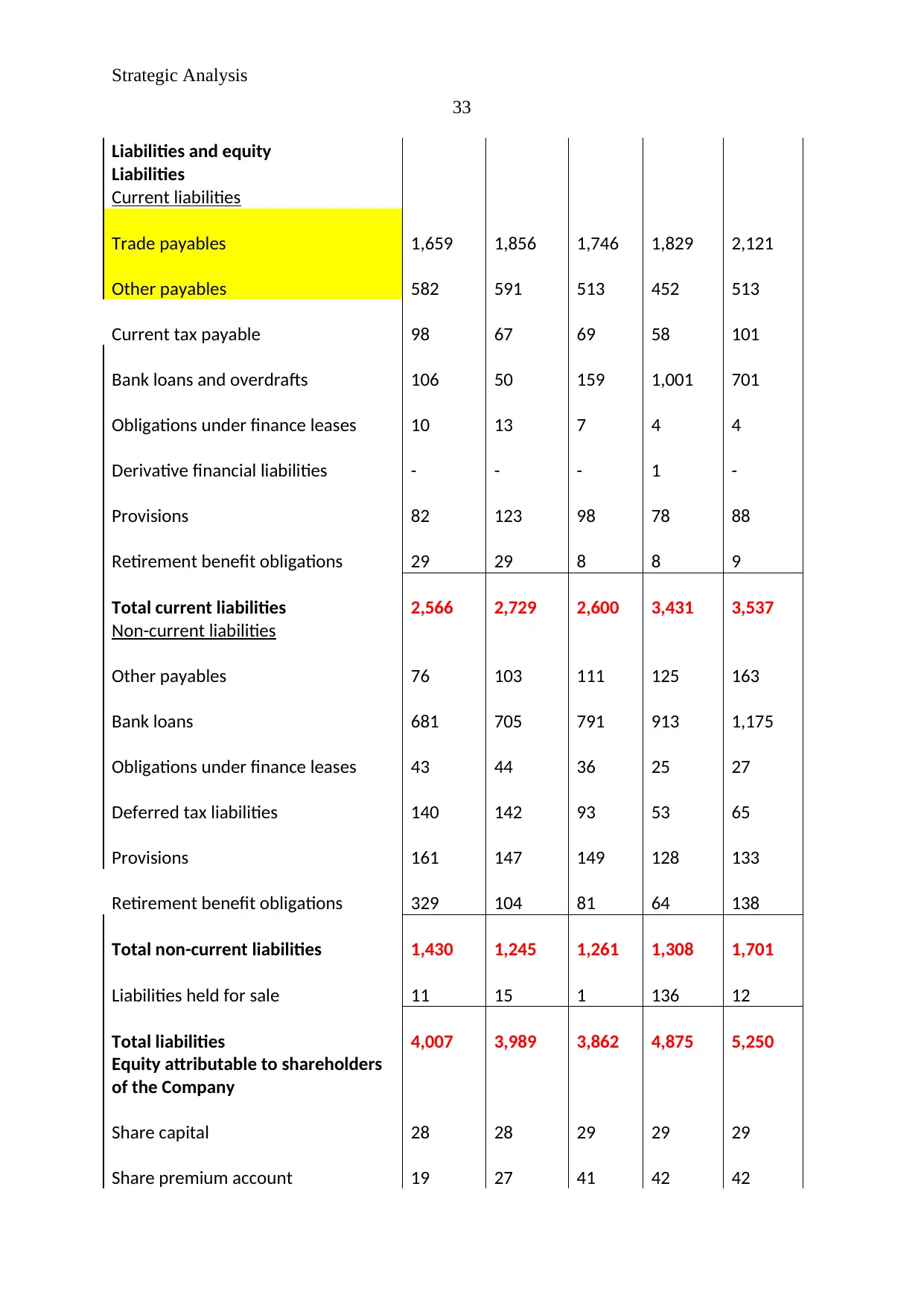
Strategic Analysis
33
Liabilities and equity
Liabilities
Current liabilities
Trade payables 1,659 1,856 1,746 1,829 2,121
Other payables 582 591 513 452 513
Current tax payable 98 67 69 58 101
Bank loans and overdrafts 106 50 159 1,001 701
Obligations under finance leases 10 13 7 4 4
Derivative financial liabilities - - - 1 -
Provisions 82 123 98 78 88
Retirement benefit obligations 29 29 8 8 9
Total current liabilities 2,566 2,729 2,600 3,431 3,537
Non-current liabilities
Other payables 76 103 111 125 163
Bank loans 681 705 791 913 1,175
Obligations under finance leases 43 44 36 25 27
Deferred tax liabilities 140 142 93 53 65
Provisions 161 147 149 128 133
Retirement benefit obligations 329 104 81 64 138
Total non-current liabilities 1,430 1,245 1,261 1,308 1,701
Liabilities held for sale 11 15 1 136 12
Total liabilities 4,007 3,989 3,862 4,875 5,250
Equity attributable to shareholders
of the Company
Share capital 28 28 29 29 29
Share premium account 19 27 41 42 42
33
Liabilities and equity
Liabilities
Current liabilities
Trade payables 1,659 1,856 1,746 1,829 2,121
Other payables 582 591 513 452 513
Current tax payable 98 67 69 58 101
Bank loans and overdrafts 106 50 159 1,001 701
Obligations under finance leases 10 13 7 4 4
Derivative financial liabilities - - - 1 -
Provisions 82 123 98 78 88
Retirement benefit obligations 29 29 8 8 9
Total current liabilities 2,566 2,729 2,600 3,431 3,537
Non-current liabilities
Other payables 76 103 111 125 163
Bank loans 681 705 791 913 1,175
Obligations under finance leases 43 44 36 25 27
Deferred tax liabilities 140 142 93 53 65
Provisions 161 147 149 128 133
Retirement benefit obligations 329 104 81 64 138
Total non-current liabilities 1,430 1,245 1,261 1,308 1,701
Liabilities held for sale 11 15 1 136 12
Total liabilities 4,007 3,989 3,862 4,875 5,250
Equity attributable to shareholders
of the Company
Share capital 28 28 29 29 29
Share premium account 19 27 41 42 42
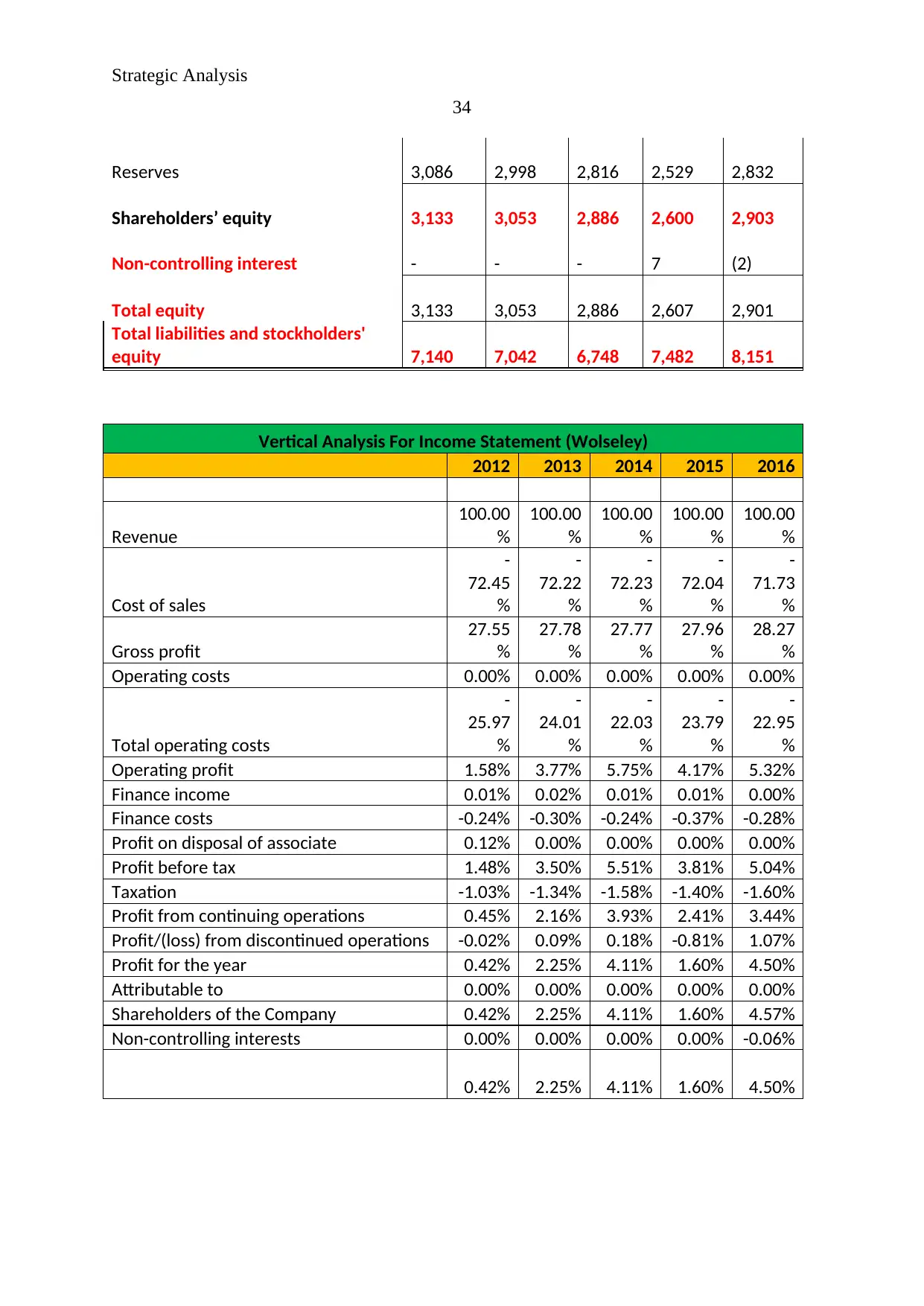
Strategic Analysis
34
Reserves 3,086 2,998 2,816 2,529 2,832
Shareholders’ equity 3,133 3,053 2,886 2,600 2,903
Non-controlling interest - - - 7 (2)
Total equity 3,133 3,053 2,886 2,607 2,901
Total liabilities and stockholders'
equity 7,140 7,042 6,748 7,482 8,151
Vertical Analysis For Income Statement (Wolseley)
2012 2013 2014 2015 2016
Revenue
100.00
%
100.00
%
100.00
%
100.00
%
100.00
%
Cost of sales
-
72.45
%
-
72.22
%
-
72.23
%
-
72.04
%
-
71.73
%
Gross profit
27.55
%
27.78
%
27.77
%
27.96
%
28.27
%
Operating costs 0.00% 0.00% 0.00% 0.00% 0.00%
Total operating costs
-
25.97
%
-
24.01
%
-
22.03
%
-
23.79
%
-
22.95
%
Operating profit 1.58% 3.77% 5.75% 4.17% 5.32%
Finance income 0.01% 0.02% 0.01% 0.01% 0.00%
Finance costs -0.24% -0.30% -0.24% -0.37% -0.28%
Profit on disposal of associate 0.12% 0.00% 0.00% 0.00% 0.00%
Profit before tax 1.48% 3.50% 5.51% 3.81% 5.04%
Taxation -1.03% -1.34% -1.58% -1.40% -1.60%
Profit from continuing operations 0.45% 2.16% 3.93% 2.41% 3.44%
Profit/(loss) from discontinued operations -0.02% 0.09% 0.18% -0.81% 1.07%
Profit for the year 0.42% 2.25% 4.11% 1.60% 4.50%
Attributable to 0.00% 0.00% 0.00% 0.00% 0.00%
Shareholders of the Company 0.42% 2.25% 4.11% 1.60% 4.57%
Non-controlling interests 0.00% 0.00% 0.00% 0.00% -0.06%
0.42% 2.25% 4.11% 1.60% 4.50%
34
Reserves 3,086 2,998 2,816 2,529 2,832
Shareholders’ equity 3,133 3,053 2,886 2,600 2,903
Non-controlling interest - - - 7 (2)
Total equity 3,133 3,053 2,886 2,607 2,901
Total liabilities and stockholders'
equity 7,140 7,042 6,748 7,482 8,151
Vertical Analysis For Income Statement (Wolseley)
2012 2013 2014 2015 2016
Revenue
100.00
%
100.00
%
100.00
%
100.00
%
100.00
%
Cost of sales
-
72.45
%
-
72.22
%
-
72.23
%
-
72.04
%
-
71.73
%
Gross profit
27.55
%
27.78
%
27.77
%
27.96
%
28.27
%
Operating costs 0.00% 0.00% 0.00% 0.00% 0.00%
Total operating costs
-
25.97
%
-
24.01
%
-
22.03
%
-
23.79
%
-
22.95
%
Operating profit 1.58% 3.77% 5.75% 4.17% 5.32%
Finance income 0.01% 0.02% 0.01% 0.01% 0.00%
Finance costs -0.24% -0.30% -0.24% -0.37% -0.28%
Profit on disposal of associate 0.12% 0.00% 0.00% 0.00% 0.00%
Profit before tax 1.48% 3.50% 5.51% 3.81% 5.04%
Taxation -1.03% -1.34% -1.58% -1.40% -1.60%
Profit from continuing operations 0.45% 2.16% 3.93% 2.41% 3.44%
Profit/(loss) from discontinued operations -0.02% 0.09% 0.18% -0.81% 1.07%
Profit for the year 0.42% 2.25% 4.11% 1.60% 4.50%
Attributable to 0.00% 0.00% 0.00% 0.00% 0.00%
Shareholders of the Company 0.42% 2.25% 4.11% 1.60% 4.57%
Non-controlling interests 0.00% 0.00% 0.00% 0.00% -0.06%
0.42% 2.25% 4.11% 1.60% 4.50%
Secure Best Marks with AI Grader
Need help grading? Try our AI Grader for instant feedback on your assignments.
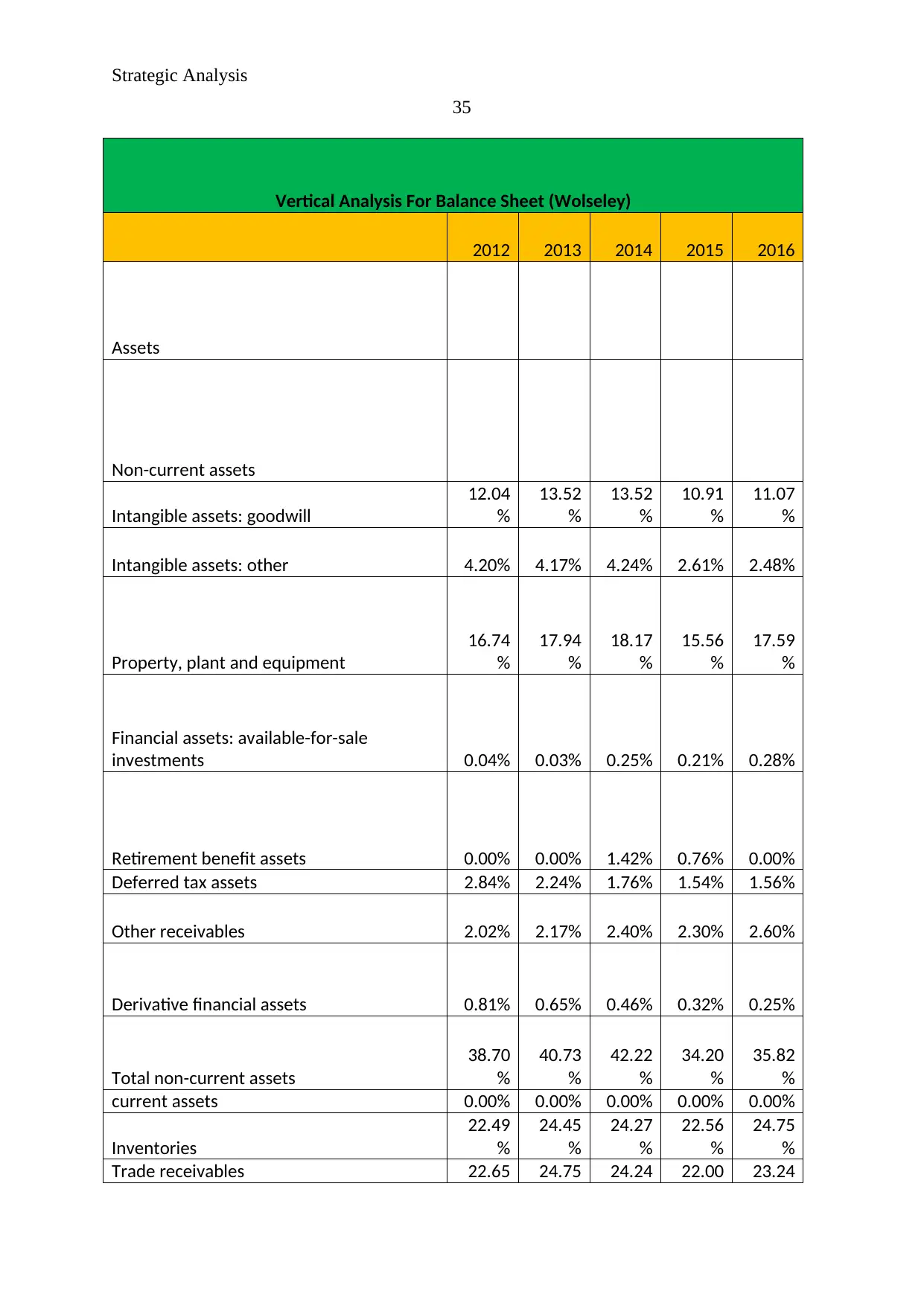
Strategic Analysis
35
Vertical Analysis For Balance Sheet (Wolseley)
2012 2013 2014 2015 2016
Assets
Non-current assets
Intangible assets: goodwill
12.04
%
13.52
%
13.52
%
10.91
%
11.07
%
Intangible assets: other 4.20% 4.17% 4.24% 2.61% 2.48%
Property, plant and equipment
16.74
%
17.94
%
18.17
%
15.56
%
17.59
%
Financial assets: available-for-sale
investments 0.04% 0.03% 0.25% 0.21% 0.28%
Retirement benefit assets 0.00% 0.00% 1.42% 0.76% 0.00%
Deferred tax assets 2.84% 2.24% 1.76% 1.54% 1.56%
Other receivables 2.02% 2.17% 2.40% 2.30% 2.60%
Derivative financial assets 0.81% 0.65% 0.46% 0.32% 0.25%
Total non-current assets
38.70
%
40.73
%
42.22
%
34.20
%
35.82
%
current assets 0.00% 0.00% 0.00% 0.00% 0.00%
Inventories
22.49
%
24.45
%
24.27
%
22.56
%
24.75
%
Trade receivables 22.65 24.75 24.24 22.00 23.24
35
Vertical Analysis For Balance Sheet (Wolseley)
2012 2013 2014 2015 2016
Assets
Non-current assets
Intangible assets: goodwill
12.04
%
13.52
%
13.52
%
10.91
%
11.07
%
Intangible assets: other 4.20% 4.17% 4.24% 2.61% 2.48%
Property, plant and equipment
16.74
%
17.94
%
18.17
%
15.56
%
17.59
%
Financial assets: available-for-sale
investments 0.04% 0.03% 0.25% 0.21% 0.28%
Retirement benefit assets 0.00% 0.00% 1.42% 0.76% 0.00%
Deferred tax assets 2.84% 2.24% 1.76% 1.54% 1.56%
Other receivables 2.02% 2.17% 2.40% 2.30% 2.60%
Derivative financial assets 0.81% 0.65% 0.46% 0.32% 0.25%
Total non-current assets
38.70
%
40.73
%
42.22
%
34.20
%
35.82
%
current assets 0.00% 0.00% 0.00% 0.00% 0.00%
Inventories
22.49
%
24.45
%
24.27
%
22.56
%
24.75
%
Trade receivables 22.65 24.75 24.24 22.00 23.24
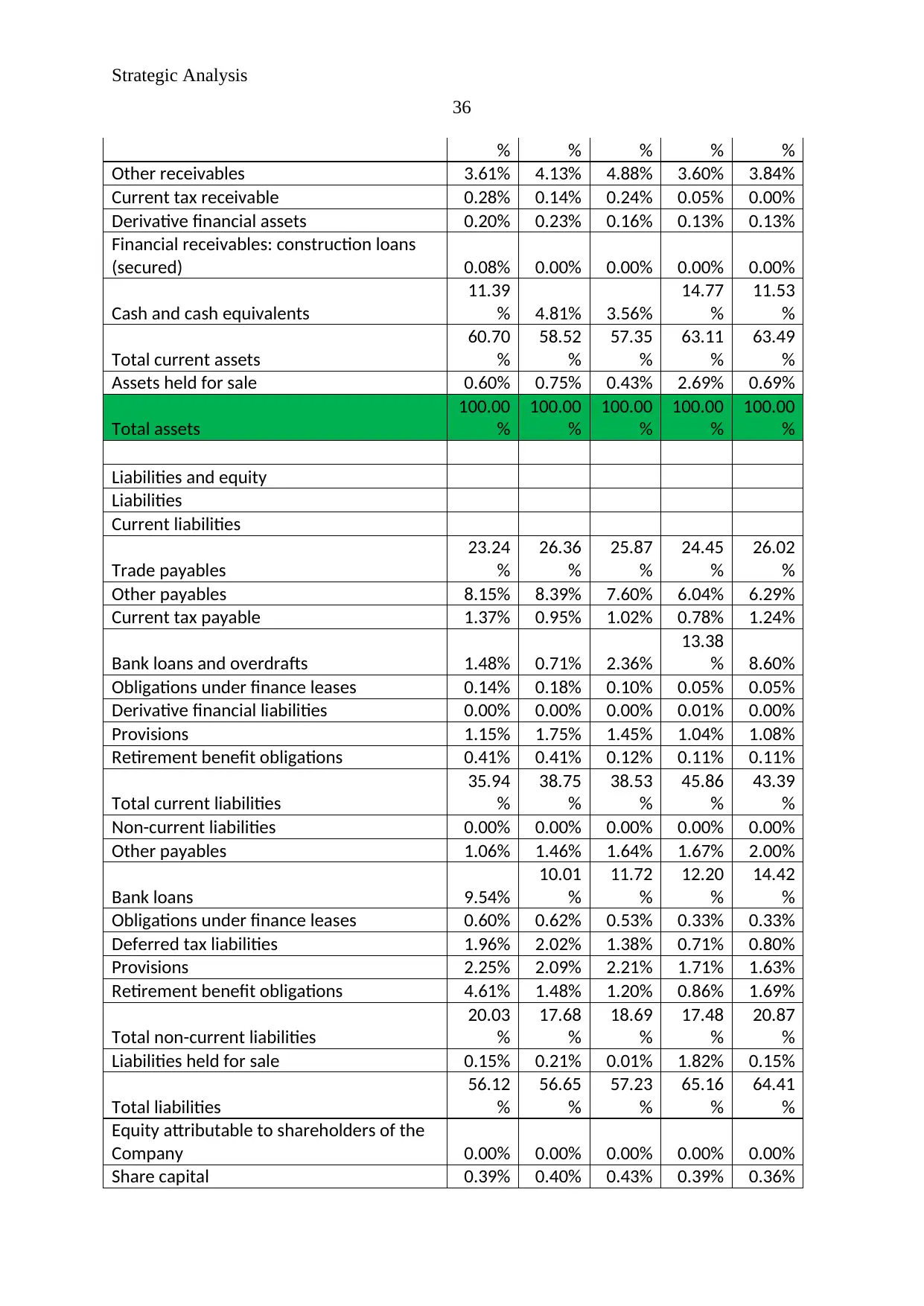
Strategic Analysis
36
% % % % %
Other receivables 3.61% 4.13% 4.88% 3.60% 3.84%
Current tax receivable 0.28% 0.14% 0.24% 0.05% 0.00%
Derivative financial assets 0.20% 0.23% 0.16% 0.13% 0.13%
Financial receivables: construction loans
(secured) 0.08% 0.00% 0.00% 0.00% 0.00%
Cash and cash equivalents
11.39
% 4.81% 3.56%
14.77
%
11.53
%
Total current assets
60.70
%
58.52
%
57.35
%
63.11
%
63.49
%
Assets held for sale 0.60% 0.75% 0.43% 2.69% 0.69%
Total assets
100.00
%
100.00
%
100.00
%
100.00
%
100.00
%
Liabilities and equity
Liabilities
Current liabilities
Trade payables
23.24
%
26.36
%
25.87
%
24.45
%
26.02
%
Other payables 8.15% 8.39% 7.60% 6.04% 6.29%
Current tax payable 1.37% 0.95% 1.02% 0.78% 1.24%
Bank loans and overdrafts 1.48% 0.71% 2.36%
13.38
% 8.60%
Obligations under finance leases 0.14% 0.18% 0.10% 0.05% 0.05%
Derivative financial liabilities 0.00% 0.00% 0.00% 0.01% 0.00%
Provisions 1.15% 1.75% 1.45% 1.04% 1.08%
Retirement benefit obligations 0.41% 0.41% 0.12% 0.11% 0.11%
Total current liabilities
35.94
%
38.75
%
38.53
%
45.86
%
43.39
%
Non-current liabilities 0.00% 0.00% 0.00% 0.00% 0.00%
Other payables 1.06% 1.46% 1.64% 1.67% 2.00%
Bank loans 9.54%
10.01
%
11.72
%
12.20
%
14.42
%
Obligations under finance leases 0.60% 0.62% 0.53% 0.33% 0.33%
Deferred tax liabilities 1.96% 2.02% 1.38% 0.71% 0.80%
Provisions 2.25% 2.09% 2.21% 1.71% 1.63%
Retirement benefit obligations 4.61% 1.48% 1.20% 0.86% 1.69%
Total non-current liabilities
20.03
%
17.68
%
18.69
%
17.48
%
20.87
%
Liabilities held for sale 0.15% 0.21% 0.01% 1.82% 0.15%
Total liabilities
56.12
%
56.65
%
57.23
%
65.16
%
64.41
%
Equity attributable to shareholders of the
Company 0.00% 0.00% 0.00% 0.00% 0.00%
Share capital 0.39% 0.40% 0.43% 0.39% 0.36%
36
% % % % %
Other receivables 3.61% 4.13% 4.88% 3.60% 3.84%
Current tax receivable 0.28% 0.14% 0.24% 0.05% 0.00%
Derivative financial assets 0.20% 0.23% 0.16% 0.13% 0.13%
Financial receivables: construction loans
(secured) 0.08% 0.00% 0.00% 0.00% 0.00%
Cash and cash equivalents
11.39
% 4.81% 3.56%
14.77
%
11.53
%
Total current assets
60.70
%
58.52
%
57.35
%
63.11
%
63.49
%
Assets held for sale 0.60% 0.75% 0.43% 2.69% 0.69%
Total assets
100.00
%
100.00
%
100.00
%
100.00
%
100.00
%
Liabilities and equity
Liabilities
Current liabilities
Trade payables
23.24
%
26.36
%
25.87
%
24.45
%
26.02
%
Other payables 8.15% 8.39% 7.60% 6.04% 6.29%
Current tax payable 1.37% 0.95% 1.02% 0.78% 1.24%
Bank loans and overdrafts 1.48% 0.71% 2.36%
13.38
% 8.60%
Obligations under finance leases 0.14% 0.18% 0.10% 0.05% 0.05%
Derivative financial liabilities 0.00% 0.00% 0.00% 0.01% 0.00%
Provisions 1.15% 1.75% 1.45% 1.04% 1.08%
Retirement benefit obligations 0.41% 0.41% 0.12% 0.11% 0.11%
Total current liabilities
35.94
%
38.75
%
38.53
%
45.86
%
43.39
%
Non-current liabilities 0.00% 0.00% 0.00% 0.00% 0.00%
Other payables 1.06% 1.46% 1.64% 1.67% 2.00%
Bank loans 9.54%
10.01
%
11.72
%
12.20
%
14.42
%
Obligations under finance leases 0.60% 0.62% 0.53% 0.33% 0.33%
Deferred tax liabilities 1.96% 2.02% 1.38% 0.71% 0.80%
Provisions 2.25% 2.09% 2.21% 1.71% 1.63%
Retirement benefit obligations 4.61% 1.48% 1.20% 0.86% 1.69%
Total non-current liabilities
20.03
%
17.68
%
18.69
%
17.48
%
20.87
%
Liabilities held for sale 0.15% 0.21% 0.01% 1.82% 0.15%
Total liabilities
56.12
%
56.65
%
57.23
%
65.16
%
64.41
%
Equity attributable to shareholders of the
Company 0.00% 0.00% 0.00% 0.00% 0.00%
Share capital 0.39% 0.40% 0.43% 0.39% 0.36%
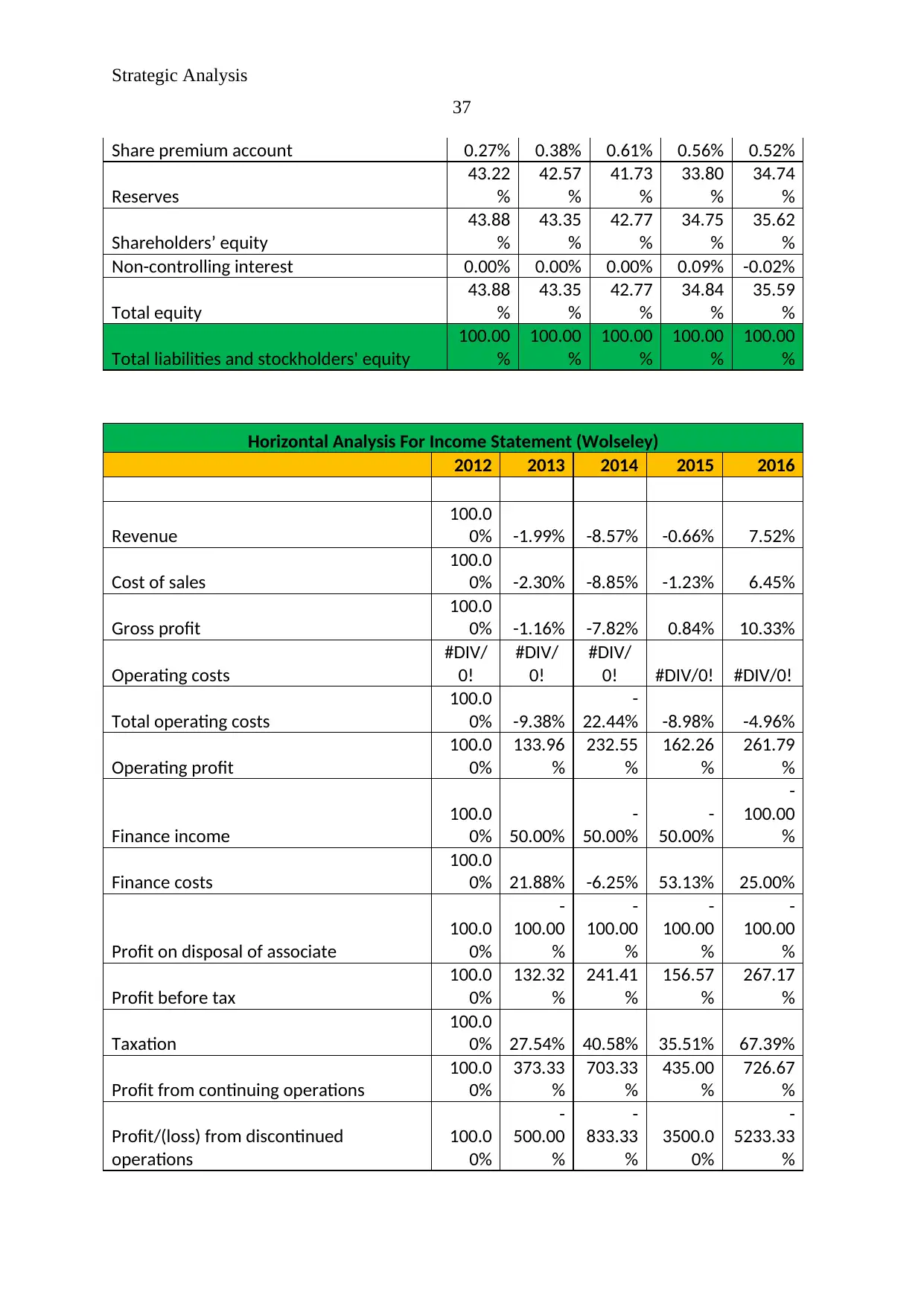
Strategic Analysis
37
Share premium account 0.27% 0.38% 0.61% 0.56% 0.52%
Reserves
43.22
%
42.57
%
41.73
%
33.80
%
34.74
%
Shareholders’ equity
43.88
%
43.35
%
42.77
%
34.75
%
35.62
%
Non-controlling interest 0.00% 0.00% 0.00% 0.09% -0.02%
Total equity
43.88
%
43.35
%
42.77
%
34.84
%
35.59
%
Total liabilities and stockholders' equity
100.00
%
100.00
%
100.00
%
100.00
%
100.00
%
Horizontal Analysis For Income Statement (Wolseley)
2012 2013 2014 2015 2016
Revenue
100.0
0% -1.99% -8.57% -0.66% 7.52%
Cost of sales
100.0
0% -2.30% -8.85% -1.23% 6.45%
Gross profit
100.0
0% -1.16% -7.82% 0.84% 10.33%
Operating costs
#DIV/
0!
#DIV/
0!
#DIV/
0! #DIV/0! #DIV/0!
Total operating costs
100.0
0% -9.38%
-
22.44% -8.98% -4.96%
Operating profit
100.0
0%
133.96
%
232.55
%
162.26
%
261.79
%
Finance income
100.0
0% 50.00%
-
50.00%
-
50.00%
-
100.00
%
Finance costs
100.0
0% 21.88% -6.25% 53.13% 25.00%
Profit on disposal of associate
100.0
0%
-
100.00
%
-
100.00
%
-
100.00
%
-
100.00
%
Profit before tax
100.0
0%
132.32
%
241.41
%
156.57
%
267.17
%
Taxation
100.0
0% 27.54% 40.58% 35.51% 67.39%
Profit from continuing operations
100.0
0%
373.33
%
703.33
%
435.00
%
726.67
%
Profit/(loss) from discontinued
operations
100.0
0%
-
500.00
%
-
833.33
%
3500.0
0%
-
5233.33
%
37
Share premium account 0.27% 0.38% 0.61% 0.56% 0.52%
Reserves
43.22
%
42.57
%
41.73
%
33.80
%
34.74
%
Shareholders’ equity
43.88
%
43.35
%
42.77
%
34.75
%
35.62
%
Non-controlling interest 0.00% 0.00% 0.00% 0.09% -0.02%
Total equity
43.88
%
43.35
%
42.77
%
34.84
%
35.59
%
Total liabilities and stockholders' equity
100.00
%
100.00
%
100.00
%
100.00
%
100.00
%
Horizontal Analysis For Income Statement (Wolseley)
2012 2013 2014 2015 2016
Revenue
100.0
0% -1.99% -8.57% -0.66% 7.52%
Cost of sales
100.0
0% -2.30% -8.85% -1.23% 6.45%
Gross profit
100.0
0% -1.16% -7.82% 0.84% 10.33%
Operating costs
#DIV/
0!
#DIV/
0!
#DIV/
0! #DIV/0! #DIV/0!
Total operating costs
100.0
0% -9.38%
-
22.44% -8.98% -4.96%
Operating profit
100.0
0%
133.96
%
232.55
%
162.26
%
261.79
%
Finance income
100.0
0% 50.00%
-
50.00%
-
50.00%
-
100.00
%
Finance costs
100.0
0% 21.88% -6.25% 53.13% 25.00%
Profit on disposal of associate
100.0
0%
-
100.00
%
-
100.00
%
-
100.00
%
-
100.00
%
Profit before tax
100.0
0%
132.32
%
241.41
%
156.57
%
267.17
%
Taxation
100.0
0% 27.54% 40.58% 35.51% 67.39%
Profit from continuing operations
100.0
0%
373.33
%
703.33
%
435.00
%
726.67
%
Profit/(loss) from discontinued
operations
100.0
0%
-
500.00
%
-
833.33
%
3500.0
0%
-
5233.33
%
Paraphrase This Document
Need a fresh take? Get an instant paraphrase of this document with our AI Paraphraser
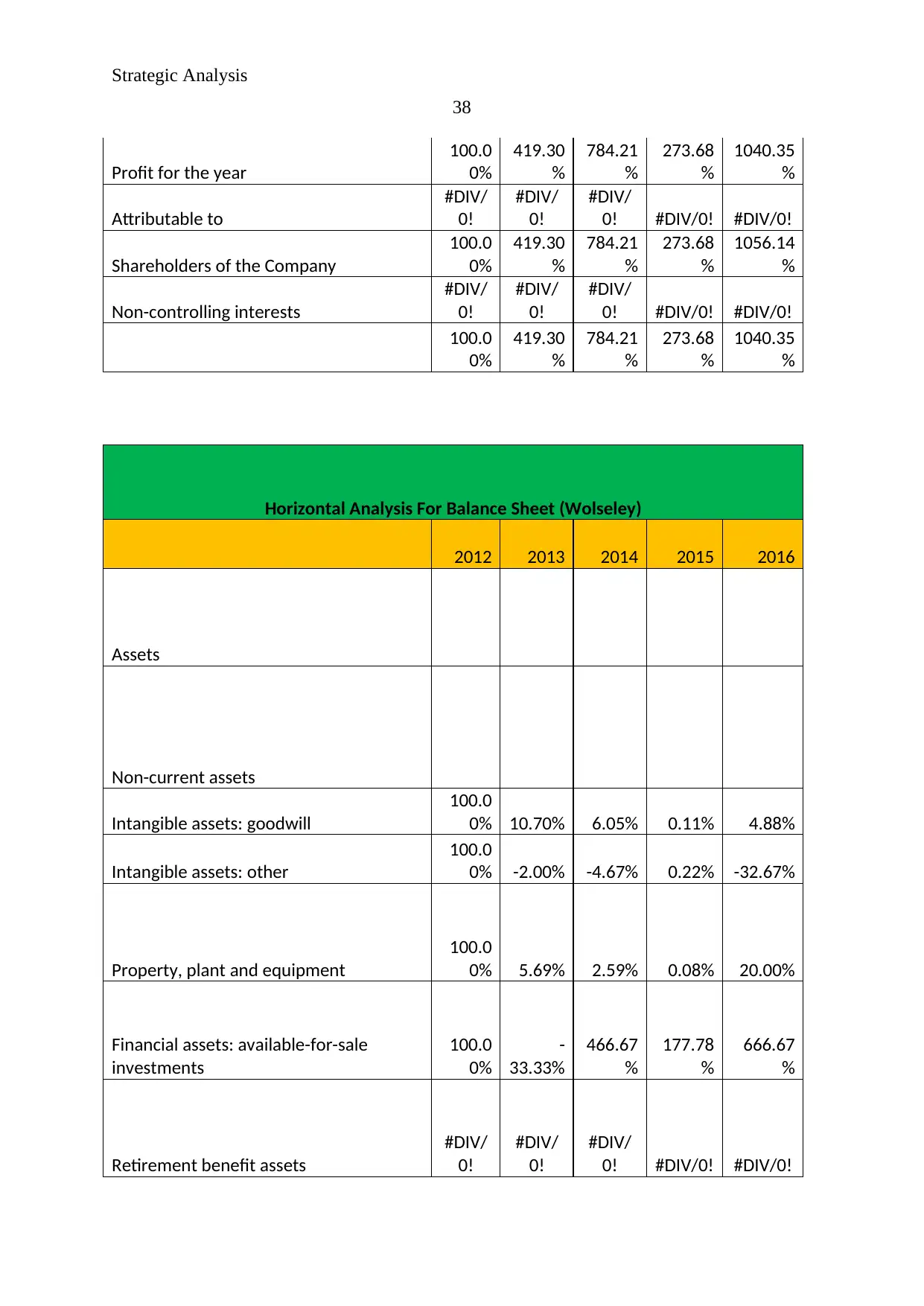
Strategic Analysis
38
Profit for the year
100.0
0%
419.30
%
784.21
%
273.68
%
1040.35
%
Attributable to
#DIV/
0!
#DIV/
0!
#DIV/
0! #DIV/0! #DIV/0!
Shareholders of the Company
100.0
0%
419.30
%
784.21
%
273.68
%
1056.14
%
Non-controlling interests
#DIV/
0!
#DIV/
0!
#DIV/
0! #DIV/0! #DIV/0!
100.0
0%
419.30
%
784.21
%
273.68
%
1040.35
%
Horizontal Analysis For Balance Sheet (Wolseley)
2012 2013 2014 2015 2016
Assets
Non-current assets
Intangible assets: goodwill
100.0
0% 10.70% 6.05% 0.11% 4.88%
Intangible assets: other
100.0
0% -2.00% -4.67% 0.22% -32.67%
Property, plant and equipment
100.0
0% 5.69% 2.59% 0.08% 20.00%
Financial assets: available-for-sale
investments
100.0
0%
-
33.33%
466.67
%
177.78
%
666.67
%
Retirement benefit assets
#DIV/
0!
#DIV/
0!
#DIV/
0! #DIV/0! #DIV/0!
38
Profit for the year
100.0
0%
419.30
%
784.21
%
273.68
%
1040.35
%
Attributable to
#DIV/
0!
#DIV/
0!
#DIV/
0! #DIV/0! #DIV/0!
Shareholders of the Company
100.0
0%
419.30
%
784.21
%
273.68
%
1056.14
%
Non-controlling interests
#DIV/
0!
#DIV/
0!
#DIV/
0! #DIV/0! #DIV/0!
100.0
0%
419.30
%
784.21
%
273.68
%
1040.35
%
Horizontal Analysis For Balance Sheet (Wolseley)
2012 2013 2014 2015 2016
Assets
Non-current assets
Intangible assets: goodwill
100.0
0% 10.70% 6.05% 0.11% 4.88%
Intangible assets: other
100.0
0% -2.00% -4.67% 0.22% -32.67%
Property, plant and equipment
100.0
0% 5.69% 2.59% 0.08% 20.00%
Financial assets: available-for-sale
investments
100.0
0%
-
33.33%
466.67
%
177.78
%
666.67
%
Retirement benefit assets
#DIV/
0!
#DIV/
0!
#DIV/
0! #DIV/0! #DIV/0!
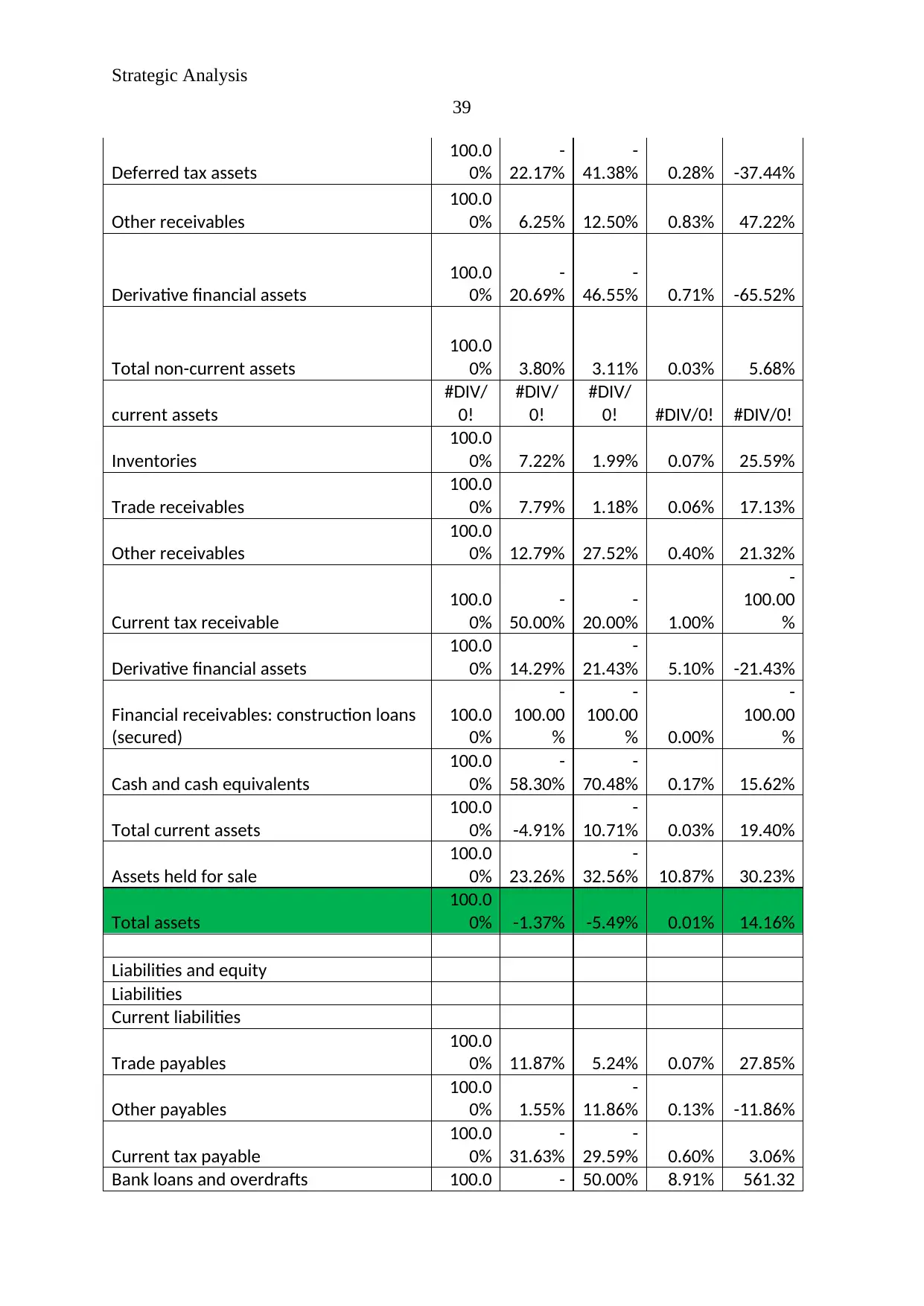
Strategic Analysis
39
Deferred tax assets
100.0
0%
-
22.17%
-
41.38% 0.28% -37.44%
Other receivables
100.0
0% 6.25% 12.50% 0.83% 47.22%
Derivative financial assets
100.0
0%
-
20.69%
-
46.55% 0.71% -65.52%
Total non-current assets
100.0
0% 3.80% 3.11% 0.03% 5.68%
current assets
#DIV/
0!
#DIV/
0!
#DIV/
0! #DIV/0! #DIV/0!
Inventories
100.0
0% 7.22% 1.99% 0.07% 25.59%
Trade receivables
100.0
0% 7.79% 1.18% 0.06% 17.13%
Other receivables
100.0
0% 12.79% 27.52% 0.40% 21.32%
Current tax receivable
100.0
0%
-
50.00%
-
20.00% 1.00%
-
100.00
%
Derivative financial assets
100.0
0% 14.29%
-
21.43% 5.10% -21.43%
Financial receivables: construction loans
(secured)
100.0
0%
-
100.00
%
-
100.00
% 0.00%
-
100.00
%
Cash and cash equivalents
100.0
0%
-
58.30%
-
70.48% 0.17% 15.62%
Total current assets
100.0
0% -4.91%
-
10.71% 0.03% 19.40%
Assets held for sale
100.0
0% 23.26%
-
32.56% 10.87% 30.23%
Total assets
100.0
0% -1.37% -5.49% 0.01% 14.16%
Liabilities and equity
Liabilities
Current liabilities
Trade payables
100.0
0% 11.87% 5.24% 0.07% 27.85%
Other payables
100.0
0% 1.55%
-
11.86% 0.13% -11.86%
Current tax payable
100.0
0%
-
31.63%
-
29.59% 0.60% 3.06%
Bank loans and overdrafts 100.0 - 50.00% 8.91% 561.32
39
Deferred tax assets
100.0
0%
-
22.17%
-
41.38% 0.28% -37.44%
Other receivables
100.0
0% 6.25% 12.50% 0.83% 47.22%
Derivative financial assets
100.0
0%
-
20.69%
-
46.55% 0.71% -65.52%
Total non-current assets
100.0
0% 3.80% 3.11% 0.03% 5.68%
current assets
#DIV/
0!
#DIV/
0!
#DIV/
0! #DIV/0! #DIV/0!
Inventories
100.0
0% 7.22% 1.99% 0.07% 25.59%
Trade receivables
100.0
0% 7.79% 1.18% 0.06% 17.13%
Other receivables
100.0
0% 12.79% 27.52% 0.40% 21.32%
Current tax receivable
100.0
0%
-
50.00%
-
20.00% 1.00%
-
100.00
%
Derivative financial assets
100.0
0% 14.29%
-
21.43% 5.10% -21.43%
Financial receivables: construction loans
(secured)
100.0
0%
-
100.00
%
-
100.00
% 0.00%
-
100.00
%
Cash and cash equivalents
100.0
0%
-
58.30%
-
70.48% 0.17% 15.62%
Total current assets
100.0
0% -4.91%
-
10.71% 0.03% 19.40%
Assets held for sale
100.0
0% 23.26%
-
32.56% 10.87% 30.23%
Total assets
100.0
0% -1.37% -5.49% 0.01% 14.16%
Liabilities and equity
Liabilities
Current liabilities
Trade payables
100.0
0% 11.87% 5.24% 0.07% 27.85%
Other payables
100.0
0% 1.55%
-
11.86% 0.13% -11.86%
Current tax payable
100.0
0%
-
31.63%
-
29.59% 0.60% 3.06%
Bank loans and overdrafts 100.0 - 50.00% 8.91% 561.32
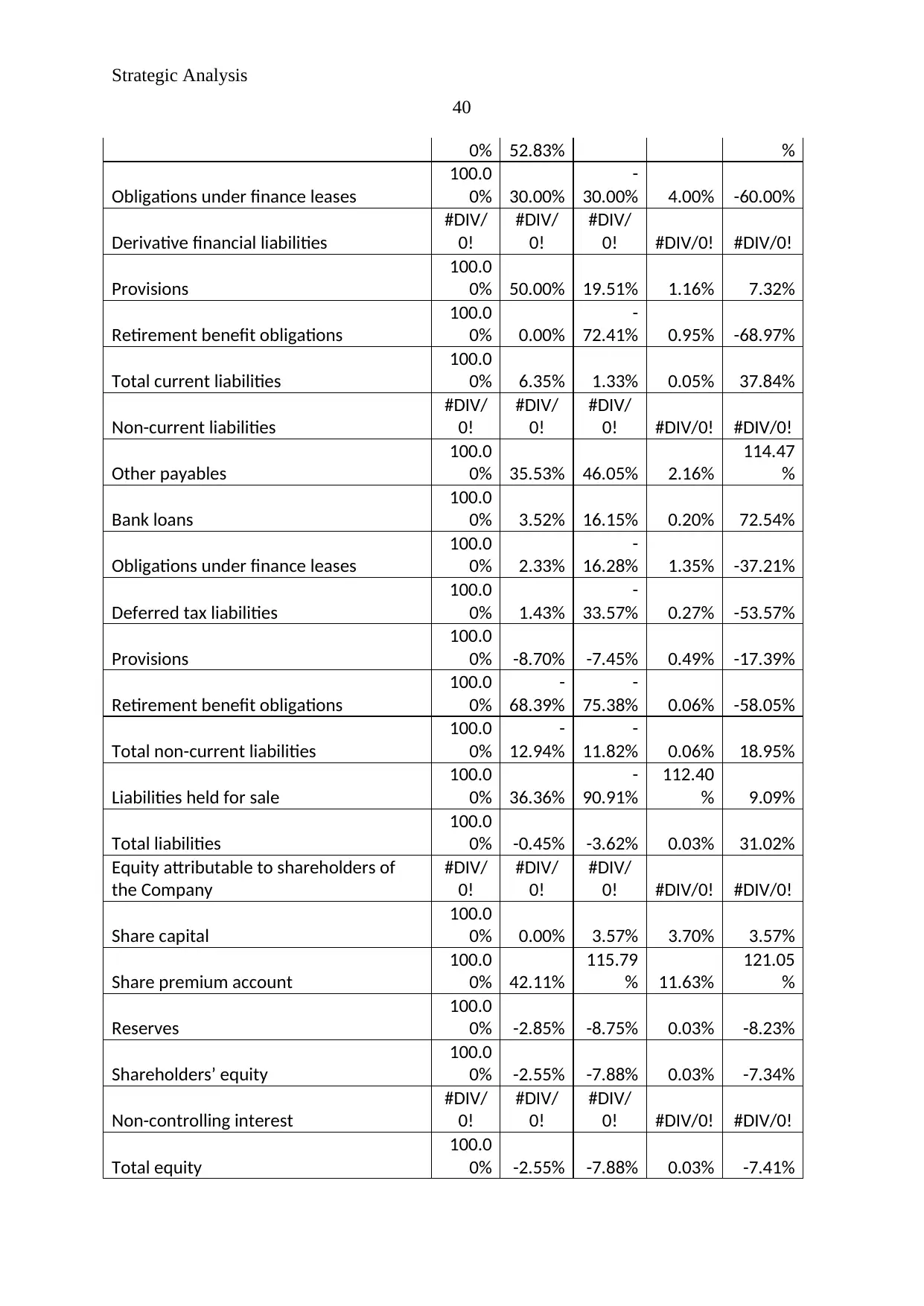
Strategic Analysis
40
0% 52.83% %
Obligations under finance leases
100.0
0% 30.00%
-
30.00% 4.00% -60.00%
Derivative financial liabilities
#DIV/
0!
#DIV/
0!
#DIV/
0! #DIV/0! #DIV/0!
Provisions
100.0
0% 50.00% 19.51% 1.16% 7.32%
Retirement benefit obligations
100.0
0% 0.00%
-
72.41% 0.95% -68.97%
Total current liabilities
100.0
0% 6.35% 1.33% 0.05% 37.84%
Non-current liabilities
#DIV/
0!
#DIV/
0!
#DIV/
0! #DIV/0! #DIV/0!
Other payables
100.0
0% 35.53% 46.05% 2.16%
114.47
%
Bank loans
100.0
0% 3.52% 16.15% 0.20% 72.54%
Obligations under finance leases
100.0
0% 2.33%
-
16.28% 1.35% -37.21%
Deferred tax liabilities
100.0
0% 1.43%
-
33.57% 0.27% -53.57%
Provisions
100.0
0% -8.70% -7.45% 0.49% -17.39%
Retirement benefit obligations
100.0
0%
-
68.39%
-
75.38% 0.06% -58.05%
Total non-current liabilities
100.0
0%
-
12.94%
-
11.82% 0.06% 18.95%
Liabilities held for sale
100.0
0% 36.36%
-
90.91%
112.40
% 9.09%
Total liabilities
100.0
0% -0.45% -3.62% 0.03% 31.02%
Equity attributable to shareholders of
the Company
#DIV/
0!
#DIV/
0!
#DIV/
0! #DIV/0! #DIV/0!
Share capital
100.0
0% 0.00% 3.57% 3.70% 3.57%
Share premium account
100.0
0% 42.11%
115.79
% 11.63%
121.05
%
Reserves
100.0
0% -2.85% -8.75% 0.03% -8.23%
Shareholders’ equity
100.0
0% -2.55% -7.88% 0.03% -7.34%
Non-controlling interest
#DIV/
0!
#DIV/
0!
#DIV/
0! #DIV/0! #DIV/0!
Total equity
100.0
0% -2.55% -7.88% 0.03% -7.41%
40
0% 52.83% %
Obligations under finance leases
100.0
0% 30.00%
-
30.00% 4.00% -60.00%
Derivative financial liabilities
#DIV/
0!
#DIV/
0!
#DIV/
0! #DIV/0! #DIV/0!
Provisions
100.0
0% 50.00% 19.51% 1.16% 7.32%
Retirement benefit obligations
100.0
0% 0.00%
-
72.41% 0.95% -68.97%
Total current liabilities
100.0
0% 6.35% 1.33% 0.05% 37.84%
Non-current liabilities
#DIV/
0!
#DIV/
0!
#DIV/
0! #DIV/0! #DIV/0!
Other payables
100.0
0% 35.53% 46.05% 2.16%
114.47
%
Bank loans
100.0
0% 3.52% 16.15% 0.20% 72.54%
Obligations under finance leases
100.0
0% 2.33%
-
16.28% 1.35% -37.21%
Deferred tax liabilities
100.0
0% 1.43%
-
33.57% 0.27% -53.57%
Provisions
100.0
0% -8.70% -7.45% 0.49% -17.39%
Retirement benefit obligations
100.0
0%
-
68.39%
-
75.38% 0.06% -58.05%
Total non-current liabilities
100.0
0%
-
12.94%
-
11.82% 0.06% 18.95%
Liabilities held for sale
100.0
0% 36.36%
-
90.91%
112.40
% 9.09%
Total liabilities
100.0
0% -0.45% -3.62% 0.03% 31.02%
Equity attributable to shareholders of
the Company
#DIV/
0!
#DIV/
0!
#DIV/
0! #DIV/0! #DIV/0!
Share capital
100.0
0% 0.00% 3.57% 3.70% 3.57%
Share premium account
100.0
0% 42.11%
115.79
% 11.63%
121.05
%
Reserves
100.0
0% -2.85% -8.75% 0.03% -8.23%
Shareholders’ equity
100.0
0% -2.55% -7.88% 0.03% -7.34%
Non-controlling interest
#DIV/
0!
#DIV/
0!
#DIV/
0! #DIV/0! #DIV/0!
Total equity
100.0
0% -2.55% -7.88% 0.03% -7.41%
Secure Best Marks with AI Grader
Need help grading? Try our AI Grader for instant feedback on your assignments.
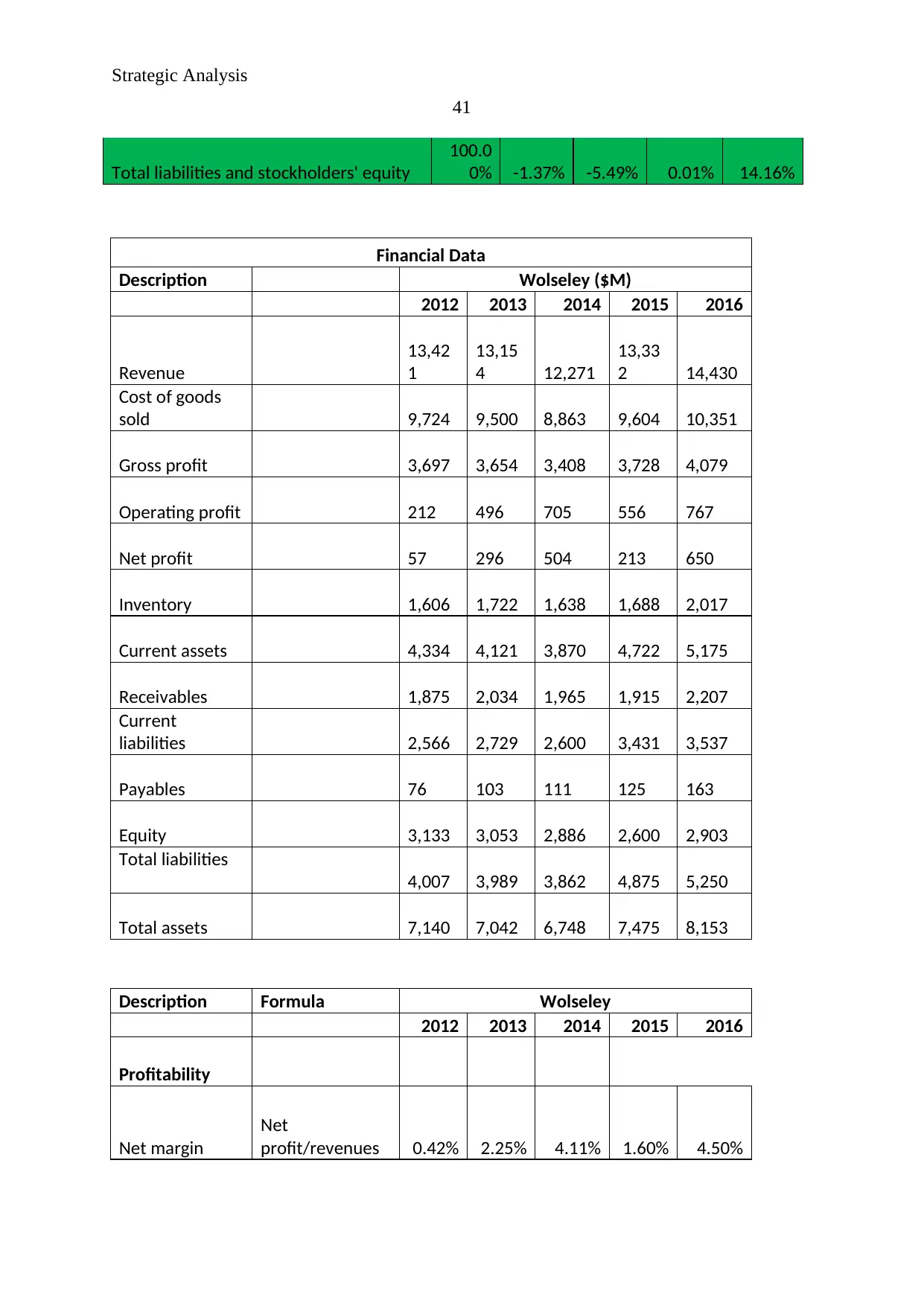
Strategic Analysis
41
Total liabilities and stockholders' equity
100.0
0% -1.37% -5.49% 0.01% 14.16%
Financial Data
Description Wolseley ($M)
2012 2013 2014 2015 2016
Revenue
13,42
1
13,15
4 12,271
13,33
2 14,430
Cost of goods
sold 9,724 9,500 8,863 9,604 10,351
Gross profit 3,697 3,654 3,408 3,728 4,079
Operating profit 212 496 705 556 767
Net profit 57 296 504 213 650
Inventory 1,606 1,722 1,638 1,688 2,017
Current assets 4,334 4,121 3,870 4,722 5,175
Receivables 1,875 2,034 1,965 1,915 2,207
Current
liabilities 2,566 2,729 2,600 3,431 3,537
Payables 76 103 111 125 163
Equity 3,133 3,053 2,886 2,600 2,903
Total liabilities
4,007 3,989 3,862 4,875 5,250
Total assets 7,140 7,042 6,748 7,475 8,153
Description Formula Wolseley
2012 2013 2014 2015 2016
Profitability
Net margin
Net
profit/revenues 0.42% 2.25% 4.11% 1.60% 4.50%
41
Total liabilities and stockholders' equity
100.0
0% -1.37% -5.49% 0.01% 14.16%
Financial Data
Description Wolseley ($M)
2012 2013 2014 2015 2016
Revenue
13,42
1
13,15
4 12,271
13,33
2 14,430
Cost of goods
sold 9,724 9,500 8,863 9,604 10,351
Gross profit 3,697 3,654 3,408 3,728 4,079
Operating profit 212 496 705 556 767
Net profit 57 296 504 213 650
Inventory 1,606 1,722 1,638 1,688 2,017
Current assets 4,334 4,121 3,870 4,722 5,175
Receivables 1,875 2,034 1,965 1,915 2,207
Current
liabilities 2,566 2,729 2,600 3,431 3,537
Payables 76 103 111 125 163
Equity 3,133 3,053 2,886 2,600 2,903
Total liabilities
4,007 3,989 3,862 4,875 5,250
Total assets 7,140 7,042 6,748 7,475 8,153
Description Formula Wolseley
2012 2013 2014 2015 2016
Profitability
Net margin
Net
profit/revenues 0.42% 2.25% 4.11% 1.60% 4.50%
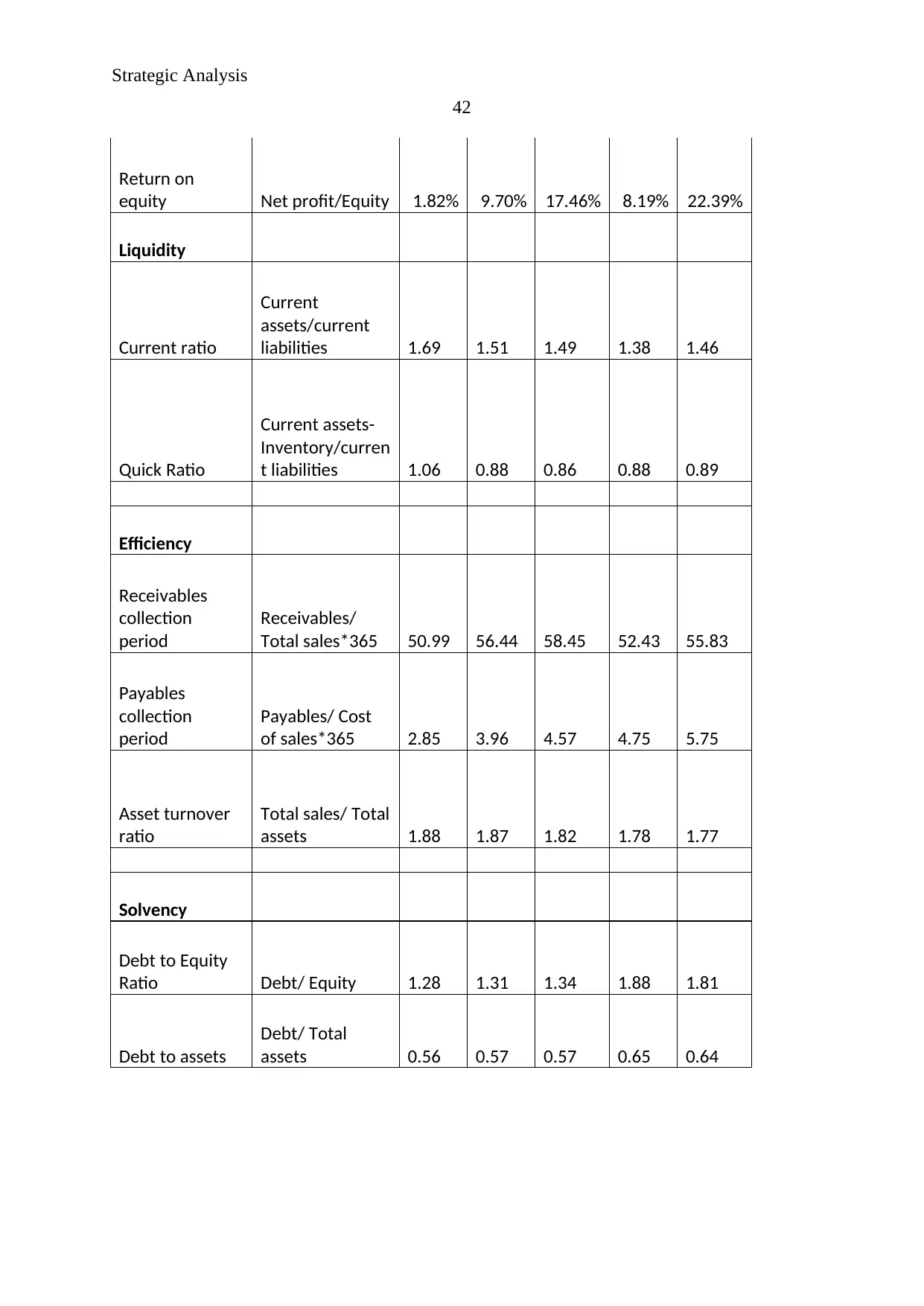
Strategic Analysis
42
Return on
equity Net profit/Equity 1.82% 9.70% 17.46% 8.19% 22.39%
Liquidity
Current ratio
Current
assets/current
liabilities 1.69 1.51 1.49 1.38 1.46
Quick Ratio
Current assets-
Inventory/curren
t liabilities 1.06 0.88 0.86 0.88 0.89
Efficiency
Receivables
collection
period
Receivables/
Total sales*365 50.99 56.44 58.45 52.43 55.83
Payables
collection
period
Payables/ Cost
of sales*365 2.85 3.96 4.57 4.75 5.75
Asset turnover
ratio
Total sales/ Total
assets 1.88 1.87 1.82 1.78 1.77
Solvency
Debt to Equity
Ratio Debt/ Equity 1.28 1.31 1.34 1.88 1.81
Debt to assets
Debt/ Total
assets 0.56 0.57 0.57 0.65 0.64
42
Return on
equity Net profit/Equity 1.82% 9.70% 17.46% 8.19% 22.39%
Liquidity
Current ratio
Current
assets/current
liabilities 1.69 1.51 1.49 1.38 1.46
Quick Ratio
Current assets-
Inventory/curren
t liabilities 1.06 0.88 0.86 0.88 0.89
Efficiency
Receivables
collection
period
Receivables/
Total sales*365 50.99 56.44 58.45 52.43 55.83
Payables
collection
period
Payables/ Cost
of sales*365 2.85 3.96 4.57 4.75 5.75
Asset turnover
ratio
Total sales/ Total
assets 1.88 1.87 1.82 1.78 1.77
Solvency
Debt to Equity
Ratio Debt/ Equity 1.28 1.31 1.34 1.88 1.81
Debt to assets
Debt/ Total
assets 0.56 0.57 0.57 0.65 0.64
1 out of 42
Related Documents
Your All-in-One AI-Powered Toolkit for Academic Success.
+13062052269
info@desklib.com
Available 24*7 on WhatsApp / Email
![[object Object]](/_next/static/media/star-bottom.7253800d.svg)
Unlock your academic potential
© 2024 | Zucol Services PVT LTD | All rights reserved.





